1
Cover Image
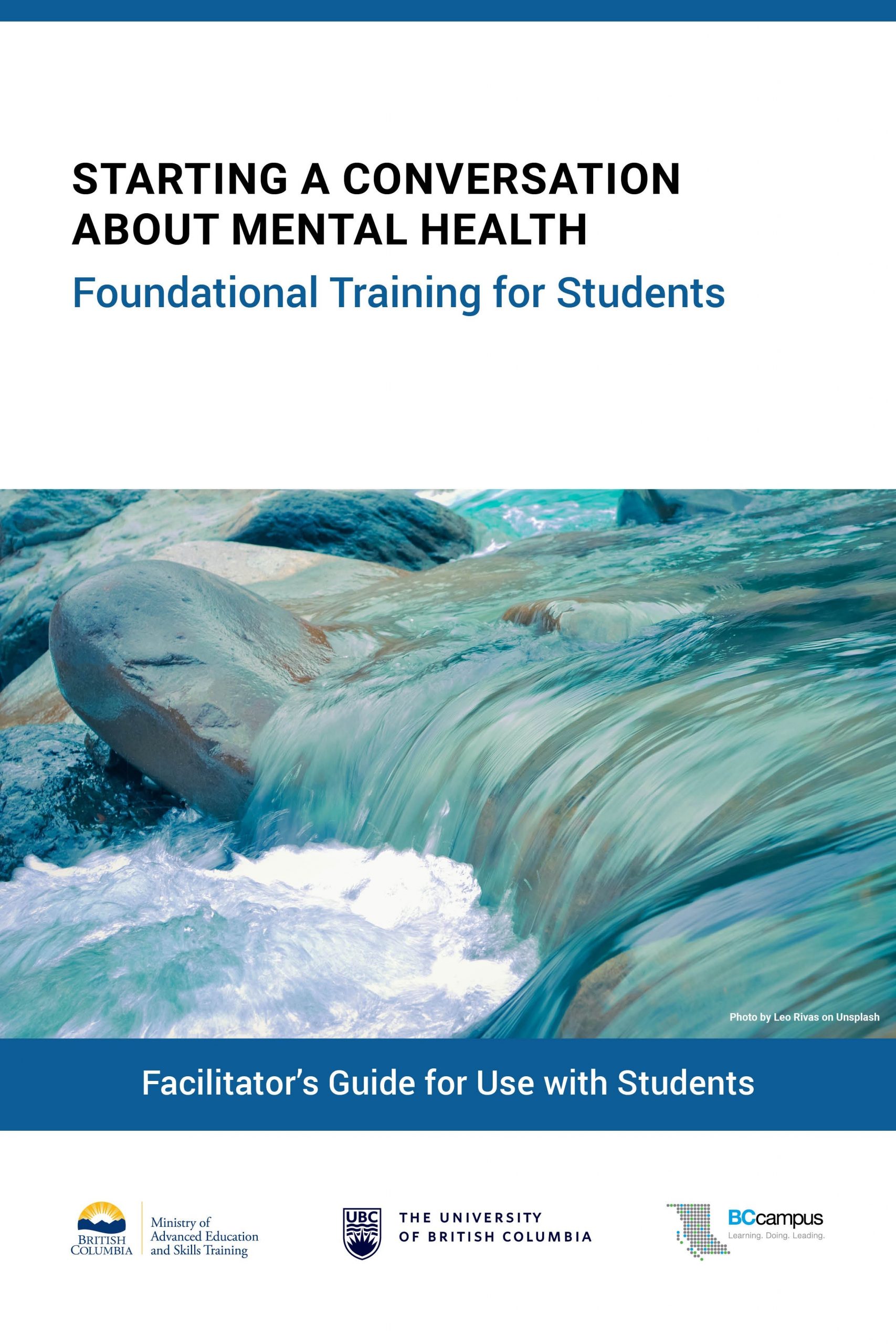

Starting A Conversation About Mental Health: Foundational Training for Students by UBC Student Health and Wellbeing Staff; Jewell Gillies; Barbara Johnston; Liz Warwick; Dagmar Devine; Jenny Guild; Arica Hsu; Hamza Islam; Mehakpreet Kaur; Malena Mokhovikova; Jackson Mackenzie Nicholls; and Calla Smith is licensed under a Creative Commons Attribution 4.0 International License, except where otherwise noted.
Starting A Conversation About Mental Health: Foundational Training for Students was adapted from Mental Health Literacy for Student Leaders © UBC Student Health and Wellbeing staff over the years. It was shared under a Memorandum of Understanding with BCcampus to be adapted as an open education resource (OER).
The Creative Commons license permits you to retain, reuse, copy, redistribute, and revise this book — in whole or in part — for free providing the author is attributed as follows:
If you redistribute all or part of this book, it is recommended the following statement be added to the copyright page so readers can access the original book at no cost:
Sample APA-style citation:
This resource can be referenced in APA citation style (7th edition), as follows:
Cover image attribution:
Ebook ISBN: 978-1-77420-142-8
Print ISBN: 978-1-77420-141-1
This resource is a result of the BCcampus Mental Health and Wellness Project funded by the Ministry of Advanced Education and Skills Training (AEST).
Starting a Conversation about Mental Health: Foundational Training for Students includes a Facilitator’s Guide, an accompanying PowerPoint slide deck, and handouts to share with participants. You can download the slides here: BCcampus Starting a Conversation about Mental Health [PPTX].
There are also handouts available for download:
There are also two videos you may want to bookmark (and have ready to play in a browser) prior to offering the session:
Starting a Conversation about Mental Health: Foundational Training for Students was developed as part of BCcampus’s Mental Health and Wellness Projects to provide open access resources to increase awareness of mental health and support post-secondary students.
This project was developed with funding from the Ministry of Advanced Education and Skills Training and guidance from an Advisory Group of students, staff, and faculty from B.C. post-secondary institutions. This is one of a series of open education resources on mental health available for the B.C. post-secondary sector.
This training resource is for facilitators presenting a two- to three-hour synchronous session to students at post-secondary institutions.. The training can be offered in person or online, and we invite you to augment the training with your own stories, models, and examples.
The resource includes three components:
Facilitator Guide. This guide includes presentation notes, activities, and scenarios to help you deliver the training. You may want to download the guide to a PDF file prior to giving a session. The guide also has a Getting Ready section with suggestions for preparing, adapting, and modifying the training.
Slide Deck. The Facilitator’s Guide has an accompanying PowerPoint slide deck that you can download from the link at the top of this page. The slides can be formatted to meet your institution’s guidelines or slide deck templates. You may want to add slides or that include the contact information of counselling services, campus helplines, Indigenous student centres, and other services on your campus that support students.
Handouts. The guide also includes handouts that you can share with participants. You may want to format these handouts according to your institution’s guidelines (e.g., colours, fonts, logos). You may also adapt the information in them to reflect the needs and concerns of the group you are addressing.
For a breakdown of the session, see the Detailed Agenda. This agenda assumes that you will offer this training over 2 hours; however, you may want more time and could extend the session to 2.5 or even 3 hours to allow more time for discussion and to give students lots of time to work through the scenarios at the end. Some facilitators may want to offer the training over two sessions. While the training is adaptable, we recommend that you include the sections on Indigenous perspectives on wellness, diversity, and marginalized groups, as it is important to maintain the integrity and diversity of voice in this guide.
Starting a Conversation about Mental Health: Foundational Training for Students is an open educational resource and licensed under a Creative Commons Attribution 4.0 International License, unless otherwise indicated. This means you may retain, reuse, revise, remix, and redistribute this resource without permission. If you revise or remix the resource, it is important to include the copyright holder of the original resource and the authors of this adapted version.
Starting a Conversation about Mental Health: Foundational Training for Students is licensed under a Creative Commons Attribution 4.0 International License, except where otherwise noted.
For post-secondary students, life is often filled with change, uncertainty, and challenges. Many students are living away from home for the first time and are learning to balance very busy academic schedules with managing finances, building their social circles, and figuring out their interests and future careers. The stress of post-secondary education is felt by all students at some point, and it can be overwhelming for some.
When the National College Health Assessment surveyed Canadian students in 2019, they found that students’ academic performance had been adversely affected by stress (42%), anxiety (35%), sleep difficulties (29%), and depression (24%) within the past 12 months. The same study found that 16% of students had seriously considered suicide over the prior year at least once. People in their late teens and early 20s are also at the highest risk of all age groups for mental illness; in these years, first episodes of psychiatric disorders like major depression are most likely to appear.
Post-secondary institutions are looking at different ways to support students. One strategy is to provide students with training in mental health and wellness to increase awareness and understanding of mental health. Starting a Conversation about Mental Health: Foundational Training for Students provides foundational knowledge on mental health for post-secondary students. We all have a role to play in our own mental health and supporting others’ mental health. By learning how to use mental health language accurately and talking openly about mental health, we can reduce the stigma that is still associated with mental health and mental illness. Students will learn about the stress response and how to manage everyday stresses. They will also learn how they can support other students who are struggling with stress and how they can be a role model for coping with stress and maintaining good mental health.
Many of the students who are interested in this training will be in leadership roles (resident assistants, peer group leaders, and teaching assistants), but the session is intended for any student who is interested in learning more about mental health and working to build an inclusive and resilient community at their post-secondary institution.
The web version of Starting A Conversation About Mental Health: Foundational Training for Students has been designed with accessibility in mind by incorporating the following features:
In addition to the web version, this book is available in a number of file formats including PDF, EPUB (for e-readers), MOBI (for Kindles), and various editable files. Here is a link to where you can download the guide in another format. Look for the “Download this book” drop-down menu to select the file type you want.
Those using a print copy of this resource can find the URLs for any websites mentioned in this resource in the footnotes.
While we strive to ensure that this resource is as accessible and usable as possible, we might not always get it right. Any issues we identify will be listed below.
There are currently no known issues.
The web version of this resource has been designed to meet Web Content Accessibility Guidelines 2.0, level AA. In addition, it follows all guidelines in Accessibility Toolkit (2nd ed.), Appendix A: Checklist for Accessibility (https://opentextbc.ca/accessibilitytoolkit/back-matter/appendix-checklist-for-accessibility-toolkit/). The development of this toolkit involved working with students with various print disabilities who provided their personal perspectives and helped test the content.
We gratefully acknowledge that this facilitator’s guide and the associated presentation have been adapted from the University of British Columbia’s training, Mental Health Literacy for Student Leaders, by University of British Columbia (UBC) Student Health and Wellbeing staff. While we don’t have the names of all the authors who contributed to the UBC training over the years, we would like to thank those people who worked with BCcampus on this newly adapted version: Tam Uden, Freeman Woolnough, Karen Moss, Kelly White, Patty Hambler, and Levonne Abshire.
A thank you is extended to the B.C. Ministry of Advanced Education and Skills Training for its support, to BCcampus for its collaborative leadership, to the Mental Health and Wellness Advisory Group, and to the adaptation authors and collaborators whose knowledge and expertise informed this adapted version.
We would also like to thank Matty Hillman for piloting this workshop with students in summer 2021, and the eight post-secondary students from around the province who participated in the training, wrote scenarios, and offered feedback. See Appendix 6 for the list of authors, contributors, and advisory group members.
The development team and authors who worked on this resource are dispersed throughout British Columbia and Canada, and they wish to acknowledge the following traditional, ancestral, and unceded territories from where they live and work: Algonquin Anishinabeg Territory in Ottawa, Ontario; xʷməθkwəy̓əm (Musqueam), Skwxwú7mesh (Squamish), and Səl̓ílwətaʔ/Selilwitulh (Tsleil-Waututh) territories in Vancouver, B.C.; Syilx Okanagan Territory in Kelowna, B.C.; Lək̓ʷəŋən (Lekwungen)/Songhees territories in Victoria, B.C.; and the Kʷikʷəƛ̓əm (Kwikwetlem), xʷməθkwəy̓əm (Musqueam), Skwxwú7mesh (Squamish), Stó:lō and Səl̓ílwətaʔ/Selilwitulh (Tsleil-Waututh) Nations in Port Moody, B.C. We honour the knowledge of the peoples of these territories.
To download the PowerPoint slide deck and handouts that accompany this Facilitator’s Guide, please see the Introduction.
This training opens up the conversation about mental health to increase understanding and reduce negative stigma surrounding mental illness. Key learning points of the training include the following:
To prepare to facilitate this workshop, consider the following:
You will need the following:
If your video-conferencing software allows you to create breakout rooms, you can have people work together in smaller groups. Take some time before the session to get comfortable with the breakout room set-up process. It can be helpful to have someone assist you with setting up the breakout rooms, so you can facilitate the session while they handle the technical issues.
Breakout rooms will work well for discussing the scenarios, but you will want to do some advance preparation. It may be easiest to put the scenarios in the chat, so have the scenarios ready to add to the chat prior to the session. During the session, you can then assign each group to a specific breakout room to discuss the different scenarios. Alternatively, you could move people into breakout rooms and then visit each room to verbally provide a scenario to each group.
Developing and delivering training on mental health can be an opportunity to build on existing work at your institution toward Indigenization, decolonization, and reconciliation.
Acknowledging the Indigenous Peoples on whose traditional lands you live, work, and study is an important way to begin an event or meeting and can be included as part of classroom activities and taught to students. Meaningful territory acknowledgements allow you to develop a closer and deeper relationship with not only the land but the traditional stewards and peoples whose territory you reside, work, live, and prosper in. For more information on giving a territory acknowledgement, see Opening the Session.
The Truth and Reconciliation Commission’s Calls to Action explicitly state that each of us as members of Canadian society have a direct responsibility to contribute to reconciliation; how we discuss colonization in relation to mental health is a direct response to that responsibility.
The United Nations Declaration on the Rights of Indigenous Peoples (UNDRIP) is an international instrument adopted by the United Nations on September 13, 2007, to enshrine (according to Article 43) the rights that “constitute the minimum standards for the survival, dignity and well-being of the indigenous peoples of the world.” UNDRIP was adopted by the government of British Columbia on November 26, 2019. Centring the history of colonization as a background to and framework for mental health is in direct response to our legal and moral obligation as members of Canadian society.
Indigenization is a process of naturalizing and valuing Indigenous knowledge systems. In the context of post-secondary institutions, this involves bringing Indigenous knowledge and approaches together with Western knowledge systems. This benefits not only Indigenous learners but all students, staff, faculty, and campus community members involved in or impacted by Indigenization.
As you adapt this training for your particular context, consider how and in what ways you might interweave Indigenous content and approaches. Here are some examples of how you might include an understanding of Indigenous ways of knowing and being:
As you do this work, as an Indigenous or non-Indigenous person, you will want to continue to draw upon and build on existing relationships with Indigenous people, both within and outside of your institution. As a way of continuing to work in intentional and respectful ways, you may want to reflect on questions such as these:
Elders have always been the foundation for emotional, social, intellectual, physical, and spiritual guidance for Indigenous communities. As you find ways to naturalize Indigenous context, perspectives, and traditional ways of being in your training, we recommend that you consider inviting an Elder or Knowledge Keeper from your local community to support your sessions. One way of doing this is to speak with Indigenous student services staff at your institution, share with them some of the recommendations in this guide, and see how they might wish to support this work.
Not all institutions will have an Elder in Residence, but each should have ways for you to contract an Elder or Knowledge Keeper to come in and support your work. Elders and Knowledge Keepers often support the whole post-secondary institution community, not just the Indigenous students. Involving Elders and Knowledge Keepers can help support reconciliation by helping to build respectful, reciprocal relationships that are deep and meaningful.
Whenever you plan to bring in a community member, Elder, or Knowledge Keeper, it is important to plan for the honorarium required to remunerate them for their time and for sharing their wisdom and traditional teachings. In many communities, it is seen as most respectful to offer payment on par with what you would pay a Ph.D. holder to do a keynote presentation. However, consulting with the Indigenous services staff at your institution on what is a typical amount for this type of event is also a good practice.
Participants need to feel comfortable, safe, and respected during the training. We discuss several strategies for helping to create a positive learning space. As you prepare to facilitate, you will want to consider factors such as when and where to hold the session, key messages on promotional materials, whether to use group guidelines, how to ensure diverse representation, and ways of working with co-facilitators or guests. If possible, having a co-facilitator or someone to assist you during the presentation can be very helpful. If a student is triggered and needs to leave the session, a co-facilitator or helper can follow up with the student.
Facilitators have an enormous role to play in setting the tone for a session. As people enter the space (online or in person), you can welcome them and help them get oriented. You can let them know if you’ve started or whether you’re waiting for a few more people and share housekeeping information, such as where the bathrooms are, where they can put their things, or how to use online interactive features. You may want to consider using a breathing exercise together or an icebreaker activity to help put people at ease. As you begin the session, you can use opening questions that help create inclusivity, such as correct pronouns, check-in questions, or information about accessibility needs and requests.
It is important to hold space in a session for people’s feelings and experiences – shared or not. However, boundaries are also needed to enable the training to move forward and be completed within the stated time frame.
It is important to establish at the beginning that the training is a learning space and not a counselling session. (You may also want to send an email to all participants with this message prior to the session.) If a participant is starting to take over the discussion with their personal experiences, you can gently redirect the conversation back to the material that you need to cover. It is a good idea to stay after the session is over to talk to any participants one-on-one.
It’s also important to provide a clear scope to reassure participants who worry that they must “save” a student who is in distress. Emphasize that students are not expected to be counsellors or “fix” a student who’s experiencing mental health problems.
This session does not include content on suicide, which is a very serious issue that requires more in-depth training. This training also doesn’t focus on how to recognize and support a student struggling with substance abuse and addiction. Substance abuse and mental health are closely linked, but this topic is beyond the scope of this foundational training.
Participants who have concerns about a student who is suicidal or abusing substances should consult a counsellor – or call 911 if it’s an emergency. The “Helping Other Students” section of the guide provides information on how to refer another student to campus and community resources.
It can be helpful to ask participants to agree to a list of guidelines or a code of conduct when they register or sign up for the training. You can either send the group guidelines to participants before the session or you can take some time at the beginning of the session to establish the guidelines together.
Or, you might share a list of guidelines at the beginning of the session and ask participants if they feel comfortable with them or if they have something they would like to add or change.
Group guidelines can be an important tool for supporting safer discussion about difficult topics. You can remind participants of the guidelines if the discussion is getting difficult. Important group agreements relate to listening to and showing respect for others (e.g., not talking when others are speaking, not making rude comments, not talking on the phone), confidentiality, and participation.
Group guidelines come in all shapes and sizes. Some groups have a few guidelines, while others have many. Here are some suggestions for possible guidelines:
Content warnings (also called trigger warnings) are statements made prior to sharing potentially difficult or challenging material. The intent of content warnings is to provide learners with the opportunity to prepare themselves emotionally for engaging with the topic or to make a choice to not participate.
Different departments and institutions will have different approaches to content warnings, and this may guide your decision about including content warnings on registration or sign-up forms, in learning materials, and in the learning environment. Here is an example of a content warning:
We will be discussing topics related to mental health in this training. During the training, you can choose not to participate in certain activities or discussion and can leave the session at any time. If you feel upset or overwhelmed, please know that there are resources to support you.
There are a number of other facilitation strategies you may want to consider in addition to or instead of a content warning:
Some participants may have direct experience with someone close to them who has a mental illness or has taken their own life. There are a number of strategies you can use to help create a trauma-aware learning space.
Before you start facilitating in this area, ensure that you are knowledgeable about receiving disclosures and about available supports and resources on campus and in the community. Some institutions have developed practices such as expedited counselling for participants who might need support after a training session or making intensive crisis supports available for a short time after a training or particular initiative.
At the beginning of the sessions, let participants know that they have the right and freedom to take care of themselves in a way that works for them. In particular, let participants know that they can leave the room or choose not to participate in an activity. You could say something like “If at any time you feel you need to leave, that’s fine with me. You are empowered to take care of yourself.”
If you feel comfortable doing so, you can share information about grounding activities that may be helpful to participants during the session. Grounding activities, such as breathing exercises, are simple activities that can help people to relax, stay present, and reconnect with the “here and now” following a trauma response – for example, pressing or “rooting” your feet into the ground, breathing slowly in and out for a count of two, repeating a statement such as “I am safe now; I can relax,” or using your five senses to describe the environment in detail.
If you do notice that someone has left the group and you suspect that they were reminded of previous trauma by something in the session, follow up with them one-on-one after the session to check in and offer any resources that you think might be helpful to them.
During the session, if the conversation becomes intense or you believe that a number of participants have become overwhelmed or affected by the discussion, it can be helpful to take a break or use an activity that involves the body or movement to help people reconnect with the present moment.
Let participants know that you will be available after the training if they would like to debrief or share their responses to the session or how they are feeling. If possible, schedule at least 30 minutes after a session so that you can be available to participants. If you are delivering the training in an online context, you can let participants know that they can private message or email you.
Participants may need some time near the end of the session to ask questions, share a reflection, or simply sit with what they heard and discussed. If possible, try to ensure that this time is built in at the end so no one feels rushed when concluding the session.
Plan to stay after the session to talk to any participants who have questions or concerns they want to discuss. If you are concerned about a participant, ask them if they would find it helpful for you to check in with them later in the day or the following day. You could also ask them if they have a friend or family member that they might find it helpful to speak with after the session. If so, help them make a plan to connect with them (e.g., via phone or text or in person or at a certain time).
Facilitating conversations about mental health can be challenging. Participants likely bring many different experiences, assumptions, ideas, and worries about how best to support students who are struggling with these issues.
It’s important to create a space where people feel safe and supported so they share and listen to others with respect and empathy. This section offers ideas and tips for creating such an environment, but you also have a time limit within which to present material. It’s important to keep an eye on the clock and know how, and when, to direct participants’ attention to the next topic.
As mental health and wellness affects all parts of our lives, participants may bring up related issues or concerns or they may disclose confidential information about another student. Below are some questions that might come up during the session, with suggestions for responses. The goal is to acknowledge people’s comments, thank them for their contribution, and point them to resources they may find helpful. Then the discussion can move back to the specific topic at hand.
An interactive H5P element has been excluded from this version of the text. You can view it online here:
https://opentextbc.ca/studentmentalhealth/?p=28#h5p-1
While facilitating, you are likely to encounter challenging moments when you may not be sure how to respond. Someone may start to dominate the discussion, or the conversation may shift in a direction that makes you concerned for the comfort of other participants.
Here are some potential responses for bringing participants back to the topic or handling challenging moments:
Self-care and community care are about looking after yourself and those around you. The experience of facilitating a session on mental health can range from satisfying and rewarding to challenging and overwhelming. It is important to make sure that you are able to take the time to take care of yourself and that you are willing to reach out to co-workers, friends and family, or professional support if needed.
After facilitating a session, you may want to check in with a friend or colleague about your experiences and any successes or challenges in facilitating. This allows for time to reflect on issues related to your own mental health, to consider any feedback that you received from participants, and to discuss any facilitation successes and challenges. You might use the time after a session to reflect or use a journal to make notes as a way of processing the experience.
Taking time after a session to debrief can be a helpful way to care for yourself. Here are some sample debriefing questions:
The training uses the Mental Health Continuum to show different states of mental health and help participants differentiate between different mental health states.
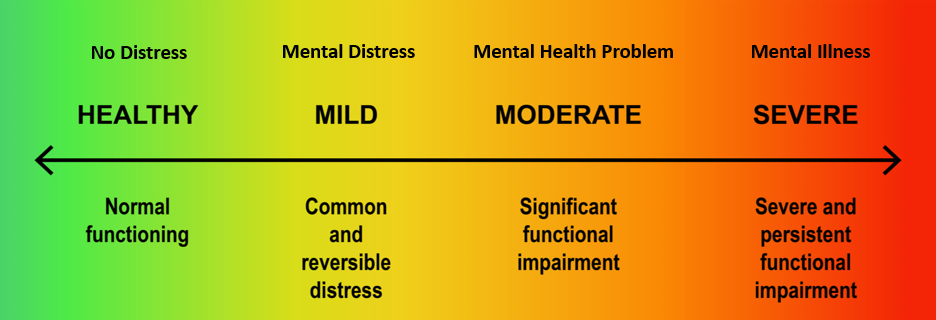
Some post-secondary institutions already use what is known as mental health literacy to frame their mental health training and support. Mental health literacy is defined as:
For more information on mental health literacy, see Kutcher and Wei (2020).
If your institution uses the mental health literacy framework, this framework can easily be integrated into this training or replace the mental health continuum.

A good introduction to this model is a nine-minute video from the Mental Health Collaborative, The Mental Health Literacy Pyramid, which gives an overview of the framework and the different mental health states. If you have the time, you may want to show it to participants:
Here is a list of videos and other resources on mental health. The resources are also listed in Handout 5: Videos and Other Resources on Mental Health.
How to make stress your friend (14:28 min.).
– Ted Talk by Kelly McGonigal on the many advantages of stress.
The mental health literacy pyramid (9:28 min.), Mental Health Collaborative.
– Provides an overview of the Mental Health Literacy Framework and the different mental health states.
Why stress is good for you (Instant Egghead #40; 2:32 min.), Scientific American.
– Explains how stress can be viewed as helpful.
Comninos, A. (n.d.). Stress. Mindfulness and Clinical Psychology Solutions.
– Web article on the stress curve, different types of stress, and how to cope and manage stress. https://mi-psych.com.au/what-is-stress/
Kutcher, S., & Wei, Y. (2020). School mental health: A necessary component of youth mental health policy and plans. World Psychiatry, 19(2).
– Article on mental health literacy. https://doi.org/10.1002/wps.20732
Ohrnberger, J., Fichera, E., & Sutton, M. (2017, December). The relationship between physical and mental health: A mediation analysis. Social Science and Medicine, 195, 42–49.
– Article on the connection between physical and mental health. https://www.sciencedirect.com/science/article/pii/S0277953617306639
TeenMentalHealth.org. (n.d.). How not to bubble wrap kids: Learning how to use daily stress to develop resilience.
– Information sheet on using daily stress to develop resilience. https://mentalhealthliteracy.org/wp-content/uploads/2017/09/Stress-Two-pager.pdf
This agenda provides suggested timings for a two-hour session, the minimum time recommended for presenting the information and providing time for the activities. However, you may want more time to offer this training and could extend the session to two-and-a-half or even three hours to allow more time for discussion, debriefs, and short breaks, and to give students lots of time to work through the scenarios at the end. Some facilitators may want to offer this training over two sessions. While this training is adaptable, we recommend that you include the sections on Indigenous perspectives on wellness, diversity, and marginalized groups, as it is important to maintain the integrity of diversity of voice in this resource.
| Activity | Suggested Time |
|---|---|
Opening the Session
| 9 min. |
What Is Mental Health and Wellness?
| 10 min. |
The Language of Mental Health
| 15 min. |
Marginalized Groups and Mental Health
| 9 min. |
Let’s Talk about Stress
| 15 min. |
What To Do When We’re Stressed
| 10 min. |
| SHORT BREAK | 5 min. |
Helping Other Students
| 12 min. |
Maintaining Boundaries
| 5 min. |
Scenarios for Practice and Discussion
| 20 min |
Concluding the Session
| 10 min. |
This section describes how to open the session and prepare participants to engage with the material. It includes:
An interactive H5P element has been excluded from this version of the text. You can view it online here:
https://opentextbc.ca/studentmentalhealth/?p=41#h5p-2
These slides are available for use with this section of the presentation. For information about downloading the slide deck, see the Introduction.
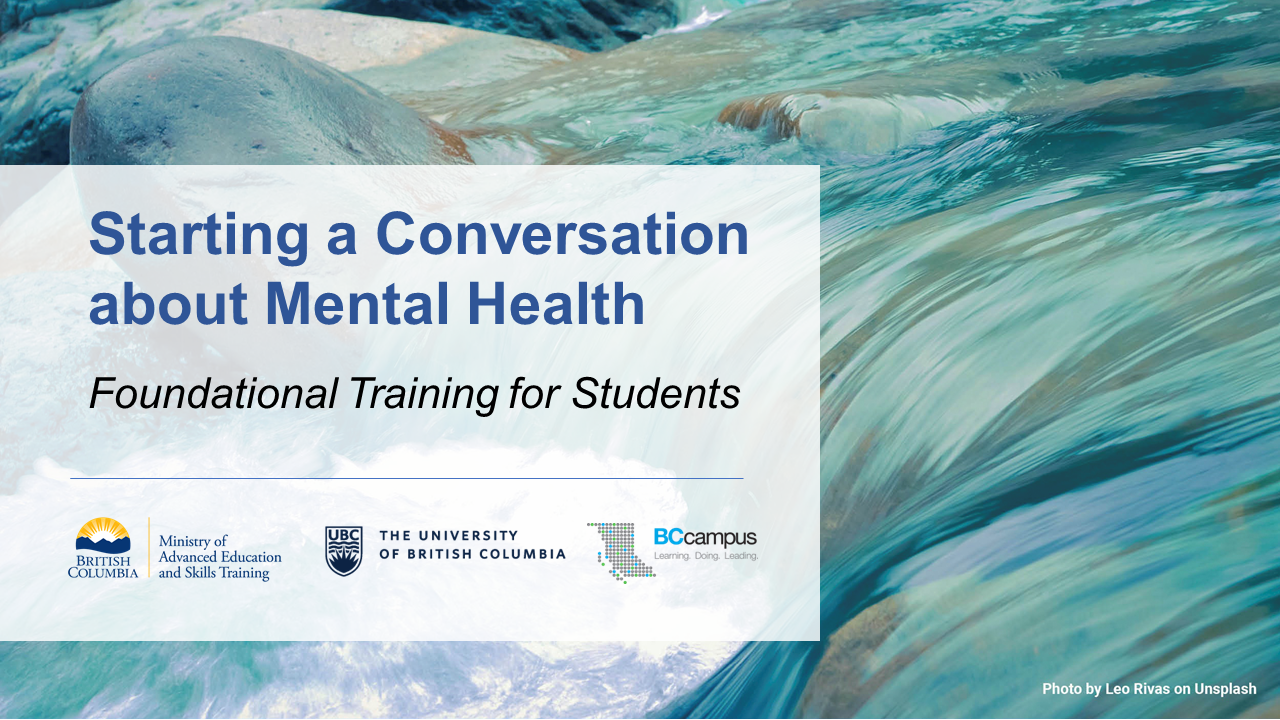

Welcome participants and open with a territory acknowledgement. If you’re unsure of your territory, Native-Land.ca is a helpful resource.
Territory Acknowledgement and Indigenous Ways of Knowing and Being
A meaningful territory acknowledgement allows us to develop a closer and deeper relationship with not only the land but also the traditional stewards and peoples whose territories we reside, work, live, and prosper in.
Acknowledging the territory within the context of mental health and well-being can open a person’s perspective on traditional ways of knowing and being, stepping out of an organizational structure and allowing participants to delve into their own perceptions, needs, and abilities.
Territory acknowledgements are designed as the very first step toward reconciliation. What we do with the knowledge of whose traditional lands we are on is the next important step.
Some questions to consider as you acknowledge your territory:
Should your institution have an approved territory acknowledgement, please use that to open the session; however, we invite you to consider how to make that institutional statement more personal and specific to you, in that moment and in the work you are about to delve into with your participants.
After the welcome, introduce yourself. You could then ask participants to very briefly introduce themselves, or you may want to start the session with a short participant check in as a way to invite people into a learning space. You could ask participants to share their name, what they study, and what they are hoping to get out of the session. If you’re offering the session online, you could also do an online poll that asks people to choose the type of weather that matches how they are feeling. There are many different ways to have participants check in with themselves and the group, and we invite you to use questions and reflections that are meaningful to you and the group.
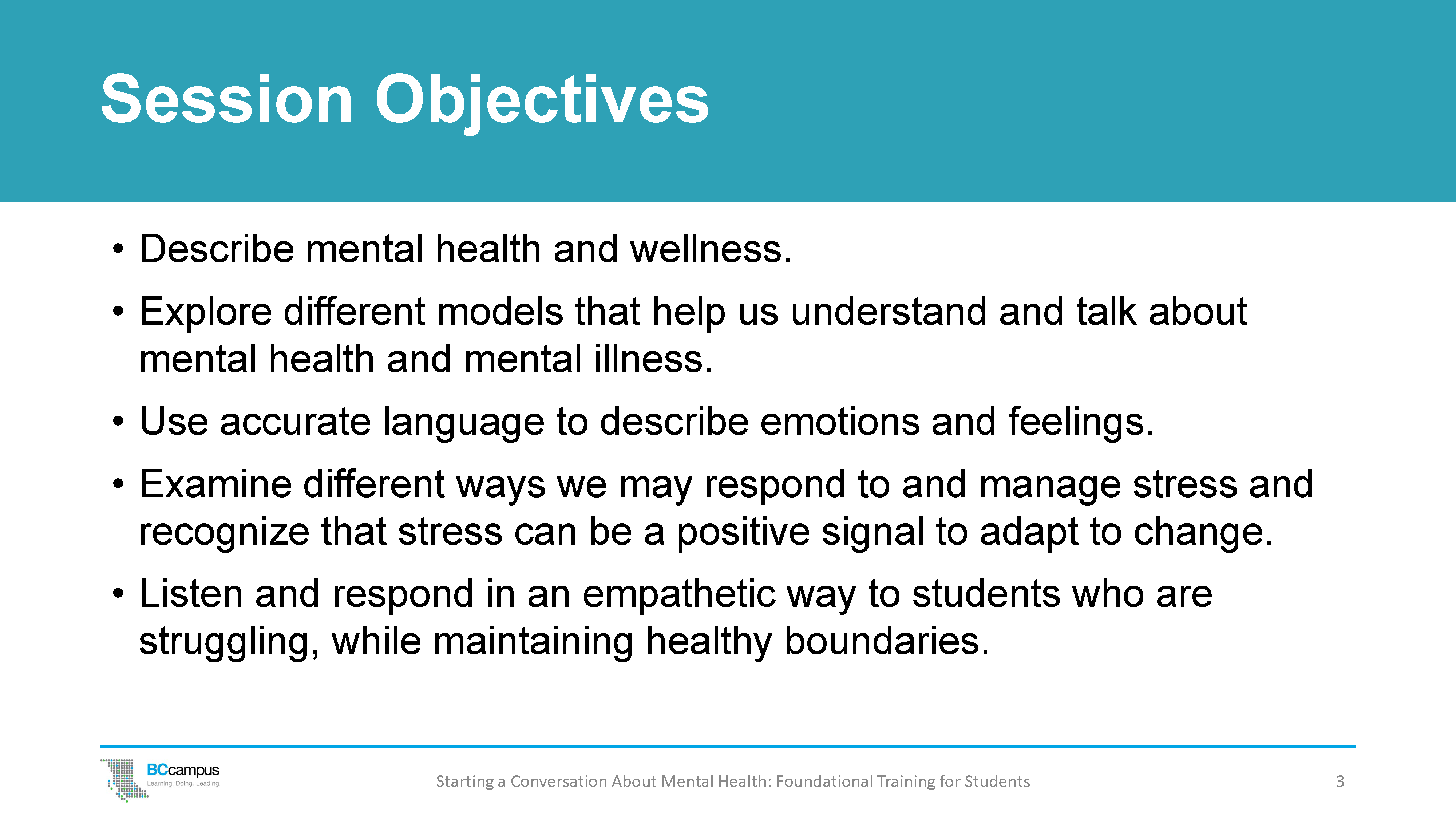
The overall goal of this session is to help you develop the knowledge and skills to maintain good mental health, cope with stress, and support other students who are struggling with stress and mental health.
After participating in the session, you will be able to:
This session offers foundational information on mental health, as well as opportunities to practise listening and supporting other students in an empathetic way.
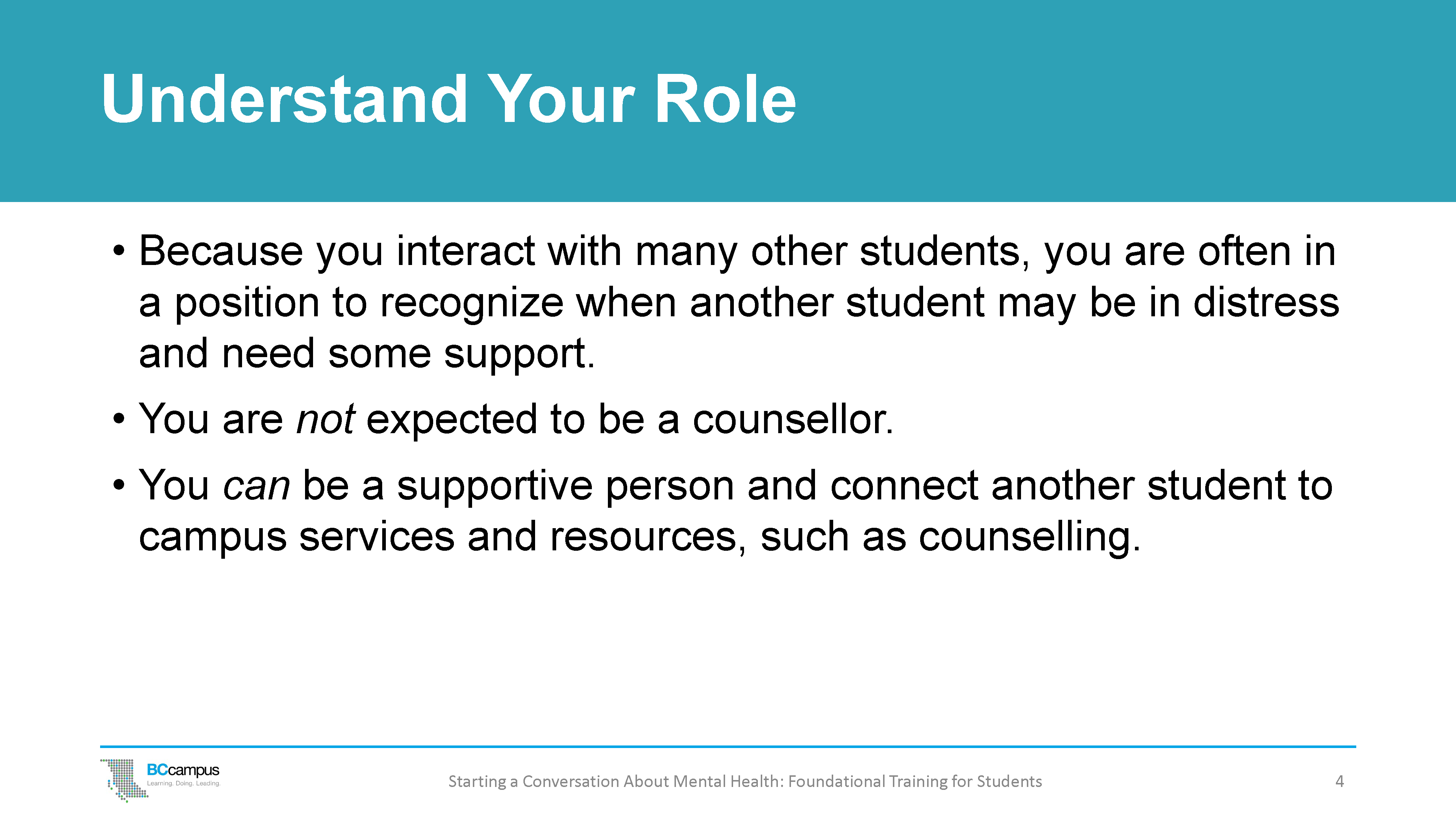
It is important to remember that you are not a counsellor or mental health professional. Nobody expects you to act as a counsellor, and you cannot, and should not, diagnose mental illness, nor should you provide mental health care. However, you can be an important component of the caring community of people who can surround and support another student in need.
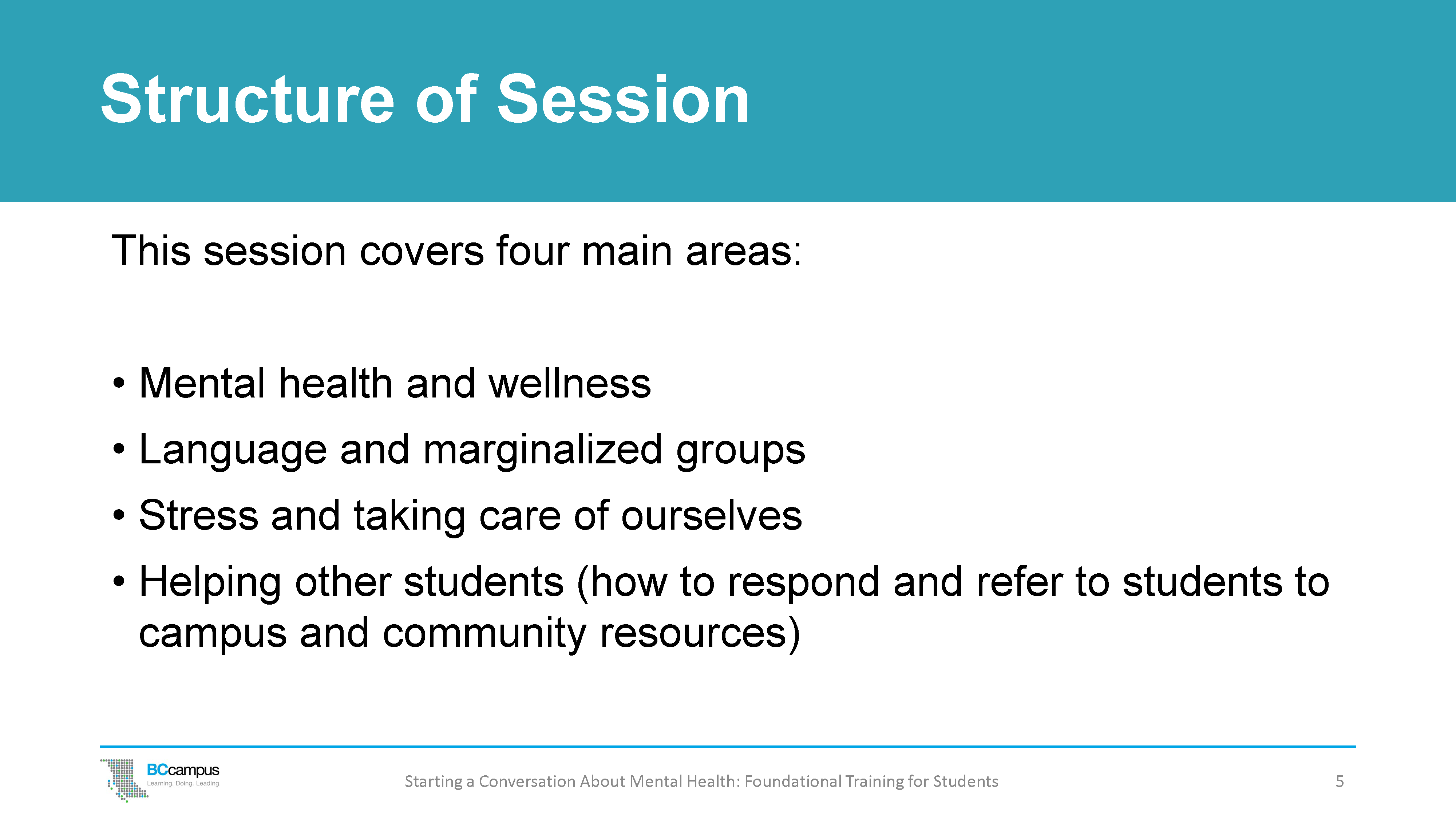
The session covers four main areas:
This is foundational training in mental health. It doesn’t cover suicide awareness, which requires more in-depth training. However, we do cover what to do in an emergency.
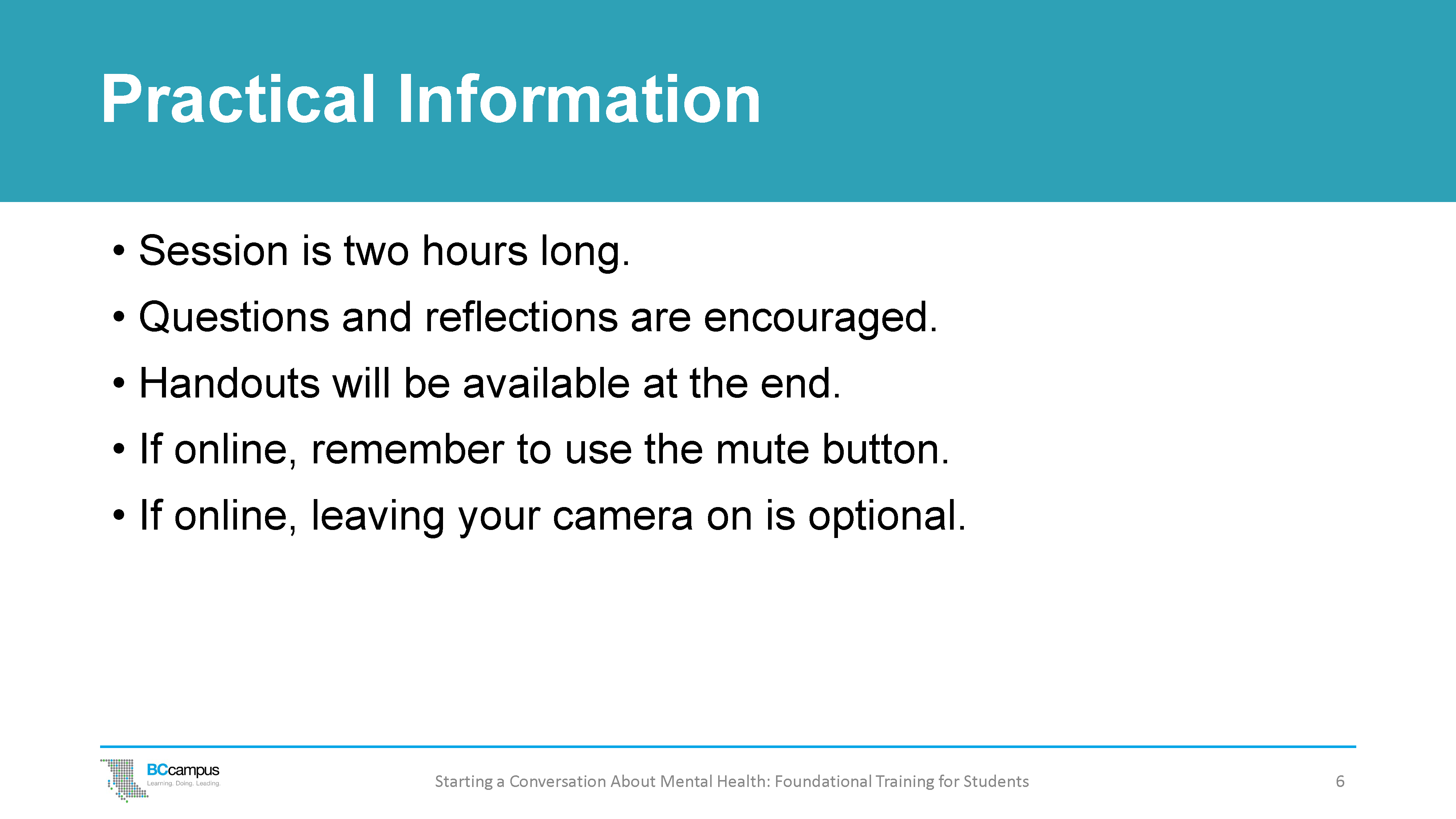
As you engage with the content of the session, reflect on how it might apply to situations you have experienced yourself or with your peers.
You are encouraged to:
After the session, you will have access to printable (PDF) handouts.
If you are facilitating this session online, remind participants that they can turn off their cameras and move around the room during the session. Ask them to be mindful of using the mute button to reduce noise in the online space.
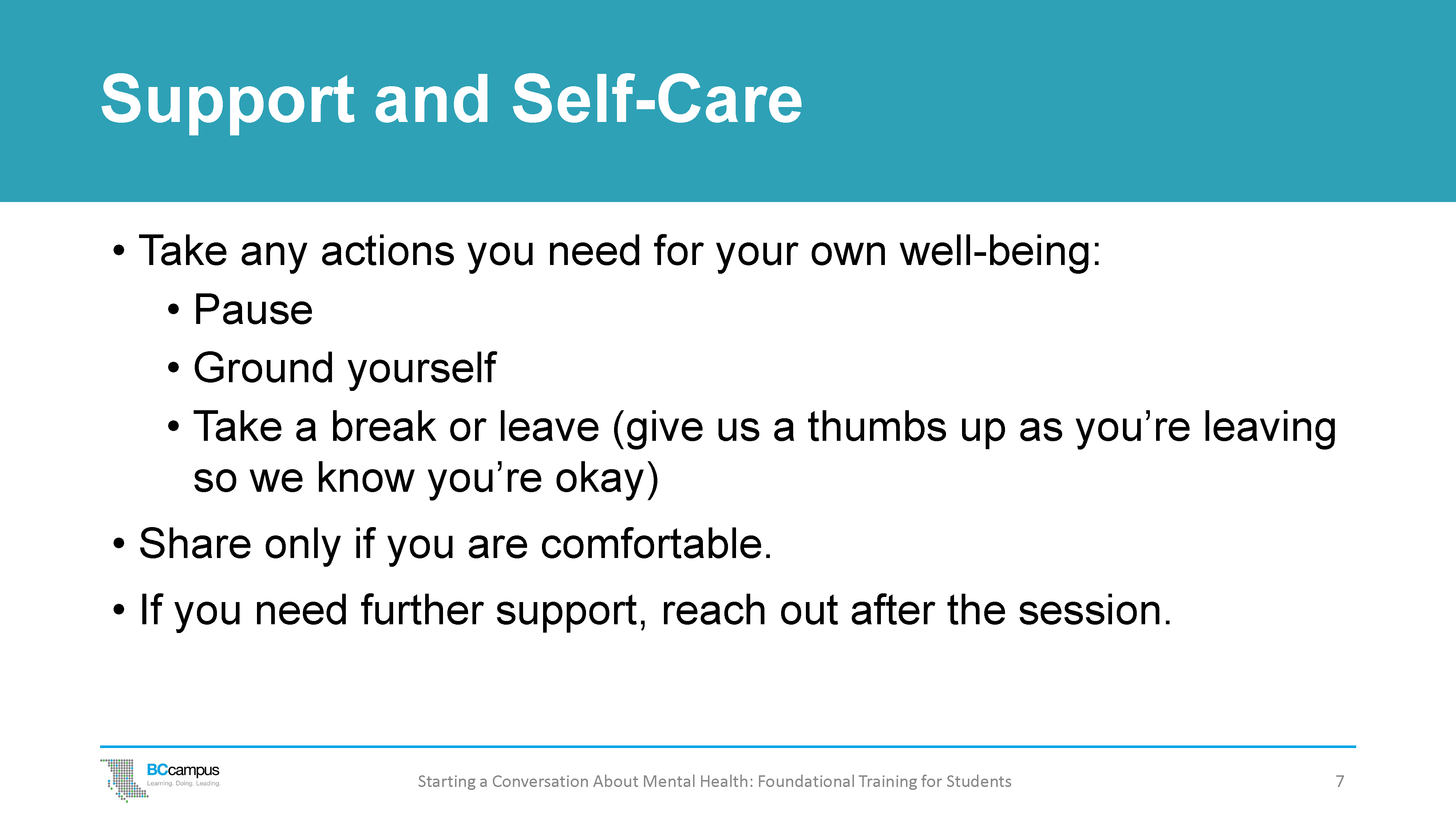
You are invited to do whatever you need to do to take care of yourself throughout the session.
This may be a difficult topic for some of you. Everyone will have been touched in some way by the topics that will be discussed in the session. Feel free to pause, take a break, stretch, and ground yourself at any time.
You can share at the level that you feel comfortable with. If anything comes up in the session that feels too important or difficult to handle on your own, don’t hesitate to reach out to the appropriate services, such as counselling services, to debrief or discuss it further. If you prefer not to share, that’s okay.
If you need to leave, that’s okay too.
For in-person sessions, you could suggest that if a participant does need to leave a session that they give a thumbs-up as they go to let you know they’re okay. Tell everyone that if you don’t see a thumbs-up, you’ll ask a colleague to look for the participant outside the session to make sure they are alright.
To begin, you could have the group engage in a breathing exercise to set the tone for the session, to give participants a few moments to become aware of their own emotional well-being, and to practise a stress management technique. Note: There is also an opportunity to do a box breathing later in the session in “What to Do When We’re Stressed” if you prefer to wait to do this exercise.
We’re going to start with a breathing exercise called box breathing. You can do this if you start to feel overwhelmed at any point in the session. It can help bring your heart rate back to normal, so you feel a little more relaxed. Here’s how how you do it:
Box breathing is a simple stress management exercise that can be practised anywhere. You can practise it for only a minute or two and experience the immediate benefits of a calm body and more relaxed mind.
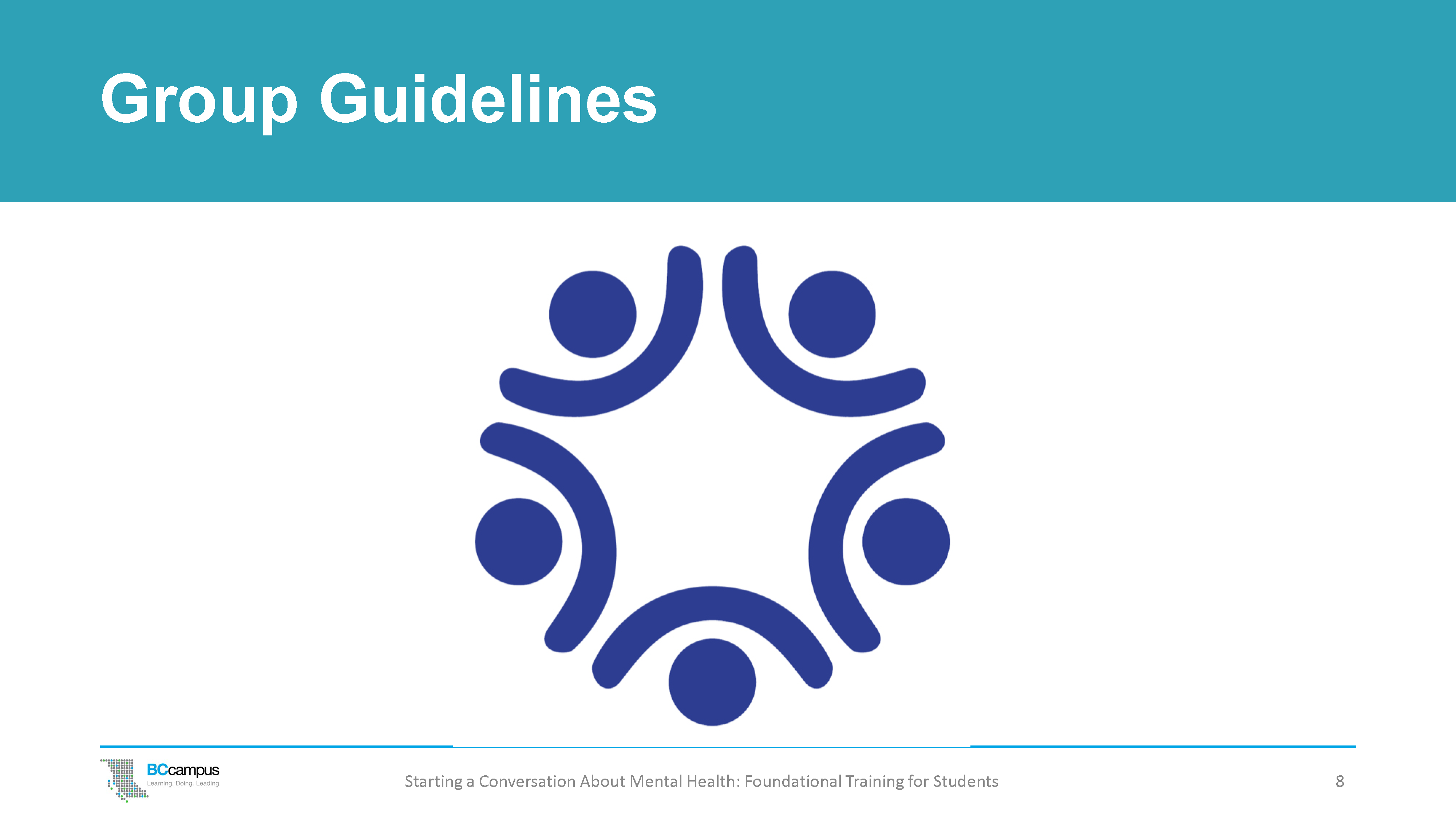
It is helpful to set some expectations and boundaries for the discussion. For example:
You could also ask participants to share ideas for group guidelines at the beginning of the session, or you could share a list of guidelines before the session begins to save time during the session. (See Group Guidelines.)
This section describes what mental health is and focuses on what mental wellness looks like by introducing the Wellness Wheel, a model based on Indigenous holistic perspectives of wellness. The Wellness Wheel is available as a PDF (Handout 1).
An interactive H5P element has been excluded from this version of the text. You can view it online here:
https://opentextbc.ca/studentmentalhealth/?p=49#h5p-3
These slides are available for use with this section of the presentation. For information about downloading the slide deck, see the Introduction.
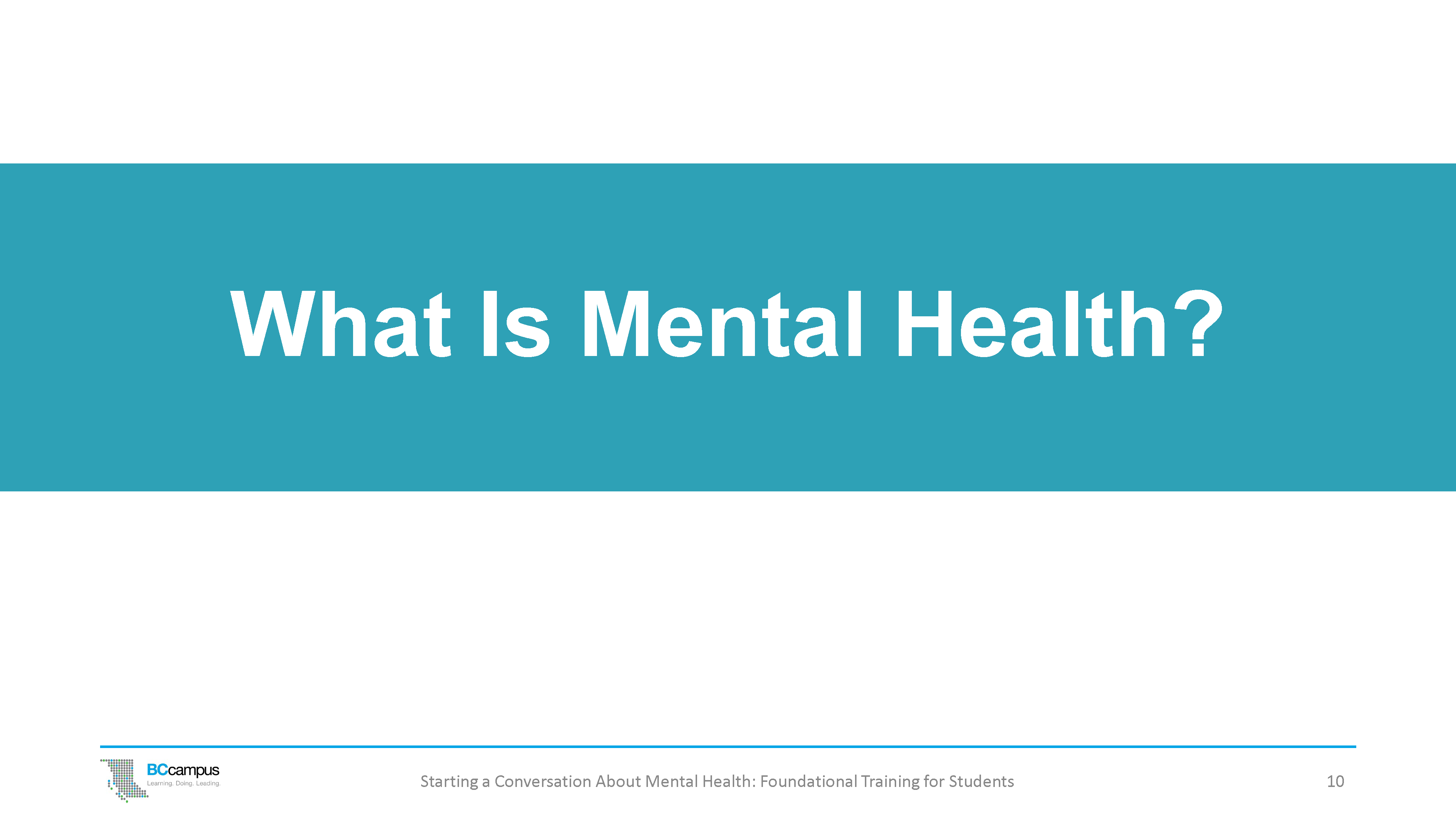
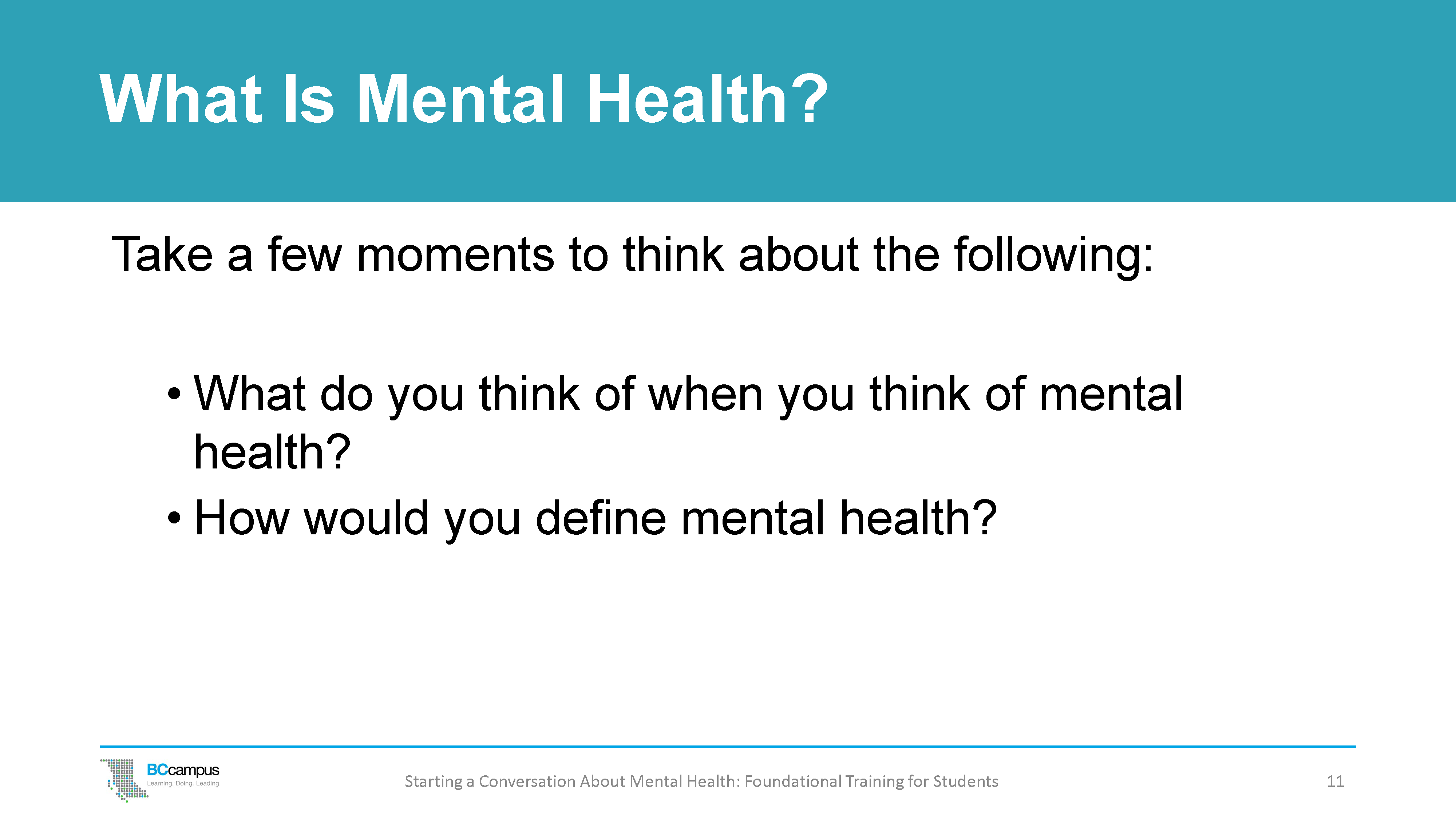
ACTIVITY: Brainstorming What Mental Health Means
Ask participants to jot down what they think of when they think of mental health. (If online, ask participants to put one or two thoughts in the chat.) Ask participants to briefly share, and then show the slide with the definition from the Public Health Agency of Canada.
Consider this definition of mental health:
“Mental health is the capacity of each and all of us to feel, think, and act in ways that enhance our ability to enjoy life and deal with the challenges we face. It is a positive sense of emotional and spiritual well-being that respects the importance of culture, equity, social justice, interconnections, and personal dignity.”
– Public Health Agency of Canada, 2014
This definition comes from the Public Health Agency of Canada. Are there other definitions that resonate better for you? Are there components missing?
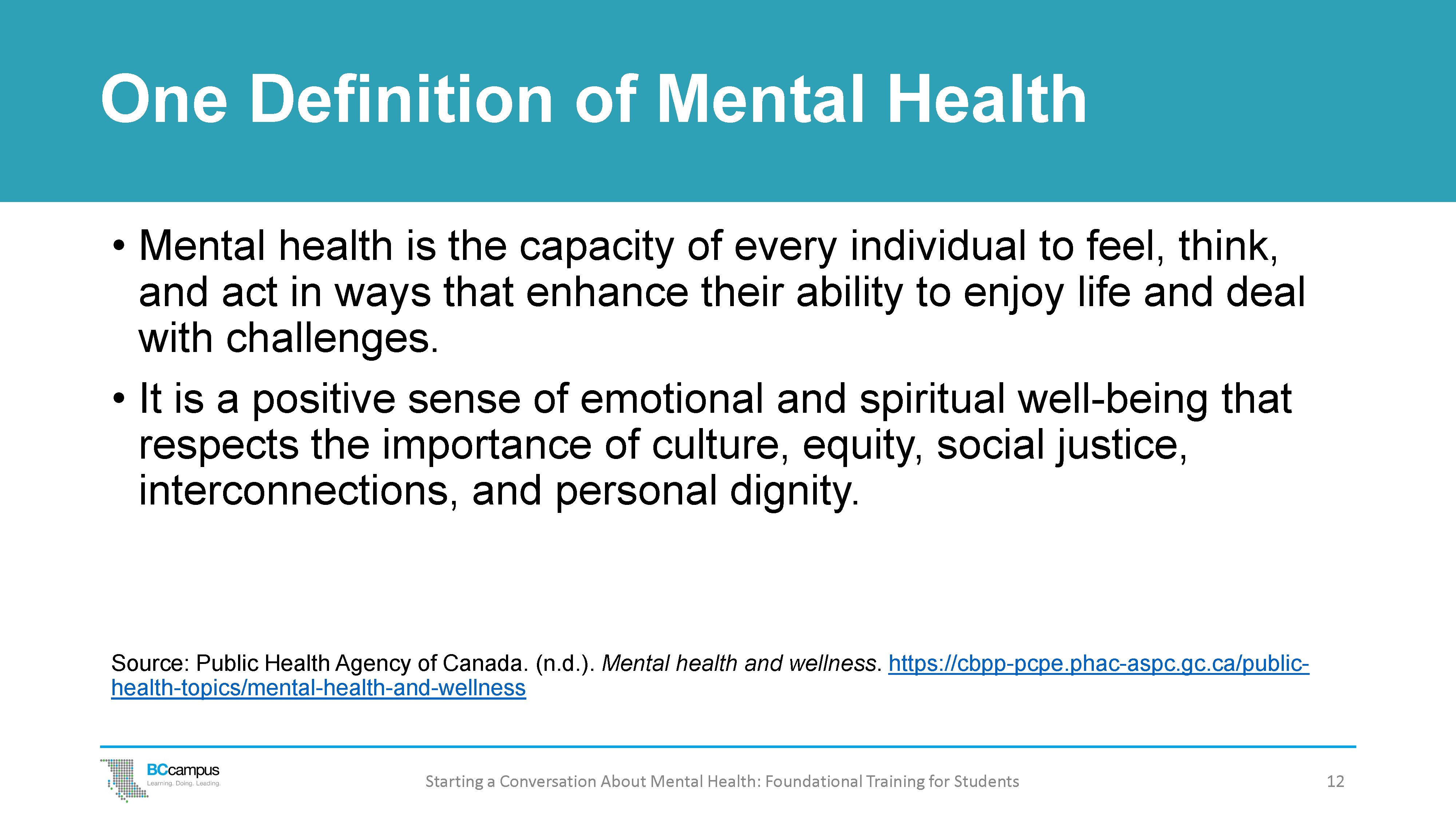
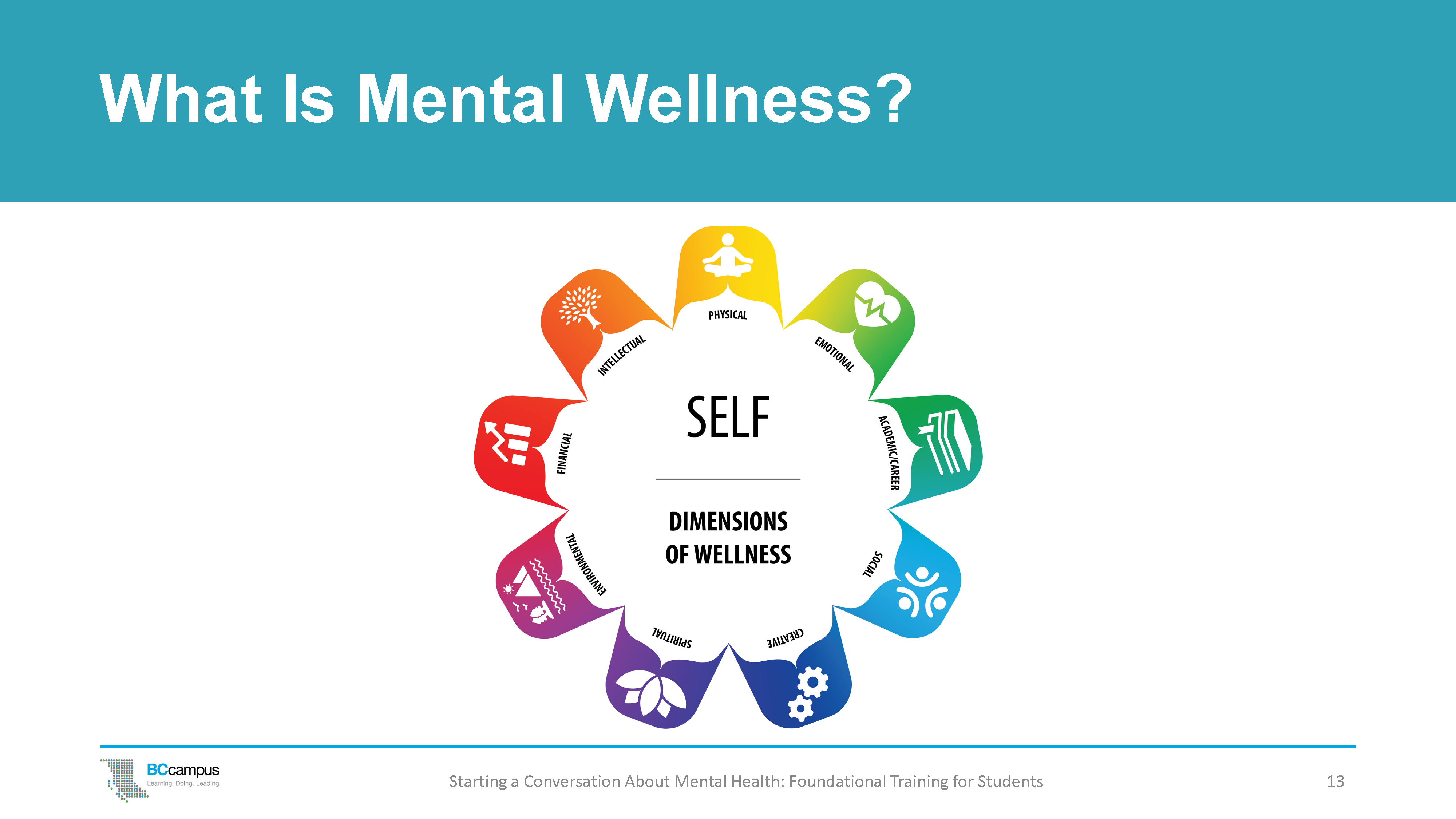
Let’s first look at what mental wellness looks like. The Wellness Wheel is a model that aligns with Indigenous traditional practices, which view individuals holistically. It recognizes that wellness is about being in a state of balance with the physical, emotional, academic/career, social, creative, spiritual, environmental, financial, and intellectual aspects of our lives. The Wellness Wheel can help us identify what might be causing us stress and understand what aspects might be falling in and out of balance in our lives.
The Wellness Wheel is not a static concept but a way of viewing the many dimensions that support wellness. There are things we can all do as individuals to improve our own mental health and well-being, and how we manage our wellness is an ongoing reflective practice.
The goal is not to be perfectly balanced; you will not always be able to attend to different aspects of your wellness equally. The Wellness Wheel can be used as a reflection tool to help you consider where you might want to focus some energy if you want to invest in your wellness.
We can try our best to be flexible and respond to aspects of well-being that may need additional care or attention. Using the concepts in the Wellness Wheel can help us visualize our journey and assist not only in mitigating stressful circumstances but also in recognizing areas of our lives in which we are thriving.
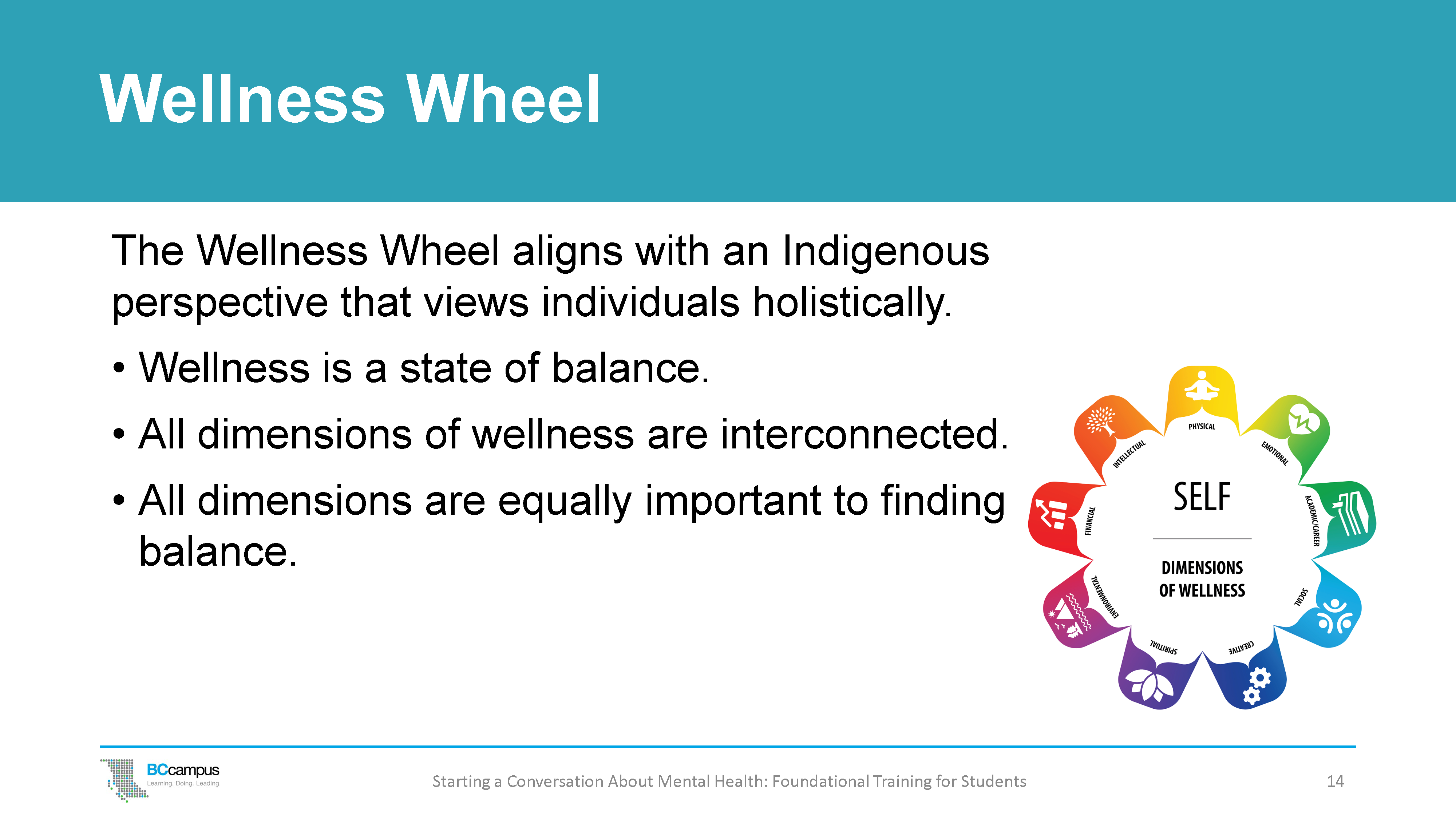
Click on the + signs in the Wellness Wheel for more information about each of the dimensions.
An interactive H5P element has been excluded from this version of the text. You can view it online here:
https://opentextbc.ca/studentmentalhealth/?p=49#h5p-4
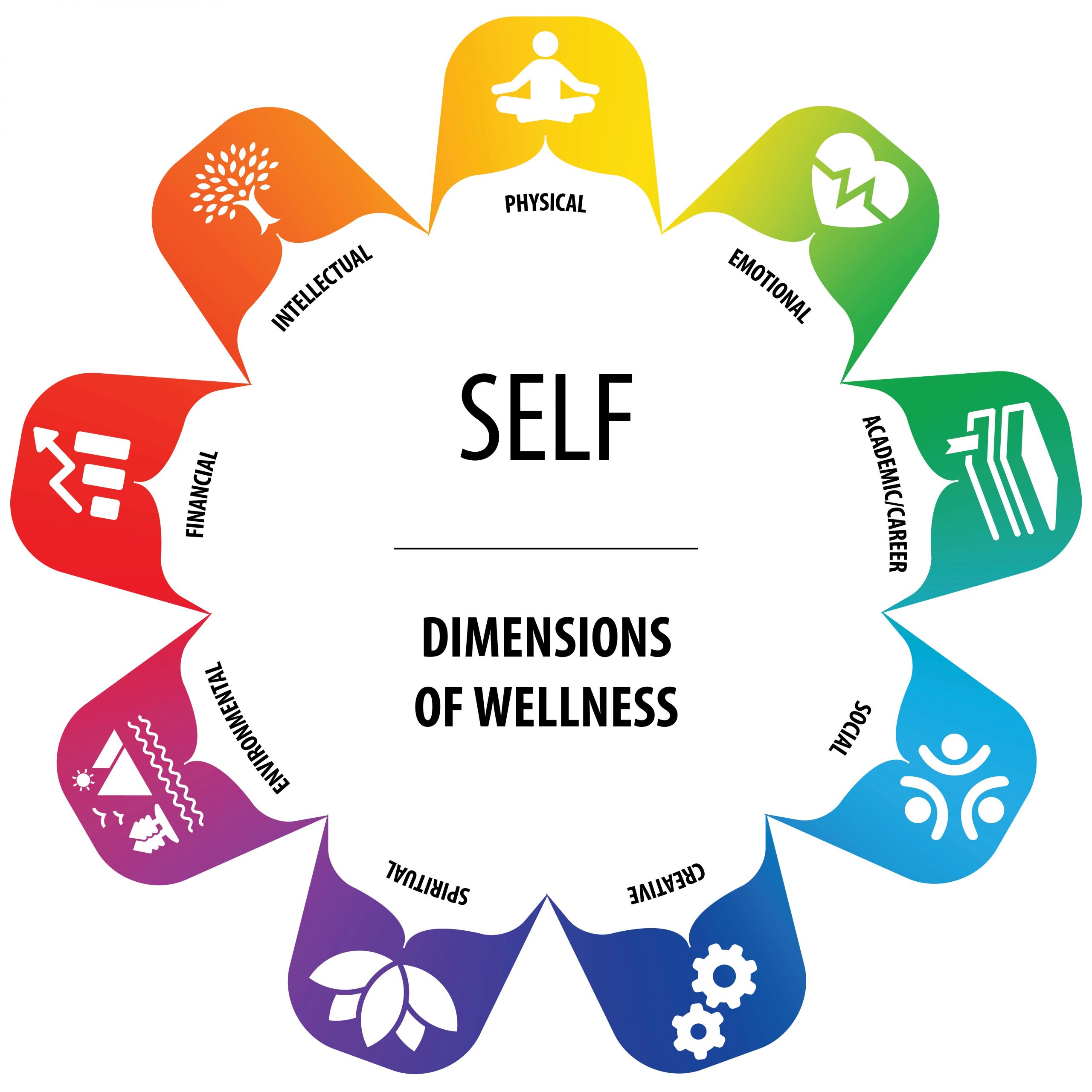
The Wellness Wheel is made up of the following dimensions:
Let’s look at some suggestions for taking care of different aspects of your wellness. Keep in mind that these are just suggestions, and often activities are beneficial in many different dimensions. For example, taking a walk in the park with a friend could support your physical wellness, emotional wellness, social wellness, and environmental wellness.
Physical wellness means taking care of your body through physical activity, nutrition, sleep, and mental well-being. For example:
Emotional wellness means making time to relax, reduce stress, and take care of yourself. It also means paying attention to both positive and negative feelings and understanding how to handle these emotions. For example:
Academic/career wellness means expanding your knowledge and creating strategies to support continued learning. For example:
Social wellness means taking care of your relationships and society by building healthy, nurturing, and supportive relationships and fostering a genuine connection with those around you. For example:
Creative wellness means valuing and actively participating in arts and cultural experiences as a means to understanding and appreciating the world around you. For example:
Spiritual wellness means taking care of your values and beliefs and creating purpose in your life. For example:
Environmental wellness means taking care of what is around you. Living in harmony with the Earth by taking action to protect it and respecting nature and all species. For example:
Financial wellness means learning how to successfully manage your finances so you can be financially responsible and independent. For example:
Intellectual wellness means being open to exploring new concepts, gaining new skills, and seeking creative and stimulating activities. For example:
Let’s keep the Wellness Wheel in mind as we look at other mental health models. We’ll come back to the Wellness Wheel and do a group activity a bit later in the session.
Mental health terms are often used interchangeably or inaccurately. This section introduces the Mental Health Continuum and defines different mental health states so participants can begin to accurately use mental health terms and understand the difference between mental distress, mental health problem, and mental illness.
An interactive H5P element has been excluded from this version of the text. You can view it online here:
https://opentextbc.ca/studentmentalhealth/?p=57#h5p-5
These slides are available for use with this section of the presentation. For information about downloading the slide deck, see the Introduction.
In the last 10 years, mental health awareness has increased to a point where we can openly discuss mental health in many contexts. Talking about mental health is an important part of decreasing the stigma associated with mental illness. However, when we are talking about mental health, we often use words loosely and interchangeably so that they can start to lose their true meaning.
We’re going to look at some models to help us understand the language of mental health. Mental health models challenge us to be more thoughtful about how we are using our words. They can help us differentiate between different mental health states: no distress, mental distress, mental health problems, and mental illness.
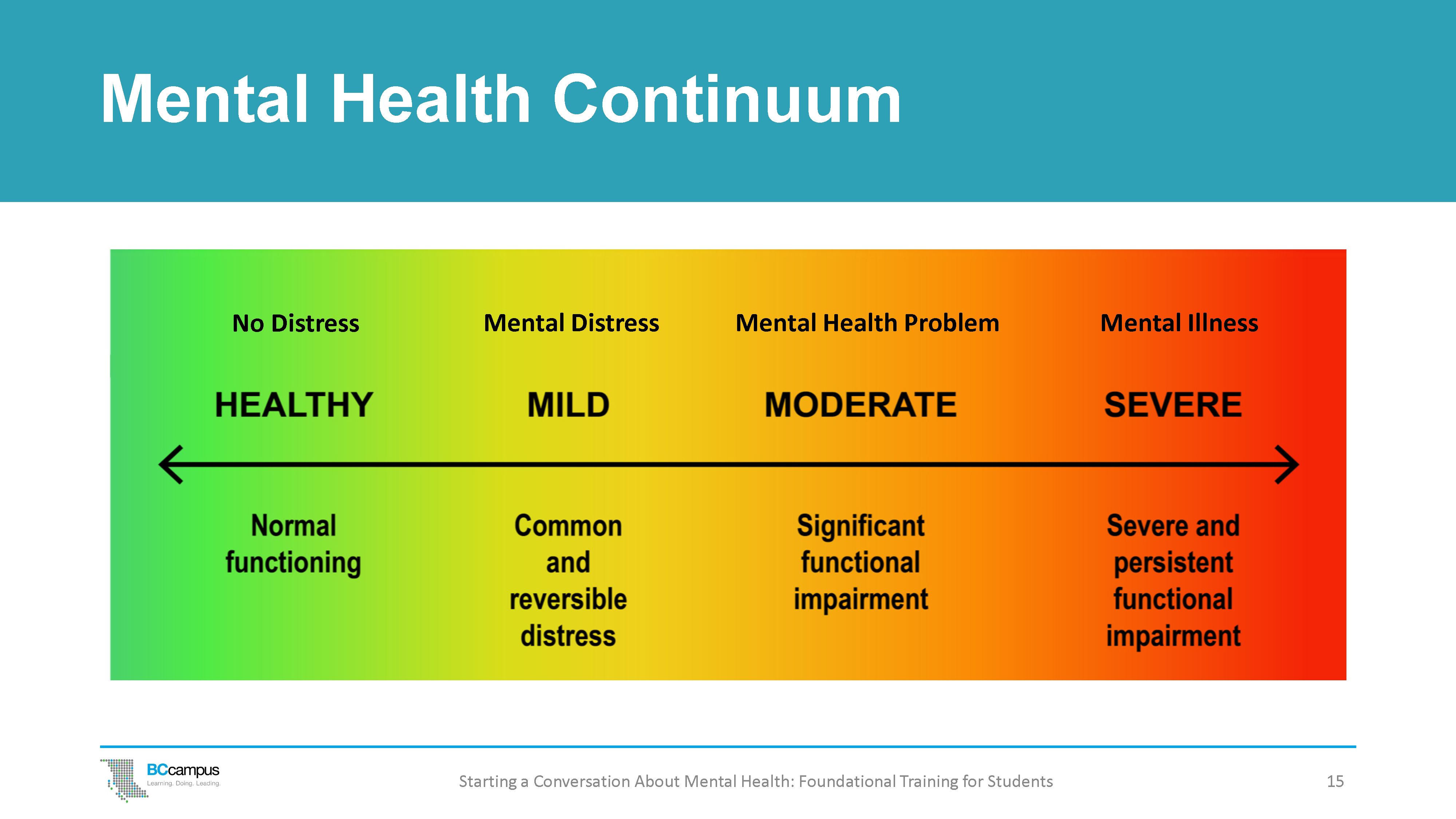

The Mental Health Continuum is one way to think about mental health. All of us have a mental health life; we all experience changes in our mood, changes in our level of anxiety – from life stressors or from crises – and those changes can be considered on a spectrum or a continuum. On this continuum, we can move from healthier to more disrupted levels of functioning and back. At each level, there are resources available to promote health and reduce disruption.
While it is important to recognize different people’s backgrounds and experiences when dealing with this language, it is crucial that we also recognize that there are a number of words that are specifically reserved for talking about diagnosed medical conditions. The Mental Health Continuum shows four different states: no distress (healthy functioning), mental distress (common and reversible stress), mental health problem (significant functional impairment), and mental illness (severe and persistent functional impairment).
(Healthy – Normal functioning)
Starting at the left side of the continuum, we see the category No Distress. Most of us are in this state most of the time. This is when we’re having fun with our friends and families, engaging at school or work, enjoying ourselves in a recreational activity, reflecting on the day’s events, or even asleep. We can cope with whatever comes our way, and we can do the things we need or want to do. Thinking back to the Wellness Wheel, this is when everything is mostly in balance on the wheel or in our lives.
(Mild – Common and reversible distress)
When we experience daily mental distress and feel sad, disappointed, angry, or overwhelmed in the moment. These experiences of stress are to be expected at times in our lives; they may be common and reversible, and they are usually temporary, such as the stress we experience during exam time. We can maintain hope that when it’s all over, we’ll likely feel a lot better – the stressor will come to an end and there is usually some relief.
We may not need any intervention; people are often resilient and able to adapt by themselves by engaging positive coping strategies and with support from family or friends. We can share our troubles with others and talk about ways to change the situation.
(Moderate – Significant functional impairment)
Mental health problems may arise when a person is faced with a much larger stressor than usual. These occur as part of normal life – for example, in response to the death of a loved one, moving to a new country, or having a serious physical illness – and are not mental illnesses.
When faced with large stressors, people can sometimes experience strong negative emotions (such as grief, anguish, or desolation). These emotions are also accompanied by substantial difficulties in other domains, such as:
Sometimes someone experiencing a mental health problem will exhibit noticeable difficulties in everyday functioning. People experiencing mental health problems may need extra help, such as counselling, in addition to support from family, friends, and their community. Medical treatment (medication or long-term psychotherapy) is usually not necessary.
(Severe – persistent functional impairment)
A mental illness is very different from mental distress and from a mental health problem. It arises from a complex interplay between a person’s genetic makeup and the environment in which they live or have been exposed to at different times in their lives.
A mental illness (also called a mental disorder) is a medical condition diagnosed by a trained health professional (such as a doctor, mental health clinician, psychiatric nurse, or psychologist) using internationally established diagnostic criteria. People with mental illnesses will require the best evidence-based care from properly trained health care providers.
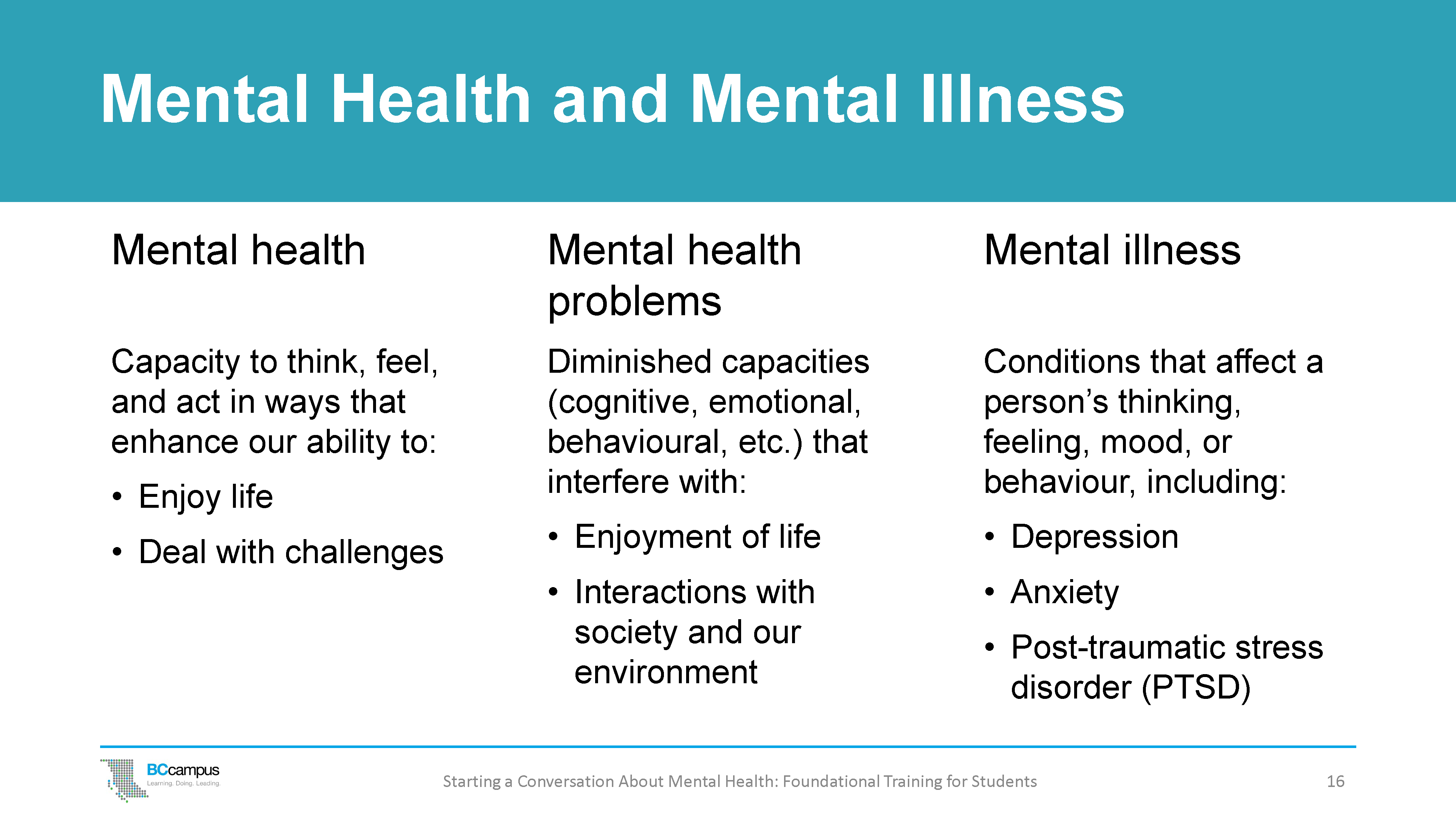
The Mental Health Continuum is just one way to help us to differentiate between different mental health states. It’s important to understand the differences because different mental health states should be managed or supported differently.
A person can be in each of these states at the same time. For example, over the course of one day a person can be laughing and having fun with their friends (no distress, problem, or disorder), can experience distress (lost their house key), be experiencing a mental health problem (their uncle with whom they were close died earlier this week), and have a mental disorder (such as depression).
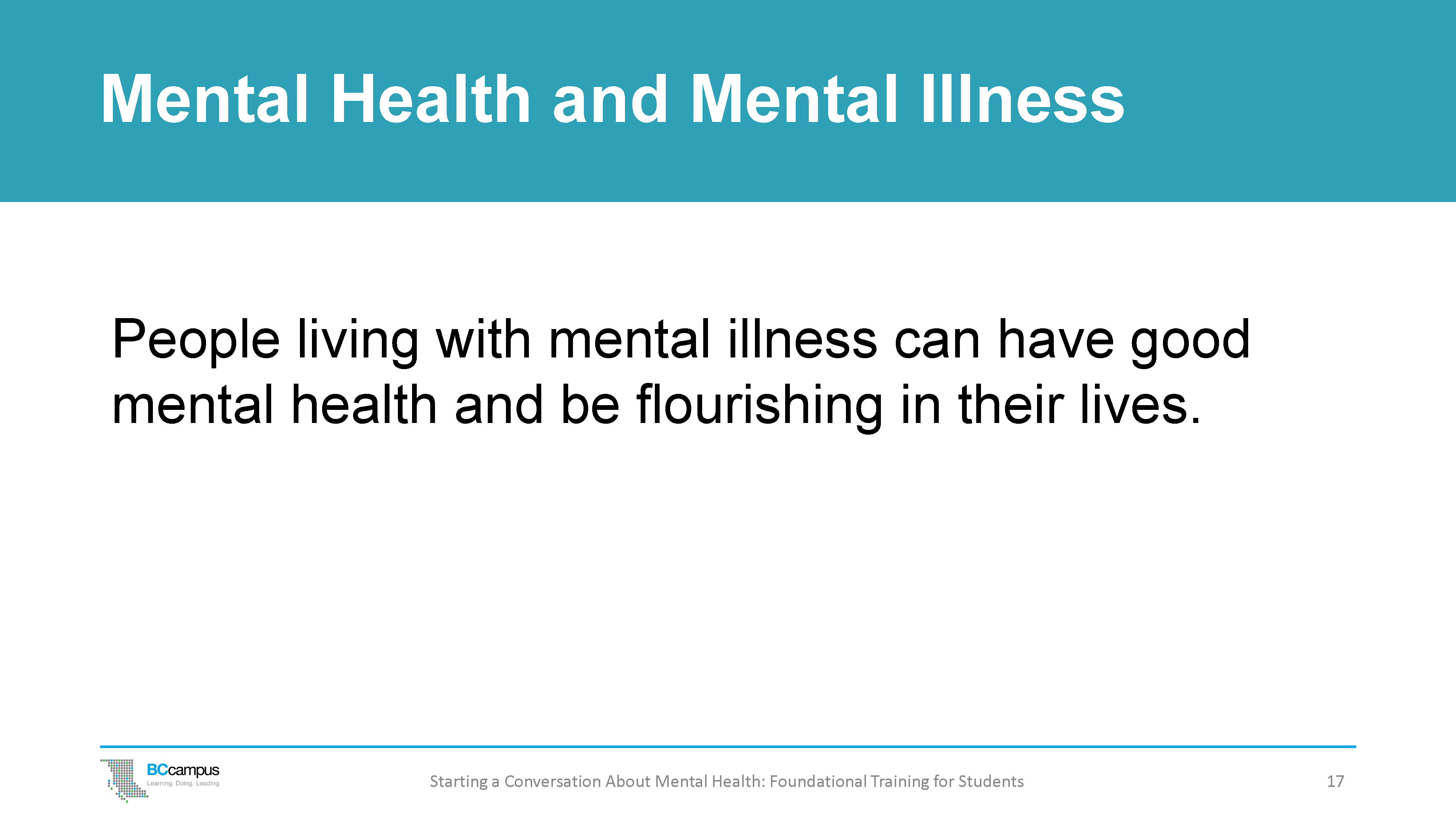
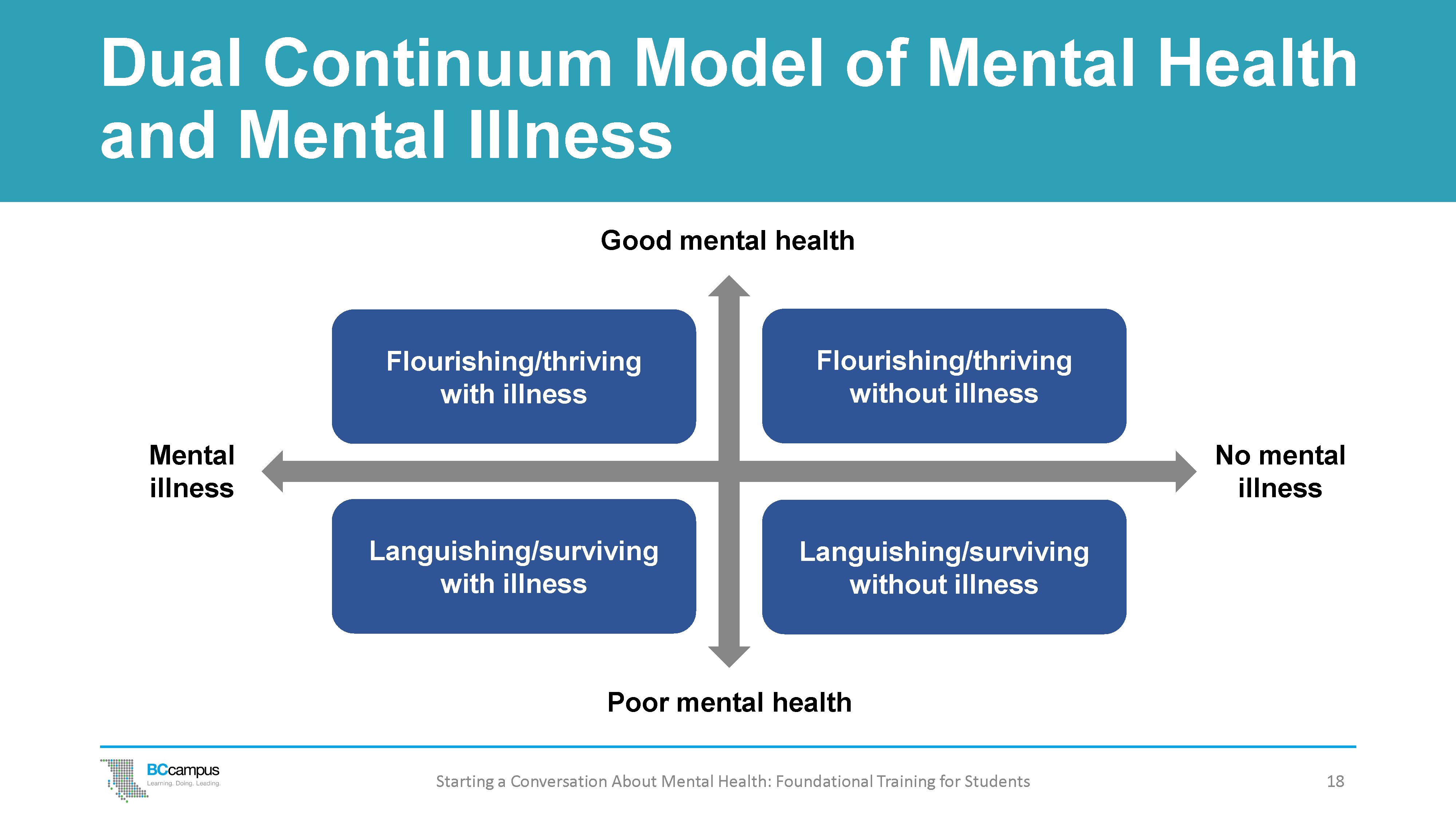
Mental health is more than the absence of mental illness. It includes our emotional, psychological, and social well-being. It is influenced by many factors, and it affects how we handle the normal stresses of life and relate to others.
The Corey Keyes Dual Continuum Model illustrates how a person diagnosed with a mental illness can have good mental health and be flourishing and thriving. Likewise, a person can be languishing or experiencing poor mental health and not be diagnosed with a mental illness.

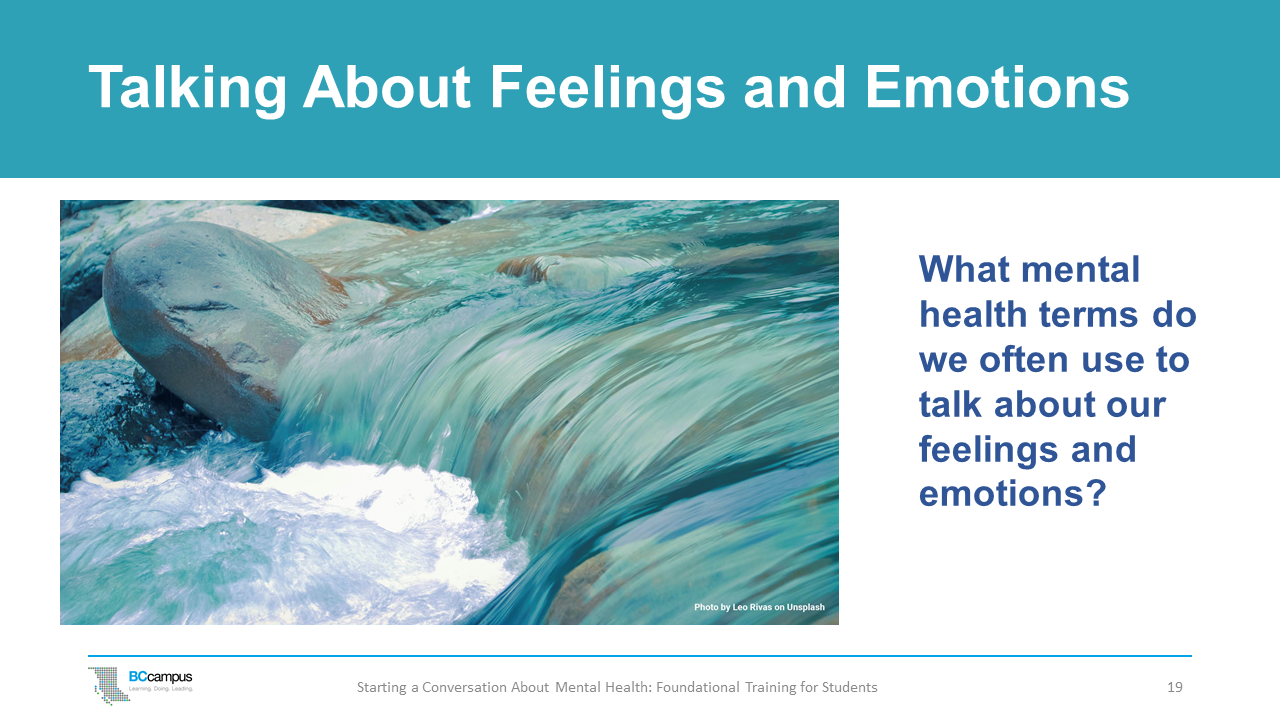
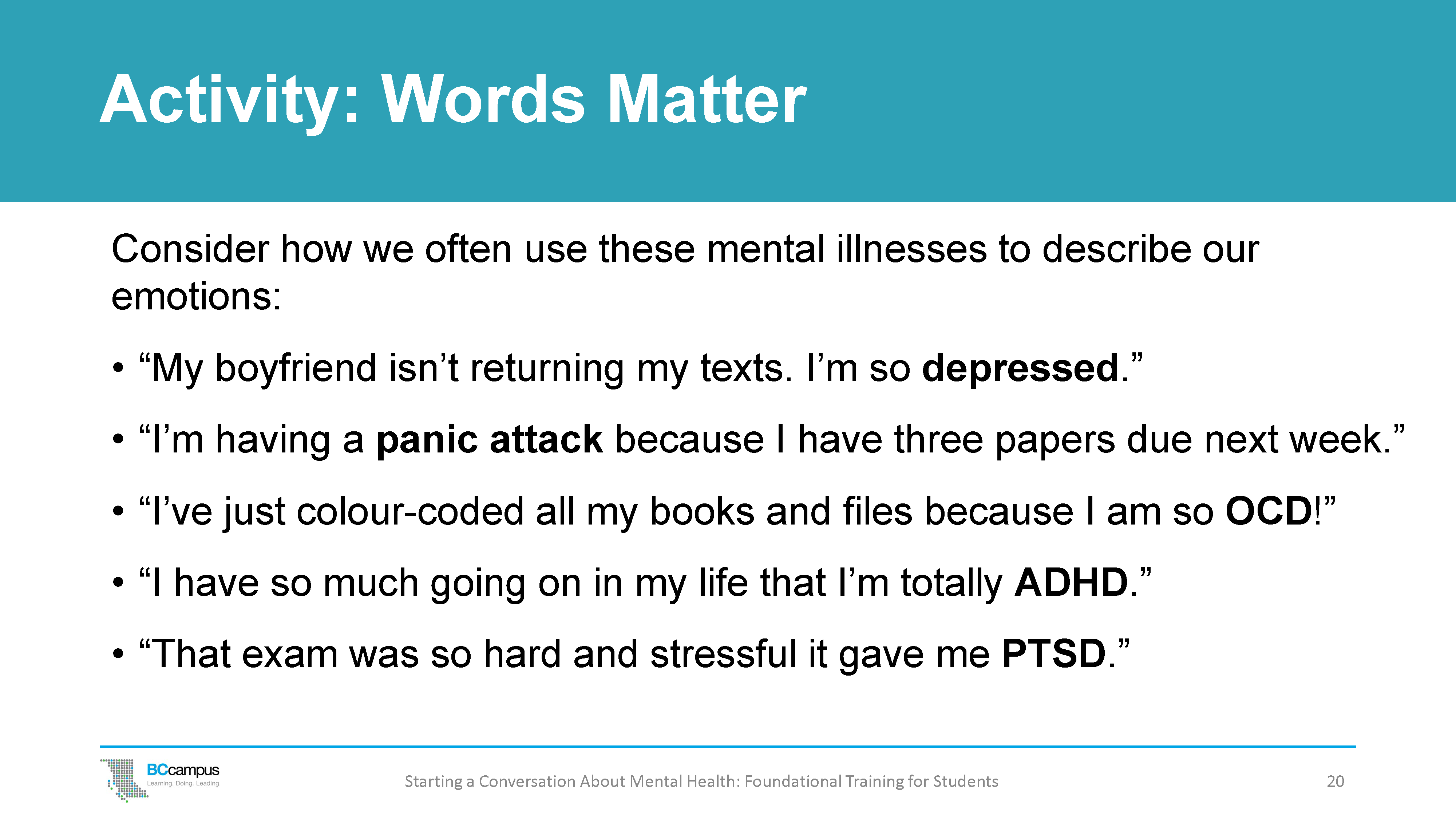
Ask participants to break into pairs or small groups to think about and discuss how we often incorrectly use the mental health terms to describe how we’re feeling.
When we are talking about mental health, we often use words loosely and interchangeably so that they can start to lose their true meaning.
It can also mean that those seeking help for these conditions may not be able to get the help they need because resources may then be unintentionally diverted to those who are using these words to describe their everyday feelings.
Have each group consider one of the sentences in the slide to discuss how we frequently use mental illness to describe our feelings and emotions.
What are some words we could use instead?
Then, have everyone come back together as a large group to discuss how we can be more mindful of the use of these words in common everyday speech despite having precise meanings that are tied to specific clinical diagnoses of mental illnesses.
We need to be careful of our use of words. For example:
Common Mental Health Terms and Definitions
Because it is so important to recognize diagnoses for what they truly mean, here is a list of some of the more common terms heard on a post-secondary campus, as well as their definitions. These terms and definitions are adapted from the American Psychiatric Association, 2013 and are based on information from the DSM-5, a manual developed primarily in the United States. Other classification systems for mental health conditions include the ICD (global), the CCMD (China), and the GLDP (Latin America). You may find it helpful to share these definitions with participants after the small-group discussion activity.
anxiety: A type of body signal or a group of sensations that are generally unpleasant, including a variety of physical sensations that are linked with thoughts that make a person feel apprehensive or fearful. A person with anxiety will often also think that bad things may happen even when they are not likely to happen.
anxiety disorder: A group of common mental disorders. People with an anxiety disorder will experience things like mental and physical tension about their surroundings, or apprehension (negative expectations) about the future, and will have unrealistic fears (see anxiety). It is the amount and intensity of the anxiety sensations and how they interfere with life that makes them disorders.
attention deficit hyper-activity disorder/attention deficit disorder (ADHD/ADD): A mental disorder that is usually lifelong and is associated with a delay in the brain maturing and how it processes information. People with ADHD usually have varying degrees of difficulty paying attention, and may be impulsive or over-active, which often causes problems at home, in school, and in social situations.
depression: A term used to describe a state of low mood or a mental disorder. This can be confusing because people may often feel depressed but will not have the mental disorder called depression. Depression is more than just sadness. People with depression may experience a lack of interest and pleasure in daily activities, significant weight loss or gain, insomnia or excessive sleeping, lack of energy, inability to concentrate, feelings of worthlessness or excessive guilt, and recurrent thoughts of death or suicide.
obsessive-compulsive disorder (OCD): A type of mental disorder in which people experience persistent unwanted and recurring thoughts (obsessions) and/or persistent and unwanted repetitive behaviours (compulsions).
panic attack: A sudden experience of intense fear or psychological and physical discomfort that develops for no apparent reason and that includes physical symptoms such as dizziness, trembling, sweating, difficulty breathing, or increased heart rate. Occasional panic attacks are normal. If they become persistent and severe, the person can develop a panic disorder.
panic disorder: A person with panic disorder has panic attacks, expects and fears the attacks, and avoids going to places where escape may be difficult if a panic attack happens. Sometimes people with panic disorder can develop agoraphobia (a type of anxiety disorder in which a person fears and avoids places or situations that might cause them to panic and make them feel trapped, helpless, or embarrassed). Panic disorder can be effectively treated with psychological therapies or medications.
post-traumatic stress disorder (PTSD): A mental disorder that can happen to people who experience a really scary, painful, or horrific event in which they felt scared or helpless and during which they were in danger of death or severe injury. People who develop PTSD will have flashback memories of or nightmares about the event and will avoid things that remind them of it. For example, if a person was assaulted in a park, they may be too fearful to go to parks and have to find new routes to work. PTSD can be effectively treated with psychological interventions or medications.
Using mental health terms accurately is important, and it is helpful to check in with yourself to ensure that you are using the right words to describe your experience. It is equally important not to make assumptions about others who are using mental health terms, even if you suspect that they are not doing so correctly.
This is because we cannot assume to know another person’s history or experiences that are leading them to use those terms, and we also do not want to apply terms to others that may not accurately fit their experience – for example, assuming someone with depression is simply feeling unhappy or dramatizing minor concerns, or assuming that someone who is having a bad day has depression.
By checking in with your own use of words, you are making a great start at modelling the appropriate use of mental health terms.
An interactive H5P element has been excluded from this version of the text. You can view it online here:
https://opentextbc.ca/studentmentalhealth/?p=62#h5p-6
These slides are available for use with this section of the presentation. For information about downloading the slide deck, see the Introduction.

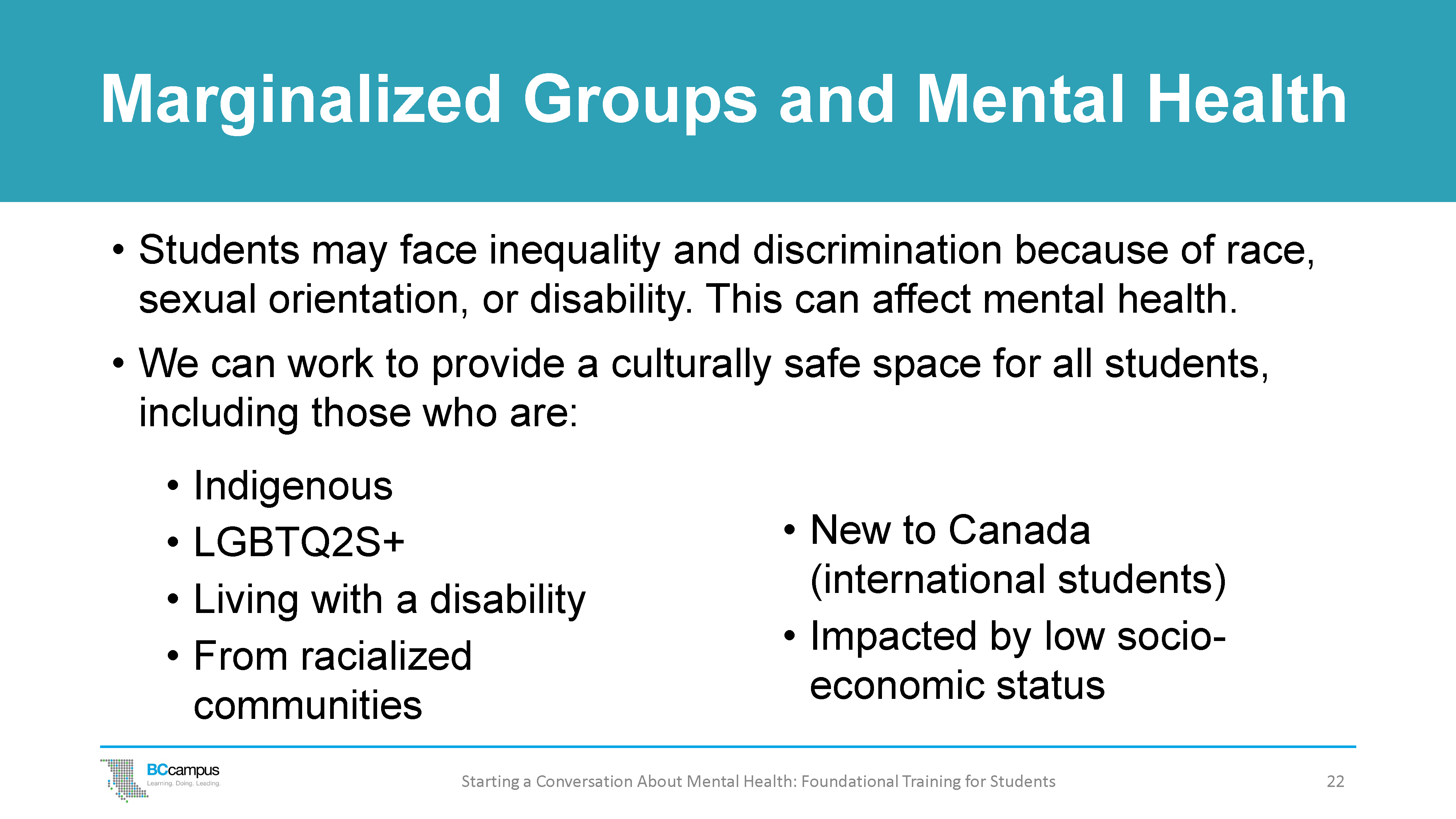
When we talk about mental health, we also need to be aware of factors like race, sexual orientation, social class, disability, and gender and the unique life experiences and stressors that accompany them. Some students face inequality, discrimination, and violence because of their race, gender orientation, or disability. These unique and specific stressors impact mental and physical health, and these students often experience greater mental health burdens and face more barriers to accessing care and resources.
Indigenous students may be struggling as they adjust to living in an urban academic setting after living in a community where they are surrounded by family and neighbours who share the same culture and spiritual beliefs. They may be the first generation in their family to pursue post-secondary education, and they may be missing their home, family, Elders, and community. The impact of residential schools and other colonial policies have created ongoing adversity for Indigenous people, and there is evidence that this has created intergenerational trauma. Many Indigenous students may also lack trust in educational and health care institutions because of the negative or traumatic experiences they or family and friends have experienced in the past.
People who are LGBTQ2S+ (lesbian, gay, bi-sexual, transgender, queer, two-spirit) are at a much higher risk than the general population for mental health disorders, substance abuse, and suicide. Homophobia and negative stereotypes about being LGBTQ2S+ can make it challenging for a student to let people know about this important part of their identity. When people do openly express this part of themselves, they worry about potential rejection by peers, colleagues, and friends, and this can exacerbate feelings of loneliness. Their health needs may be unique and complex, and health care settings can feel unsafe or uncomfortable for some.
Many students live with some form of physical, cognitive, sensory, mental health, or other disability. Students of all abilities and backgrounds deserve post-secondary settings that are inclusive and respectful. Unfortunately, many institutions are not designed to fully support people who need extra accommodation, and students with a disability frequently encounter accessibility challenges and extra barriers to achieving academic success. In addition to navigating the complex environment of a post-secondary institution that is not set up for them, students with a disability also often have to combat negative stereotypes, bias, and discrimination. These many extra challenges can take their toll on mental health.
Black, Indigenous, and other racialized students have likely faced racism and discrimination throughout their lives. Racism can encompass a range of words and actions, from the overt racism of violence or slurs to microaggressions (everyday, subtle interactions that demean or put down a person based on their race). Sometimes microaggressions are not intentional, but they can still be very harmful, and they are a form of racism that many students experience. These repeated negative interactions can be overwhelming at times, especially in post-secondary spaces where a student could reasonably assume they would be free from any form of bullying, harassment, or discrimination.
Racism and discrimination in various forms can have a significant impact on a student’s mental health and can lead to increased risk of depression or suicide, increased levels of anxiety and stress-related illnesses, and post-traumatic stress disorder.
Both undergraduate and graduate international students are often under a lot of pressure, and the stakes may be very high for them: their tuition is expensive, they’ve travelled a long way to attend a post-secondary institution in B.C., and they feel a lot of pressure to do well academically. They may be struggling to adjust to a new culture or learn English, and they may be missing home, family, and friends. The understanding of mental health and wellness differs among cultures, and international students may have a different understanding of how mental health impacts academic performance, and they may not be aware of the support systems available to them when they arrive. There are also system barriers that international students may face, including visa requirements, that don’t allow for flexibility in course workloads when they are struggling.
Post-secondary education puts significant financial strain on students. Students from lower-income families are especially vulnerable to financial uncertainties and pressures, which take a toll on mental health. These students are frequently juggling work with classes, and they can’t rely on financial support from their families. Some students may be the first in their family to pursue post-secondary education, and this can add stress. Given the high cost of renting in many locations, some students have trouble finding appropriate accommodation and the worry of being homeless is a significant concern.
It’s important to remember that we all have underlying assumptions and biases about others, which may impact how (and if) we provide support. While educating ourselves about mental health is an important component of supporting others, it is also important to take some time to learn more about your own unconscious biases and the impacts of systemic discrimination and historical oppression.
We need to take care to understand and acknowledge oppressions faced by Indigenous people, people who are LGBTQ2S+, people with disabilities, and people from racialized and other marginalized groups. By providing a culturally safe environment, we can all play a role in ensuring that each student feels that their personal, social, and cultural identity is respected and valued.
It is helpful to know the campus and community resources for students from marginalized groups. Connecting an Indigenous student with an Elder or with someone from Indigenous services or introducing an LGBTQ2S+ student to a pride centre on campus can help to reduce feelings of isolation and help students feel heard and supported. We’ll talk more about supports and referrals a bit later in the session.
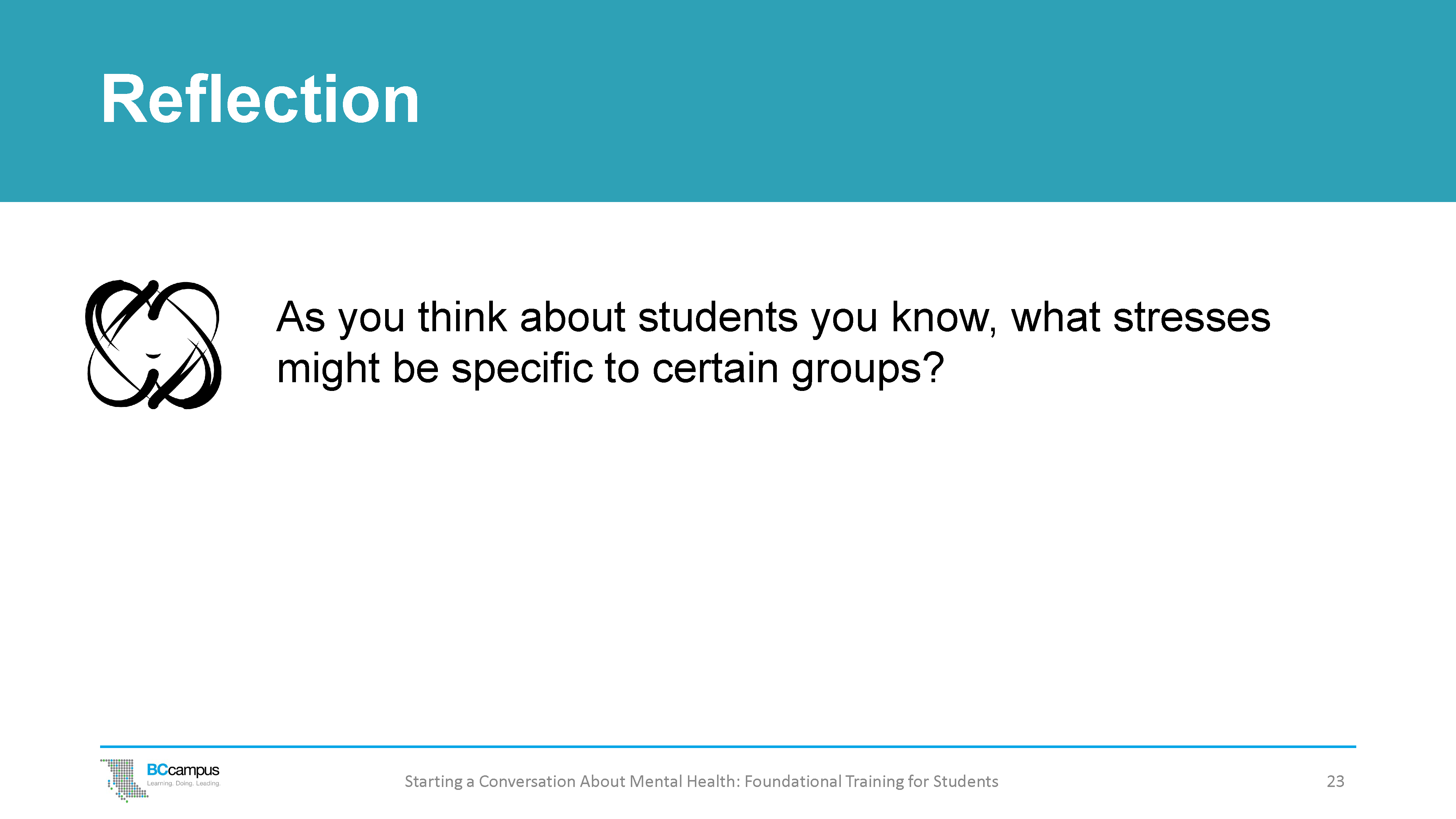
ACTIVITY: Reflection
Ask participants to think about the students they work with and consider the stresses that may be specific to certain groups.
You could also ask participants to discuss the services or supports they think might be helpful for students who experience discrimination or inequities. If participants don’t know, that’s okay. This is an opportunity to share knowledge, and you can mention that you’ll be discussing resources a bit later in the session.
Stress is an unavoidable part of post-secondary student life, but it isn’t necessarily a bad thing. This section helps participants rethink stress and consider how it can help them. It also uses the Wellness Wheel to examine healthy ways to cope with stress.
An interactive H5P element has been excluded from this version of the text. You can view it online here:
https://opentextbc.ca/studentmentalhealth/?p=70#h5p-7
These slides are available for use with this section of the presentation. For information about downloading the slide deck, see the Introduction.
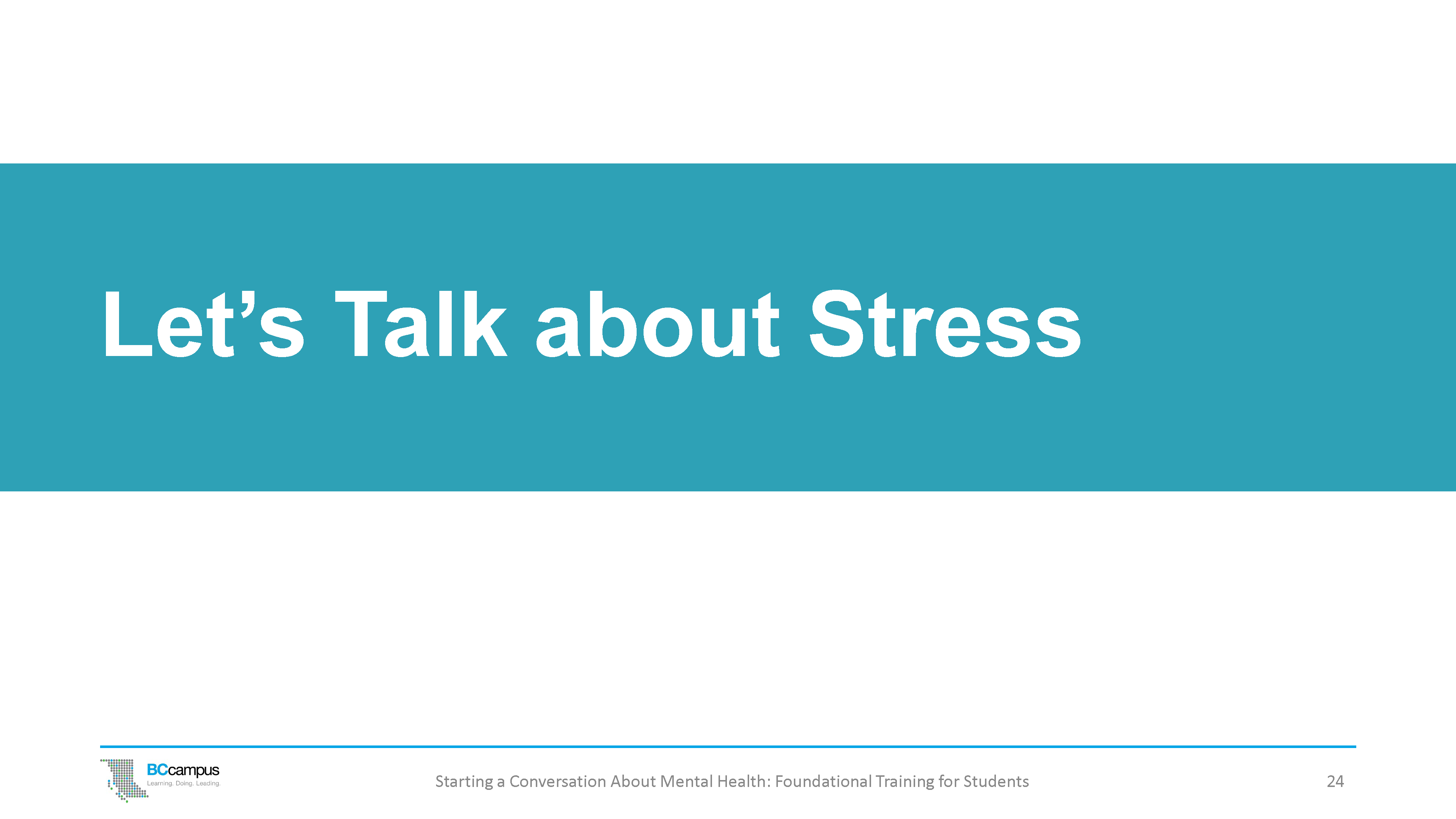
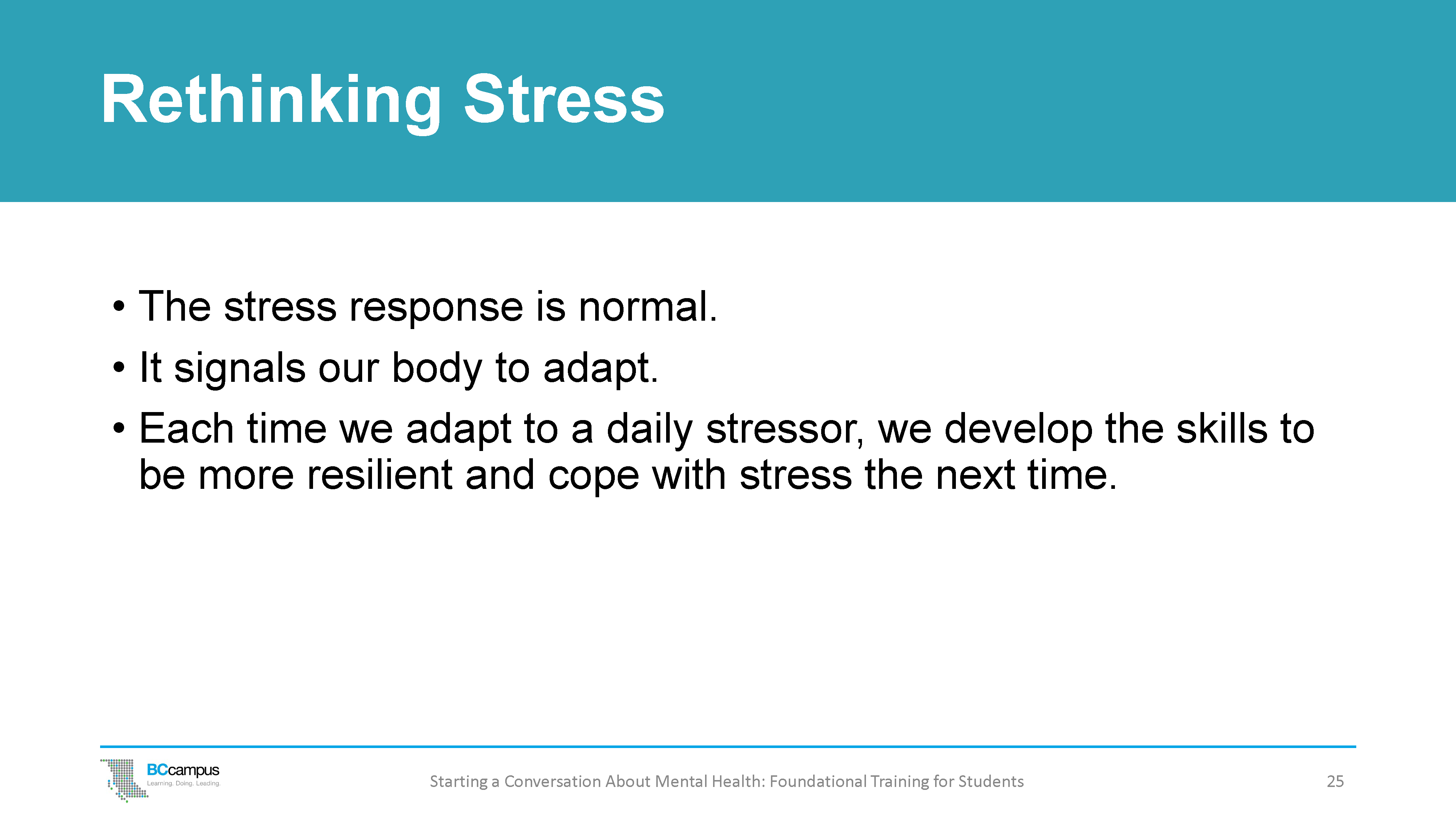
One of the most common challenges students face is stress. While stress and mental distress is part of the human experience, and definitely part of the post-secondary experience, people cope differently with stress, depending on their background, environment, relationships, and specific circumstances (e.g., living with an illness). In similar situations, two people may experience stress differently.
You need to take on reasonable challenges to help condition your brain for responding to stressors in order to become more resilient.
The stress response is a response that your body can use to prepare you for a challenge. As post-secondary students, it’s important to remember that you are here to learn and to grow, and with that comes challenges. If you experience the stress response as an opportunity to adapt, you can make stress work for you and help support your growth and resilience.
Remember:
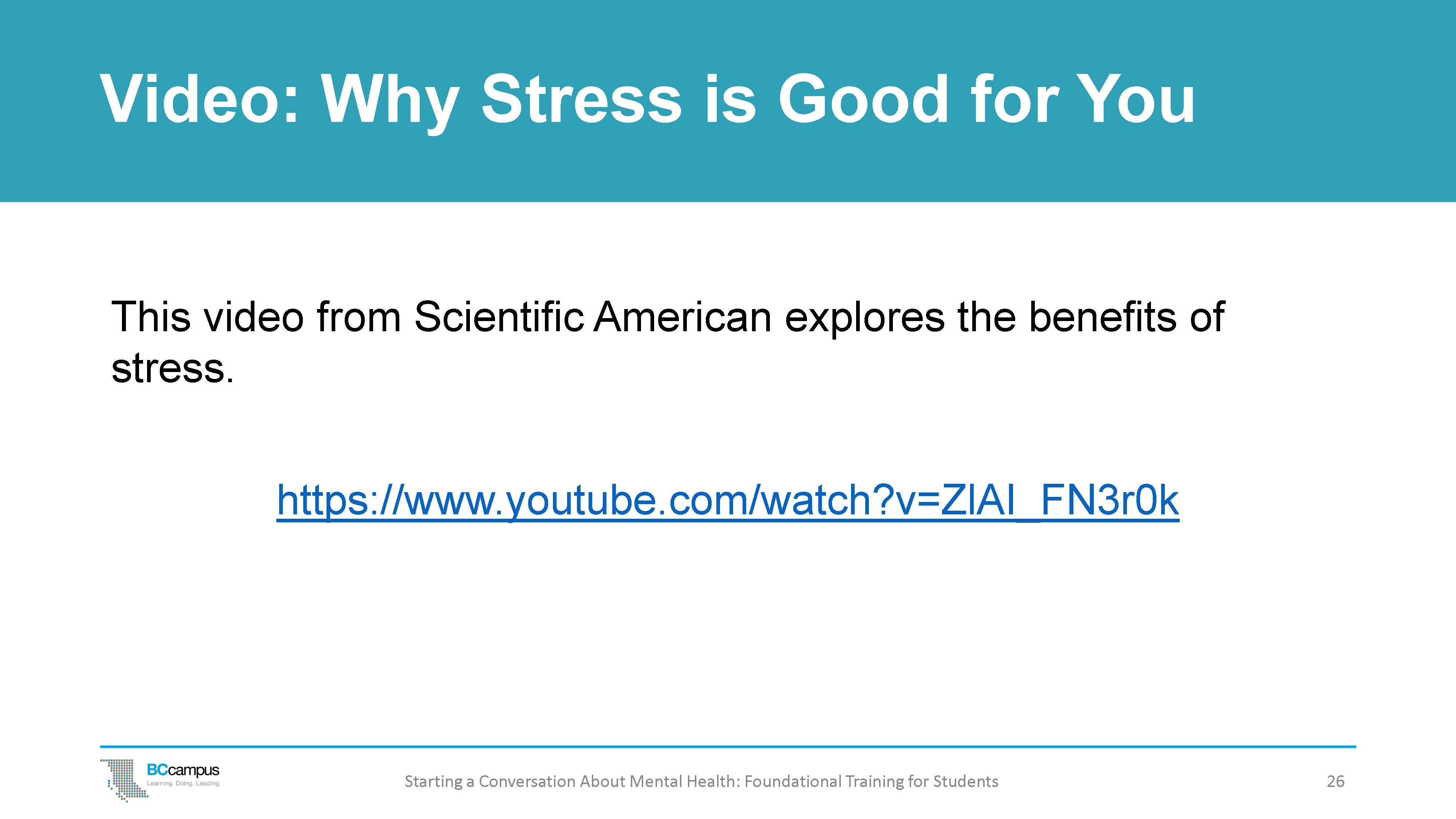
Video: Why Stress Is Good for You (2:32 min.)
This short video from Scientific American shows how stress can be viewed as helpful. (Show the video or share the link in chat): Why Stress Is Good for You.
In speaking about adapting when experiencing the stress response, we can think about ways to solve problems, try something new, or seek support. For example, you might feel stressed about starting classes online. Initially, you can acknowledge that, yes, this is a concern, then you can then move on to planning your time/schedule, setting up your work space, connecting with your classmates, and so on. Once you put this into effect, you’ve developed a new skill that can be applied to other scenarios.
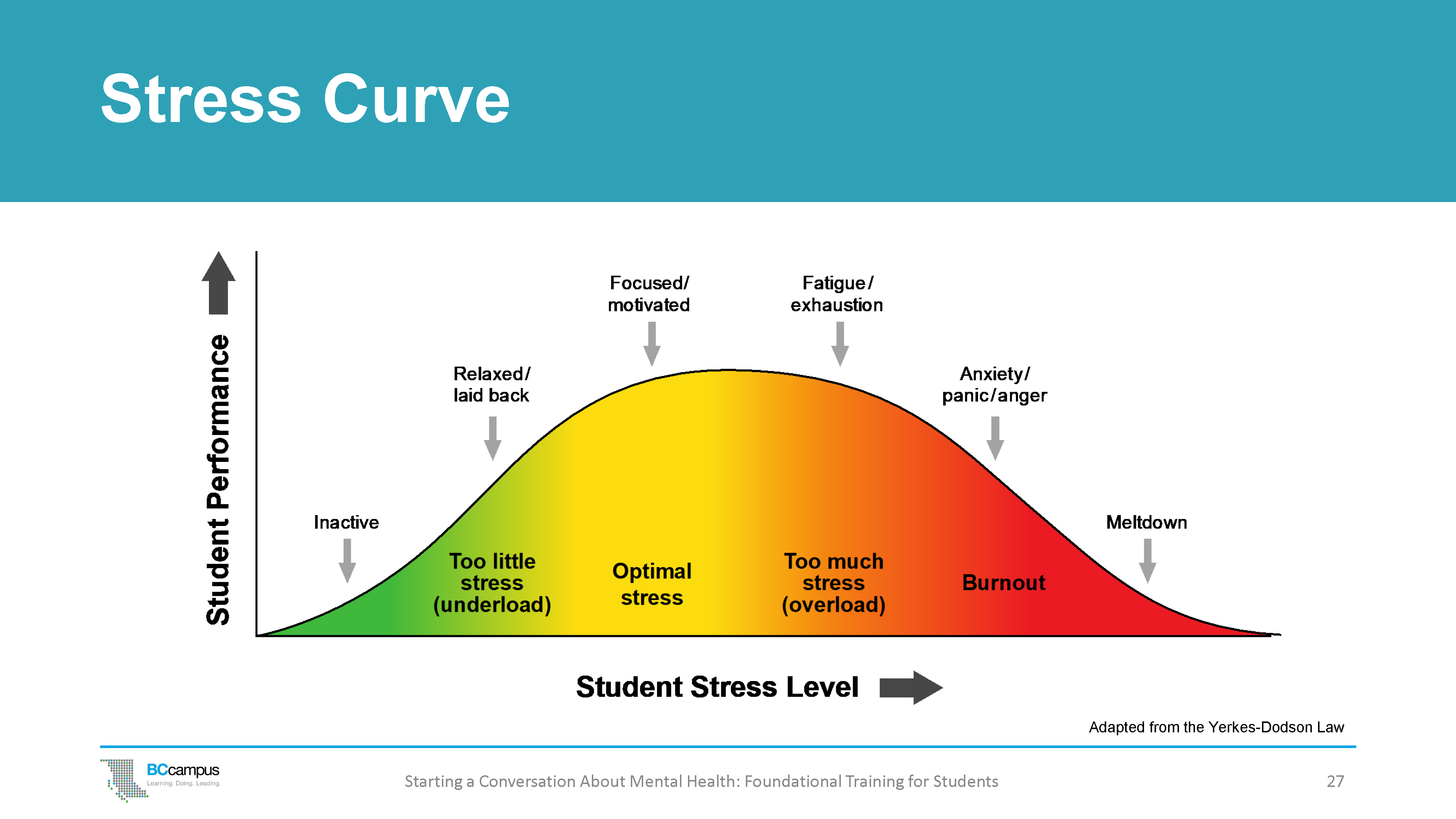
The Stress Curve shows that small amounts of stress help increase our alertness and energy for meeting challenging situations, but if stress lasts a long time or overwhelms our ability to cope, it can have negative effects.
The curve demonstrates that when performance demands are too low, we become bored and inactive. But as performance demands increase, our physiology kicks in and we start to feel alert and focused. We are motivated and we feel capable of dealing with the demands of life. However, when performance demands become too high – or we have become exposed to too many demands over a prolonged period – we become fatigued and experience a cascade of stress hormones that can wear us down. This can lead to problems with health, relationships, and work, and can affect our general enjoyment of life. Prolonged stress can often lead to burnout, serious illness, or mental health problems.

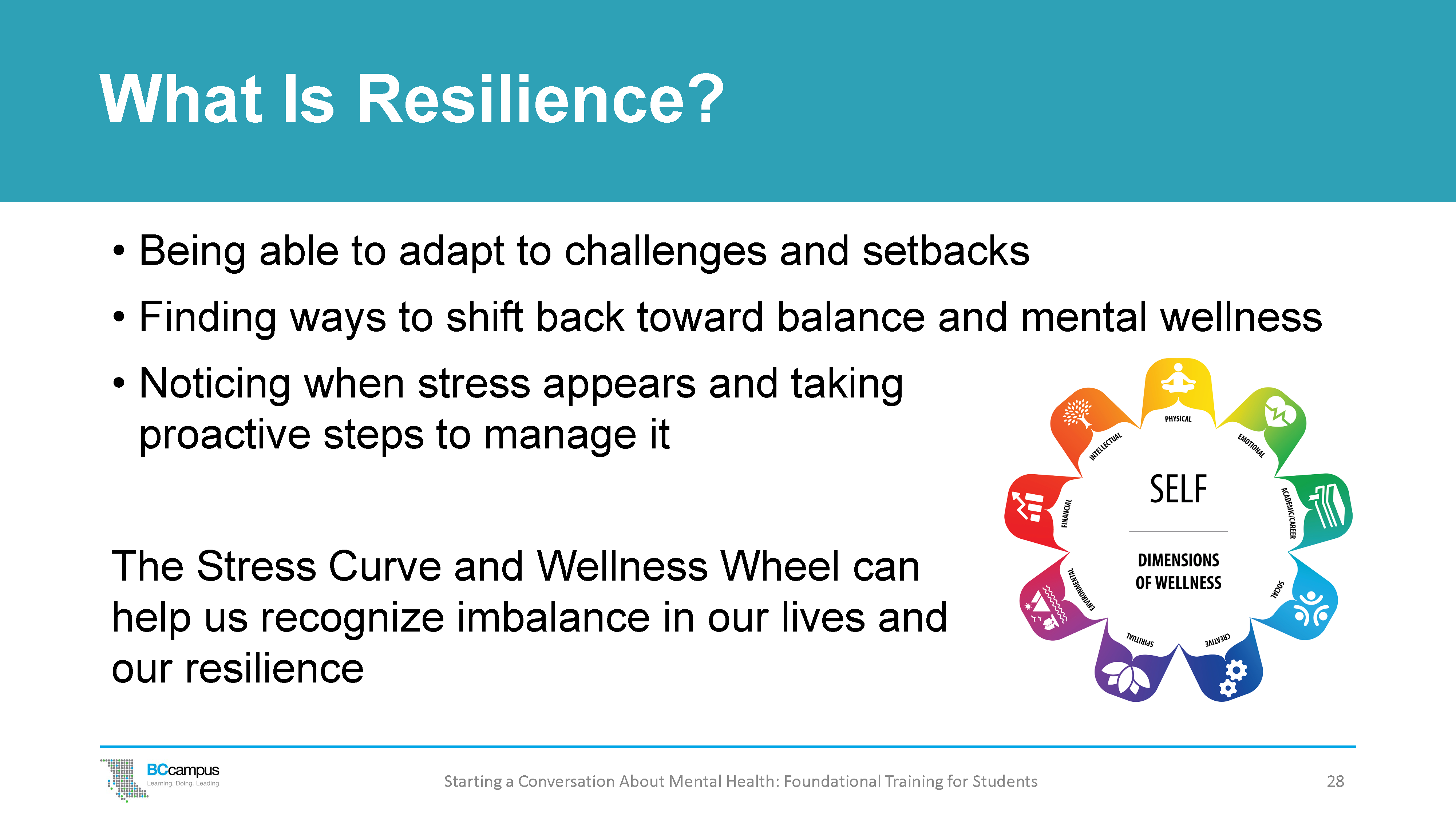
Resilience is about being able to adapt to life’s challenges and setbacks. When something is out of balance in our lives or we’re experiencing stress, resilience helps us to shift back toward balance and mental wellness. It’s the ability to adapt to difficult situations, and it can help protect us from mental health problems. Resilience isn’t about avoiding or ignoring challenges in life; rather, it’s noticing when stress appears and taking proactive steps to manage the stress and pressure.
The Stress Curve helps us recognize that some stress can be a good thing. The Wellness Wheel, which we discussed earlier, can help us recognize what might be causing stress or pressure in our lives. It also reminds us of our own resilience and strengths; while we may be struggling in one area, we may be doing well in many other areas.
Traditional Healing Practices
In many Indigenous cultures across Turtle Island (what we now call North America), Indigenous Peoples have used natural resources as a source of healing and ceremonial medicine since time began. These traditional healing practices are ways many Indigenous people restore balance and build resilience.
Below is one perspective on maintaining balance and wellness from Kwakwa̱ka̱’wakw culture. You can share this with your participants or consider reaching out to Indigenous Elders or Knowledge Keepers in your community to learn more about local traditional healing practices that you could share with participants.
In my culture, we use the roots of a yarrow plant steeped in hot water to make tea to soothe stomach aches, headaches, colds, and diarrhea. We steam cedar branches in a pot on the stove to help with respiratory distress. We burn sage to smudge and cleanse ourselves, our space, or items of negative energies or spirits. When we have painful or negative emotions or when grief, sadness, or loss overwhelms us, we are taught to go back to the land, to go back to the water, to reconnect with the universe’s life force. Doing this through ceremony can be simple or elaborate; we can do this in private or within a trusted community.
One way we refer to these medicines is as helpers. Water is a common helper many people use, going to a natural body of water and submerging themselves entirely so the water cleanses them head to toe. If you do not have access to natural bodies of water, stand in the shower – not a bath that you soak in, but a shower to let the water run over you. This can be a time to speak to your helper and share with it your burdens; tell it what is weighing you down and ask for the help you need, allowing all the negativity to flow off you with the water. End with words of gratitude for the support of that helper.
As each Indigenous community has its own sacred connections to its territory and the medicines and plants that thrive there, we encourage you to seek out Knowledge Keepers in your area to learn more. Observe protocol by approaching the Elder or Knowledge Keeper with deep respect and an offering of tobacco (loose tobacco as it comes in the pouch from any general store is sufficient) while asking them to share with you what their traditional helpers may be. Not all ceremonial or cultural knowledge can be shared freely with people outside the community, as some sacred knowledge is kept for the community alone. But what can be shared will be shared with a good heart, as it helps all peoples come together in harmony.
—Jewell Gillies (Musgamagw Dzawada’enuxw of the Kwakwa̱ka̱’wakw Nation – Ukwana’lis, Kingcome Inlet, B.C.)
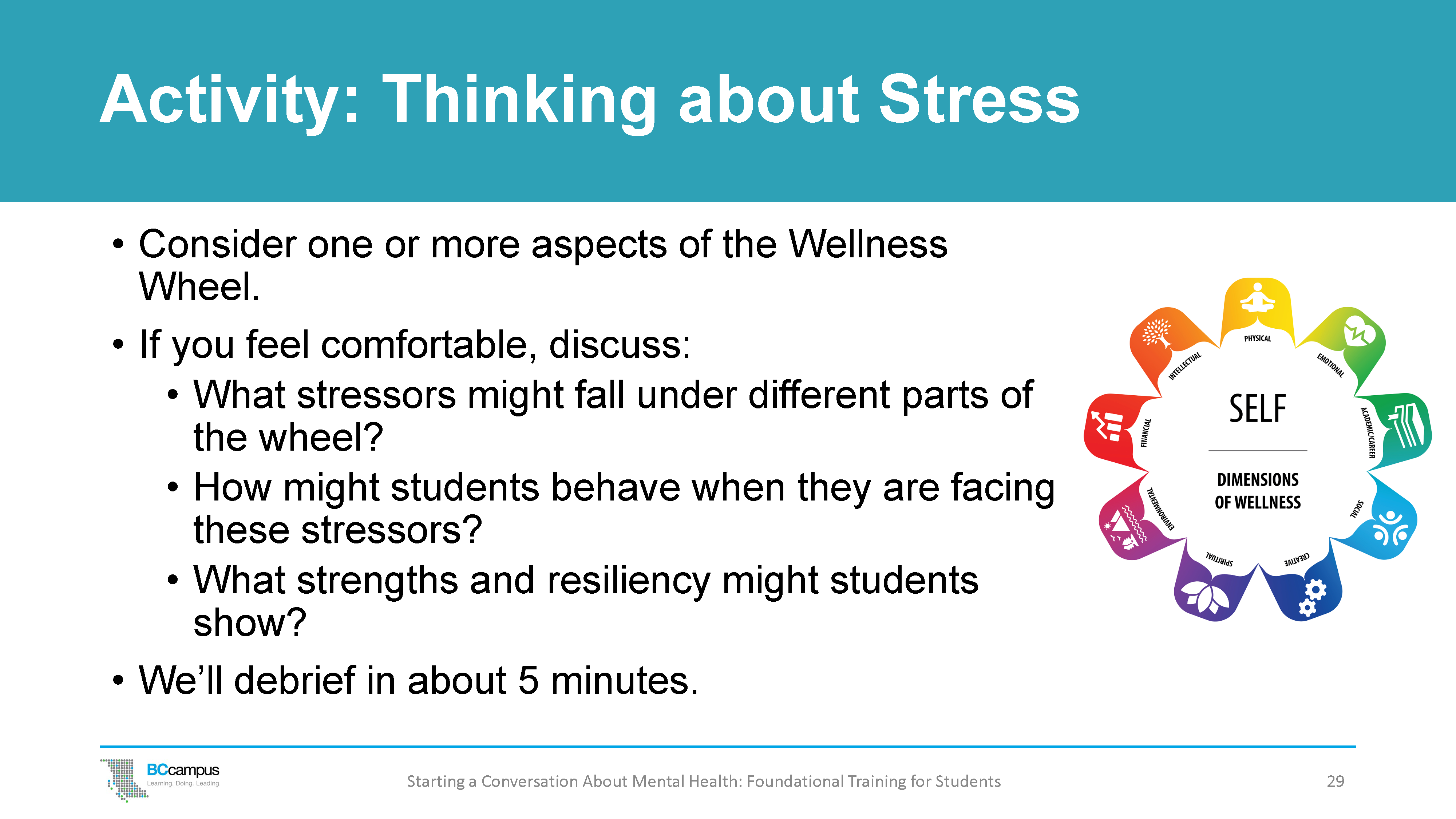
ACTIVITY: Thinking about Stress
Divide participants into small groups and ask each group to examine the Wellness Wheel and discuss the following:
Ask participants to also look at the Stress Curve to determine where various stressors might fit.
After about five minutes, debrief with the group. Some common stressors include:
There are things we can do to help us cope with stress. This section looks at key steps we can take to manage stress.
An interactive H5P element has been excluded from this version of the text. You can view it online here:
https://opentextbc.ca/studentmentalhealth/?p=76#h5p-8
These slides are available for use with this section of the presentation. For information about downloading the slide deck, see the Introduction.
How can we help ourselves and others who are experiencing the stress response?
The Wellness Wheel helps us to identify what might be out of balance and causing us stress. There are also three important steps to remember when we want to make stress work for us.
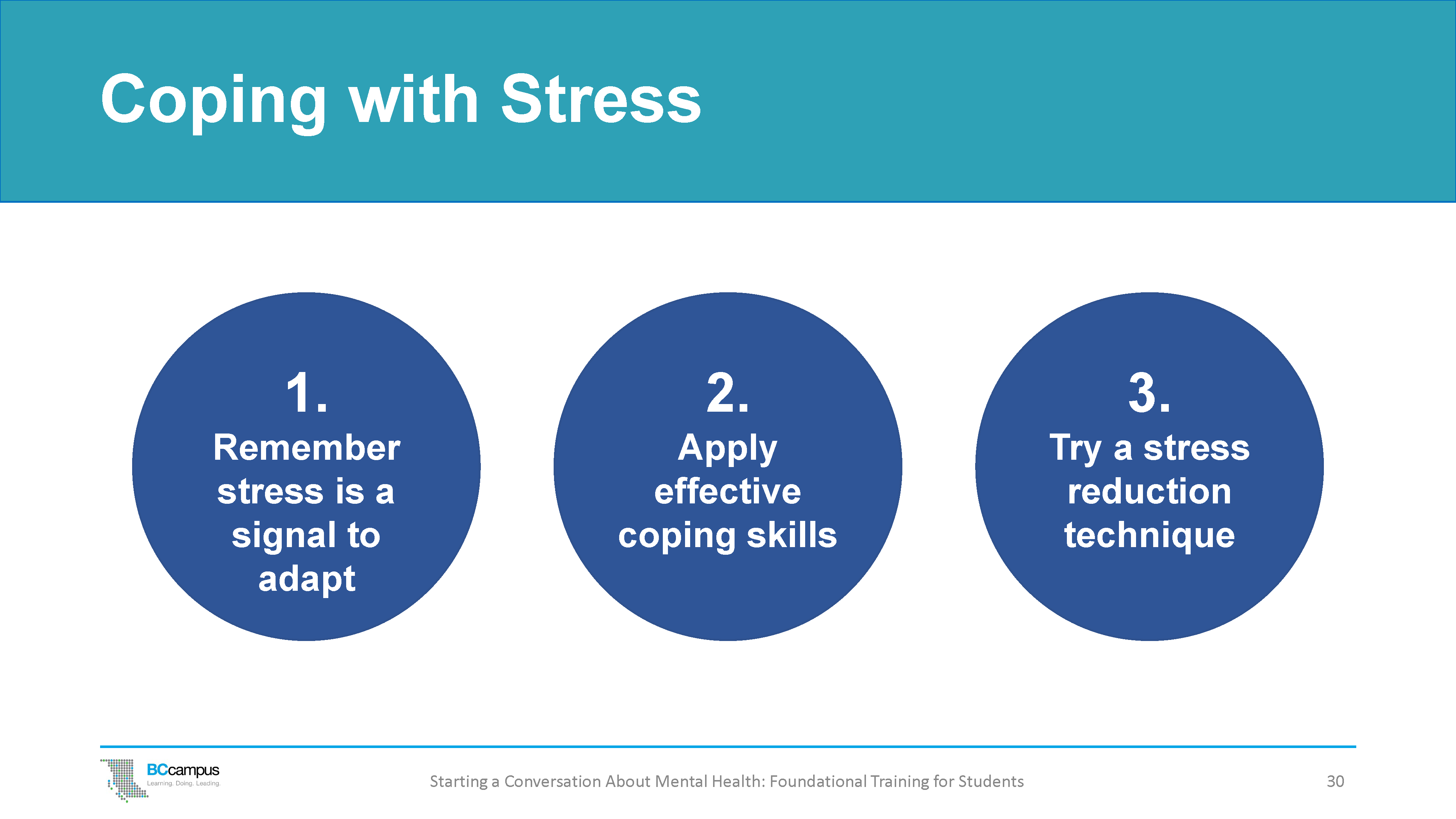
You may want to share Handout 2: Coping Strategies with participants now.
For example:
Before, during, or after a stressful experience, effective coping strategies include:
There are also things you can do on a daily basis to help you feel ready to face the various challenges in school, work, and life. For example:
Take care of the basics:
Make time to unwind:
Stay connected or get involved:
Refer to the Wellness Wheel for more ideas.
For example, try this box breathing technique. It can help bring your heart rate back to normal, so you feel a little more relaxed. Here’s how you do it:
If possible, sit and close your eyes. If not, just focus on your breathing.
Repeat this process as many times as you can. Even 30 seconds of deep breathing will help you feel more relaxed and in control.
Practising mindfulness can also reduce the stress response. Apps such as Headspace, Calm, and Insight Timer provide guided or unguided mindfulness options.
Global Events and Mental Health
Many global events have been shown to have an impact on mental health.
For example, most people experienced increased levels of stress and anxiety from the COVID-19 global pandemic. It activated the stress response for an extended and undefined amount of time, and as we navigate the aftermath of the pandemic, we are discovering its full impact on mental health. Many people experienced stress from the prolonged fear, isolation, disruption, and uncertainty that the pandemic created, and many will continue to feel these impacts.
COVID-19 also brought to light many inequities that exist within society, and Black Lives Matter amplified awareness of these problems. Many people – both Indigenous and non-Indigenous – were also strongly affected by the discovery of the unmarked graves at Indian residential schools across the country. These discoveries have retraumatized many Indigenous people, and forced many non-Indigenous people to reckon with the violent beginnings of our country and its colonial past and present.
Climate change and related disasters such as fires, floods, droughts, and extreme weather can also cause elevated levels of anxiety, stress, depression, grief, and post-traumatic stress disorders. The trauma and losses from a disaster, such as losing a home or job and being disconnected from one’s neighbourhood and community, can contribute to depression and anxiety.
Things to keep in mind about mental health and global events:
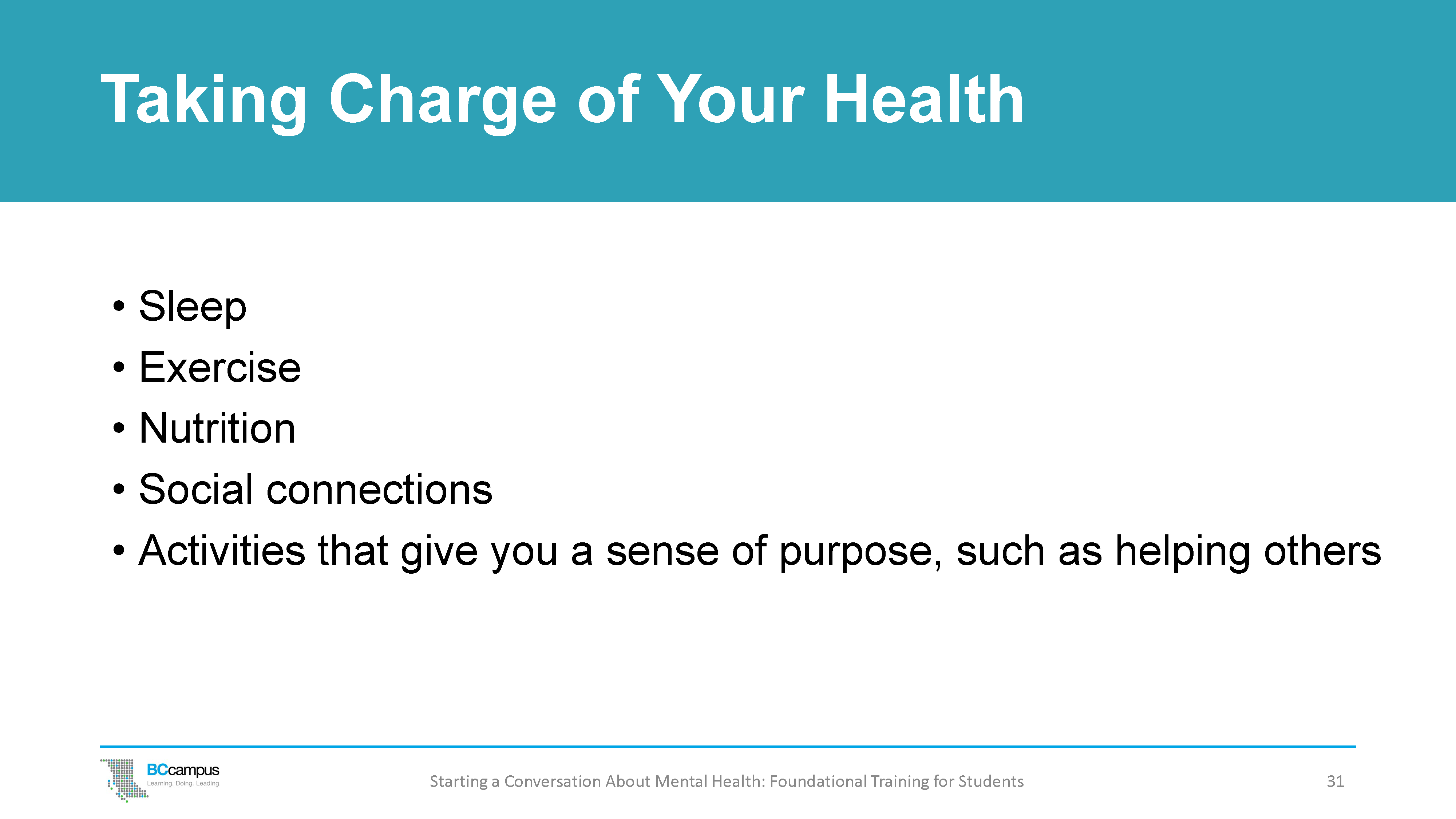
Another important aspect of dealing effectively with stress is taking care of your overall health so that you have energy and resources to adapt to the challenge you are facing.
Research shows that strategies for attaining and maintaining physical and mental health are the same:
Maintaining your physical and mental health is a lifelong process:
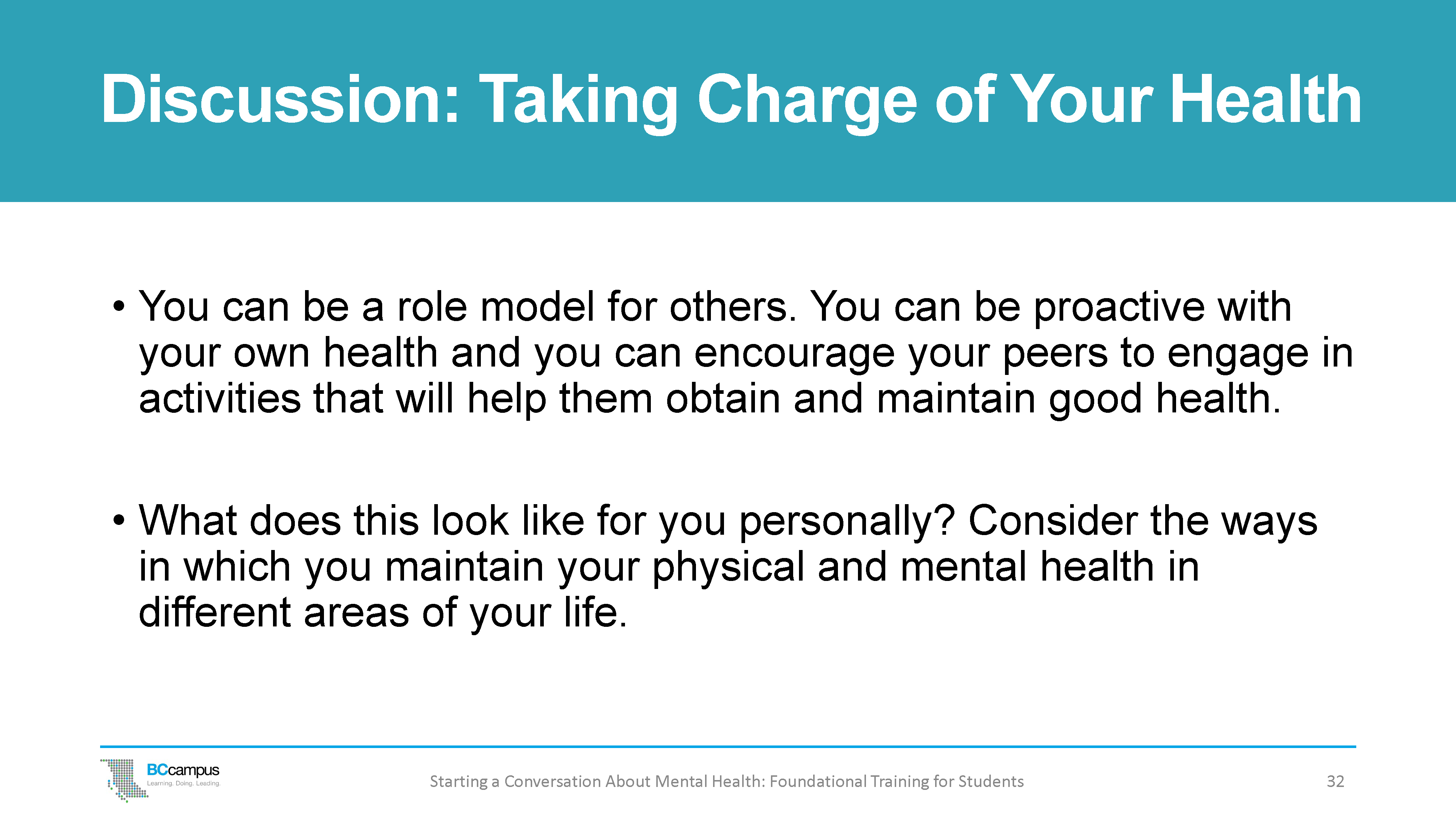
ACTIVITY: Discussion on Taking Care of Your Health
Have participants break out into small groups to discuss the following:
If you would like to give participants a short break, this is a good time to do it. It will give them a chance to get up and stretch and reflect on all they’ve learned about mental health and taking care of themselves before moving on to the next sections, which focus on how students can help other students who are struggling with stress or experiencing mental distress.
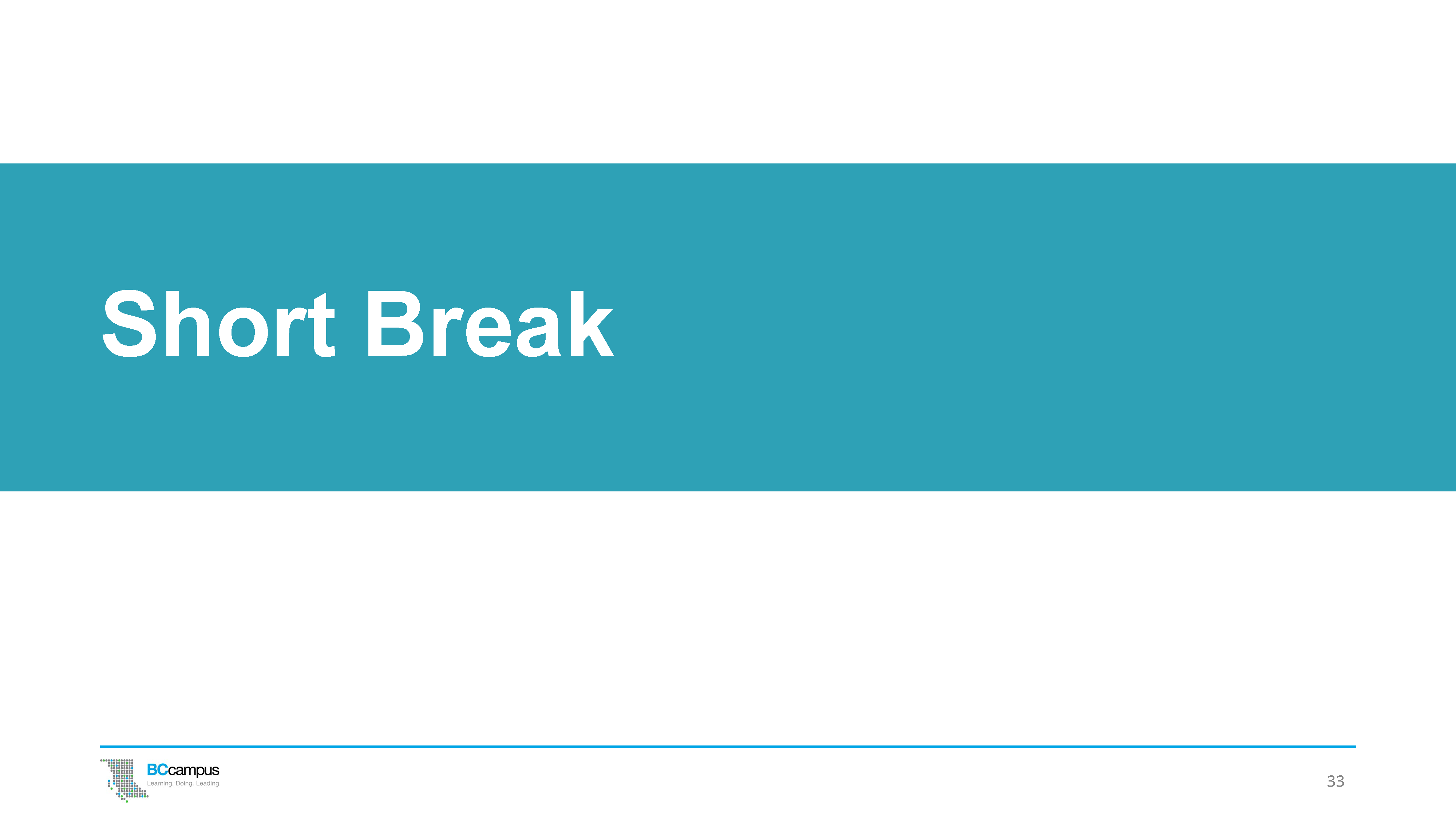
An interactive H5P element has been excluded from this version of the text. You can view it online here:
https://opentextbc.ca/studentmentalhealth/?p=88#h5p-9
These slides are available for use with this section of the presentation. For information about downloading the slide deck, see the Introduction.
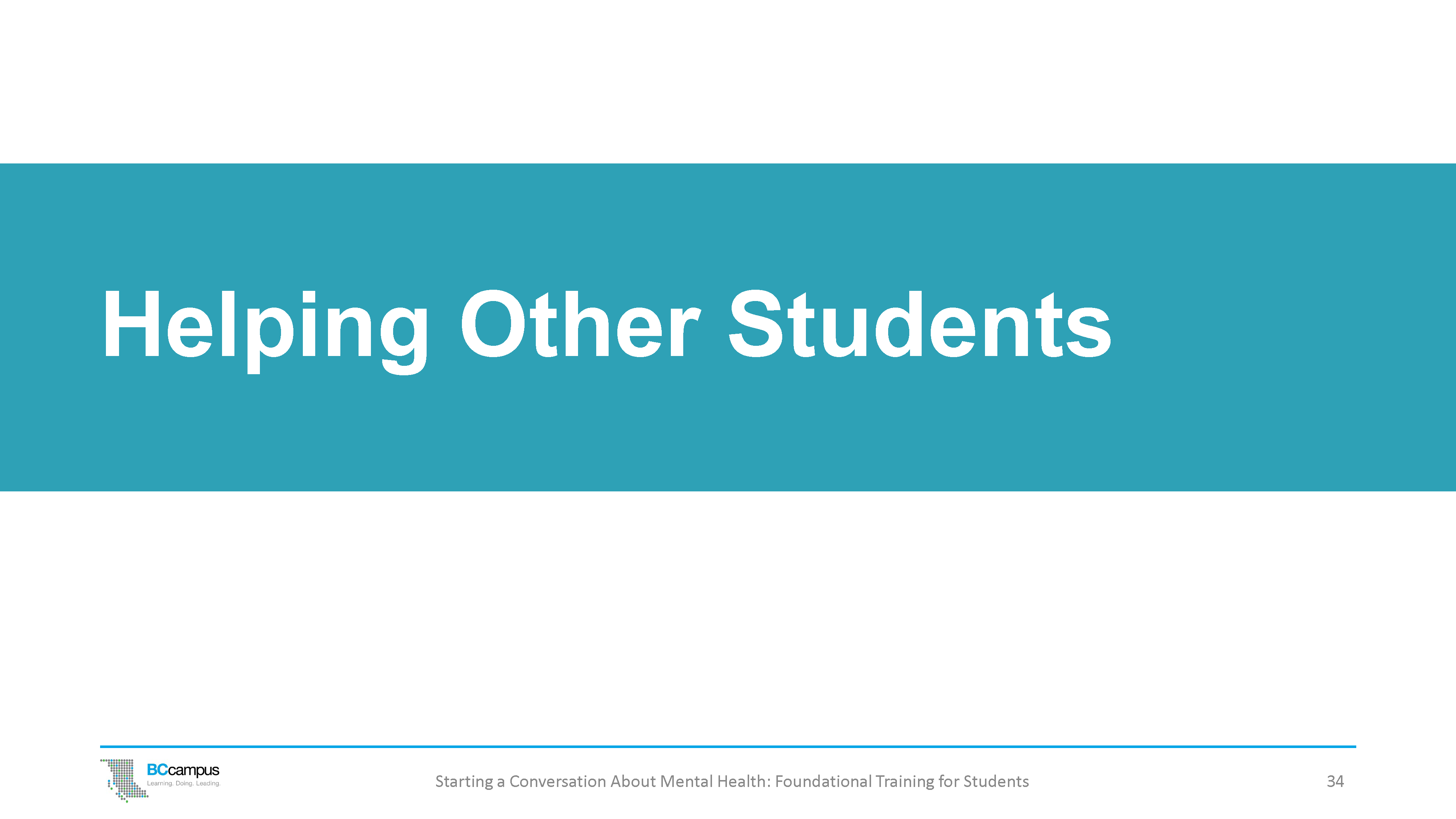
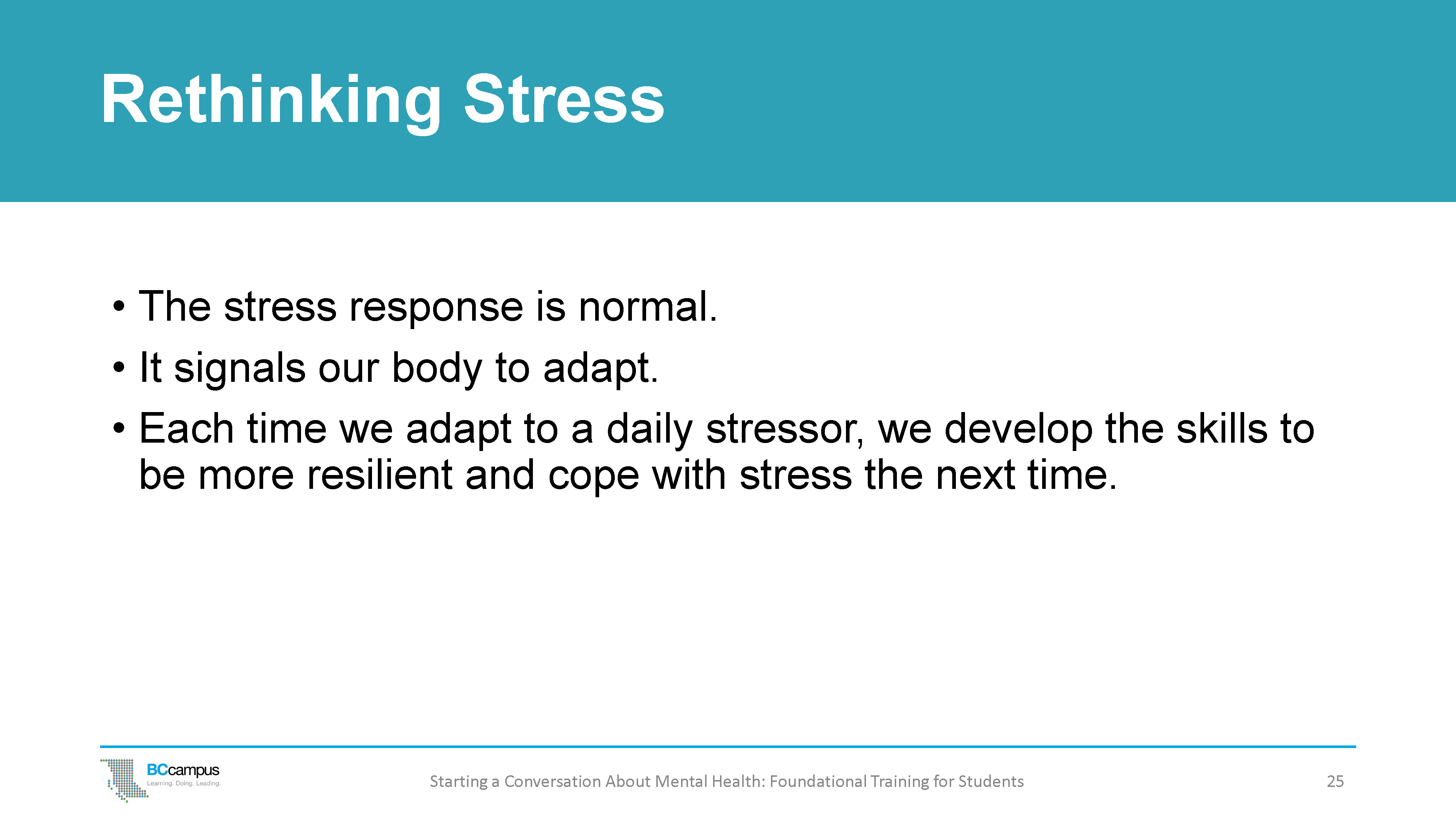
ACTIVITY: Reflection on What We Need When We’re Distressed
Think of a time when you were mildly or moderately upset or distressed yourself. Reflect on what you needed or hoped for at that time. What did you need or want from others? Please take a couple minutes to write some of your thoughts.
Give participants a few minutes to do this.
Then ask them to share one of the things they needed or wanted from others when they were upset or distressed. Remind them not to share the details of the event itself. (If you are presenting online, ask participants to put their answers in the chat box, and then read the responses from chat.)
Finally, ask participants to share one thing that wasn’t or would not have been helpful. (If you are presenting online, ask participants to put their answers in the chat box.)
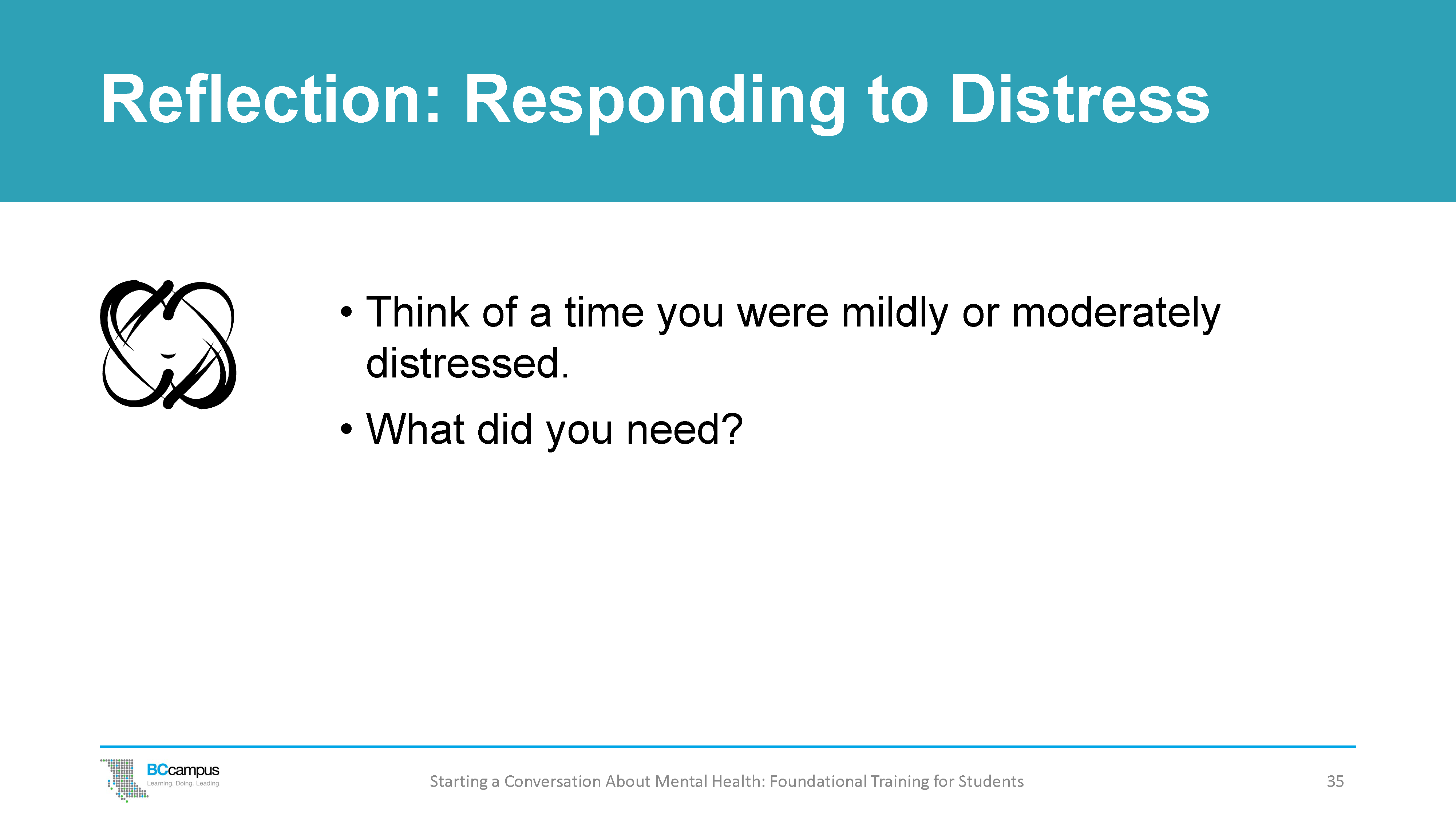
You have all had experiences with various responses when you were distressed. From your own life experience, you have developed an understanding of what is helpful that you can draw on when you are responding to other students. The responses you have identified as helpful are examples of an empathic response.
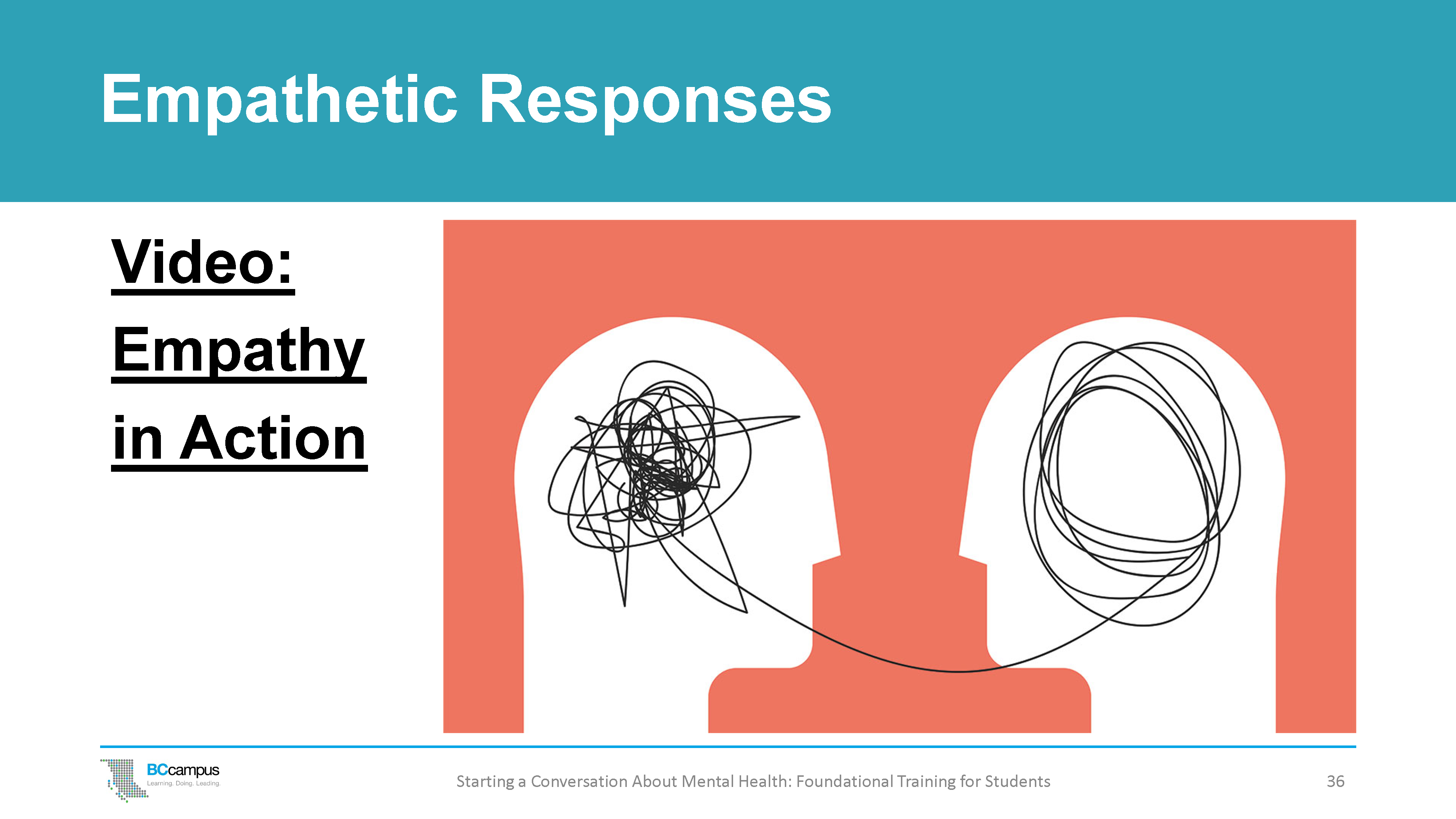
Video: Brené Brown on Empathy (2:53 min.)
This short video from well-known sociologist Brené Brown demonstrates how to respond in a helpful, compassionate way – empathy in action. (Show the Brené Brown video or share the link in chat): Brené Brown on Empathy.
ACTIVITY: Video Reflection
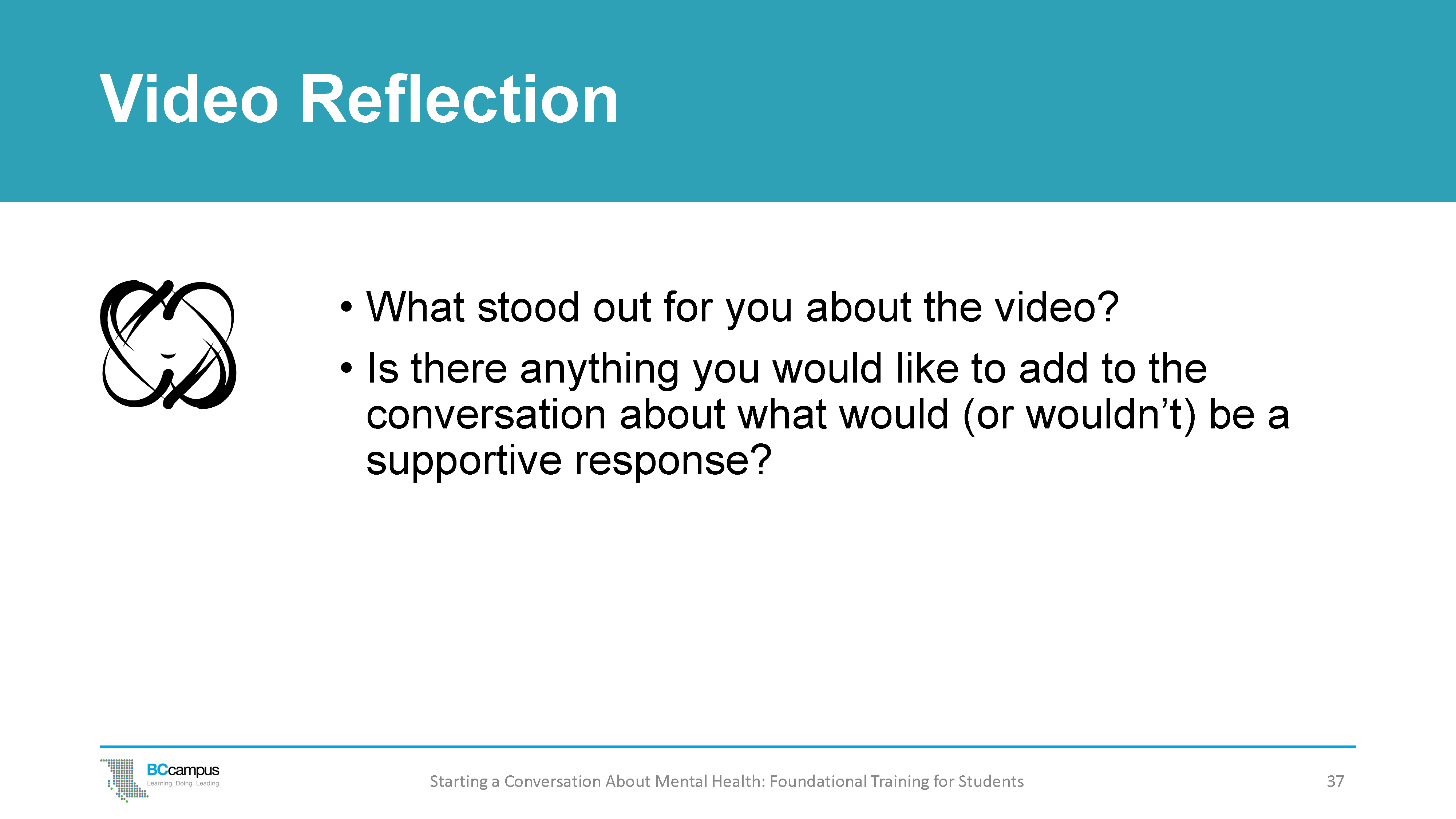
There is no script that you need to follow, nor one way that will always work. The most important thing is to be yourself and to be authentic – and this can include being honest when you’re not sure what to say.
The role of an empathetic listener is not to “fix” the student or tell them how to respond. Instead, it is to listen and try to help them find appropriate support. In many cases, it’s not the things we have to say that make the difference, it’s the things that we allow the other person to say and get off their chest that will make room for more life-affirming options to come forth. Just being there, giving support, and offering a listening ear can help create a turning point for a student who is struggling.
When responding to students in distress, maintain an appropriate balance between your desire to help and provide solutions and respect for the student’s autonomy and their own capacity.
It is important to recognize when others are experiencing stress. Here are the steps to take when helping another student.
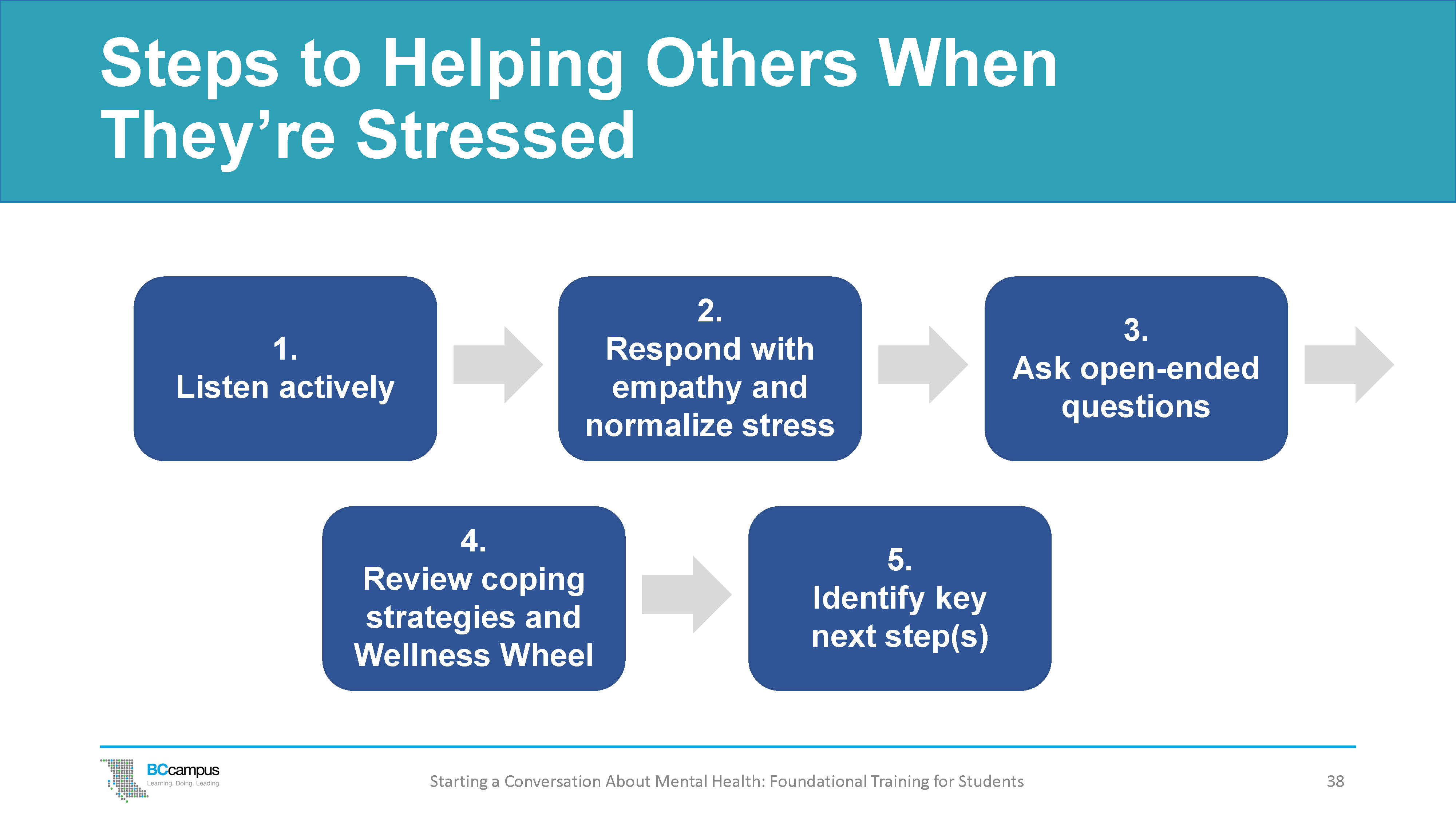
Refer participants to Handout 1: Wellness Wheel and pass out Handout 2: Coping Strategies.
Handout 1: Wellness Wheel and Handout 2: Coping Strategies, as well as active listening and responding with empathy, can be used together in peer-helping situations when the student you’re helping is experiencing the stress response.
Here are some steps you can follow in your interactions with your peers.
These first three steps may be all that are required. Sometimes connecting with someone else, feeling heard and understood, and having an opportunity to verbalize their struggles is enough to help a person move ahead. But sometimes a person might need some help in identifying the next steps, which is where the Coping Strategies resource comes in.
Ask the student what they would like to try (from the Wellness Wheel and Coping Strategies handouts, or based on what’s worked before).
Sometimes another student’s problems are more than you are able to help them with. It is important to remember that you are not expected to solve another student’s problems, and you are never expected to be a counsellor. There are many services and resources on campus and in the community that you can suggest they connect with.
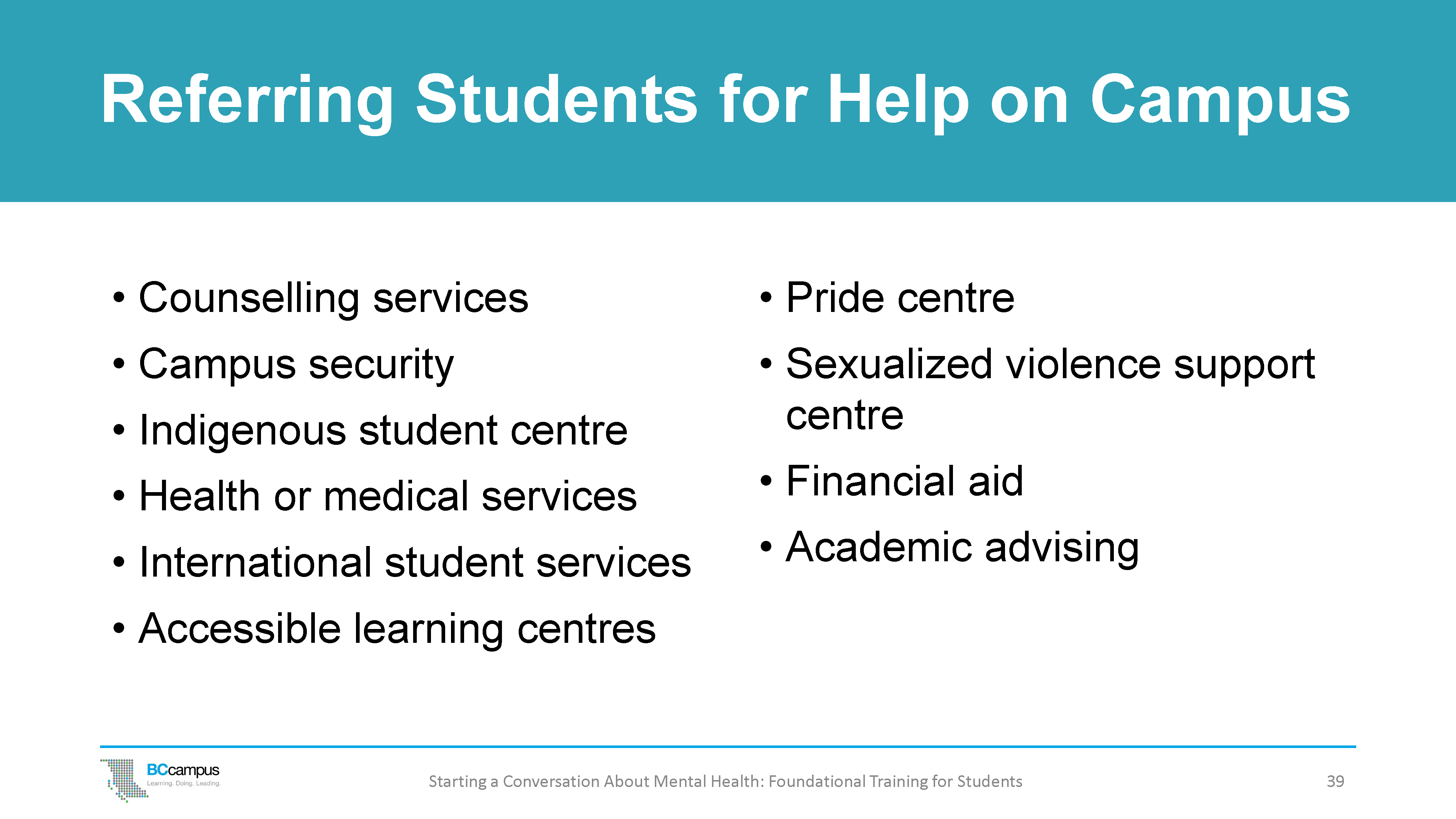
You may want to share Handout 3: Supporting Other Students: Mental Health Resources now.
Post-secondary institutions have a range of services and supports designed for students’ well-being. It is helpful to be aware of what is available on your campus, so that if you’re talking to a student who you think would benefit from extra support, such as a counsellor, you can encourage them to talk to someone.
What are some resources that you can think of at your institution? (You could ask participants to brainstorm resources on their campus that they’re familiar with. If you are presenting online, you could ask them to add their ideas into the chat.)
If you have a list with names and contact information for these services at your campus, share this information with participants.
Here are some of the services that are available at most campuses:
Support for Marginalized Groups
When a person has a sense of belonging and connectedness with family, friends, culture, and community, they are more likely to have good mental health. Unfortunately, not all students have this sense of belonging, and some students, such as Indigenous students, international students, students with disabilities, and students who are LGBTQ2S+, are at a higher risk of isolation and may not have the support they need.
For Indigenous students, you could reach out to the Indigenous student centre before talking to a student; a staff member or Elder can make themselves available to talk to a student immediately after you talk to the student, or they may want to attend the meeting.
For international students, international student services on your campus can be a great resource.
For students with disabilities, you could connect them with student services or the accessible learning centre.
For students who are LGBTQ2S+, you could refer them to student services, the pride centre, or an LGBTQ2S+ organization in your community so someone is available to talk to them and help them feel less alone.
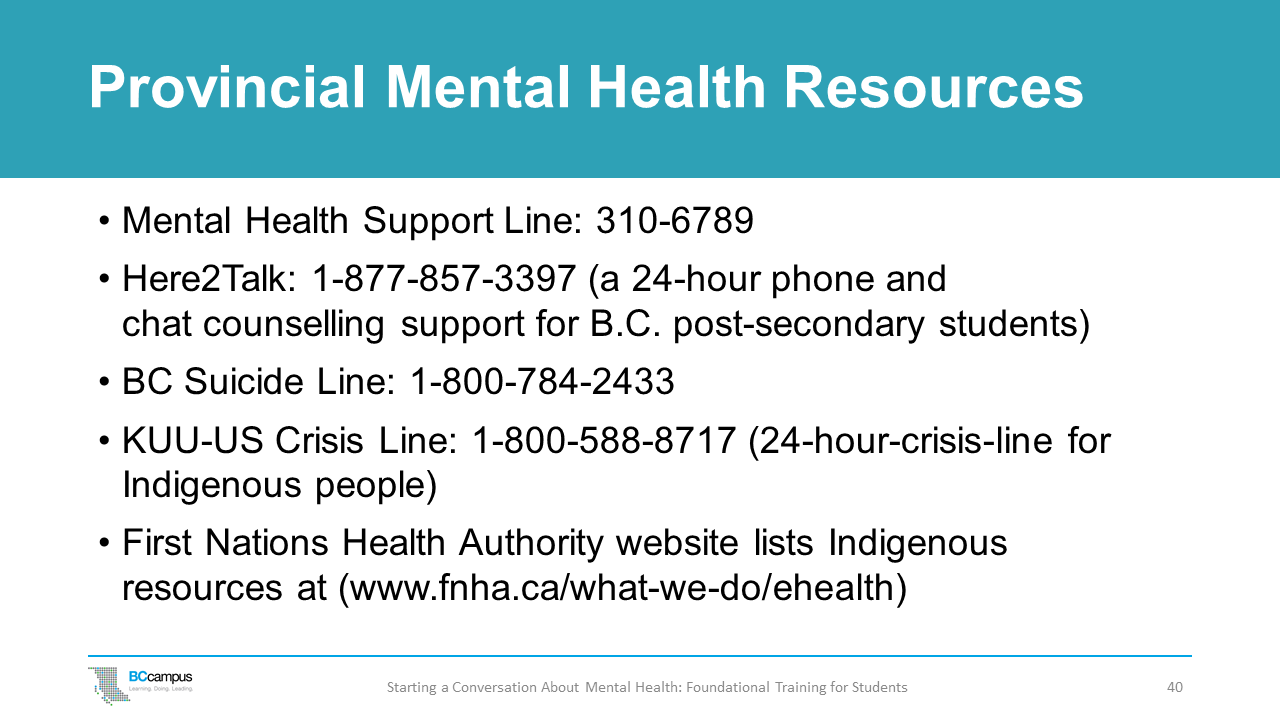
Some larger campuses have a crisis line for students. If your institution does not have this service, there are also provincial crisis and suicide lines that have 24/7 support. These crisis lines also provide support to anyone who is helping a student in distress and needs to talk to someone and debrief.
Provincial supports include:
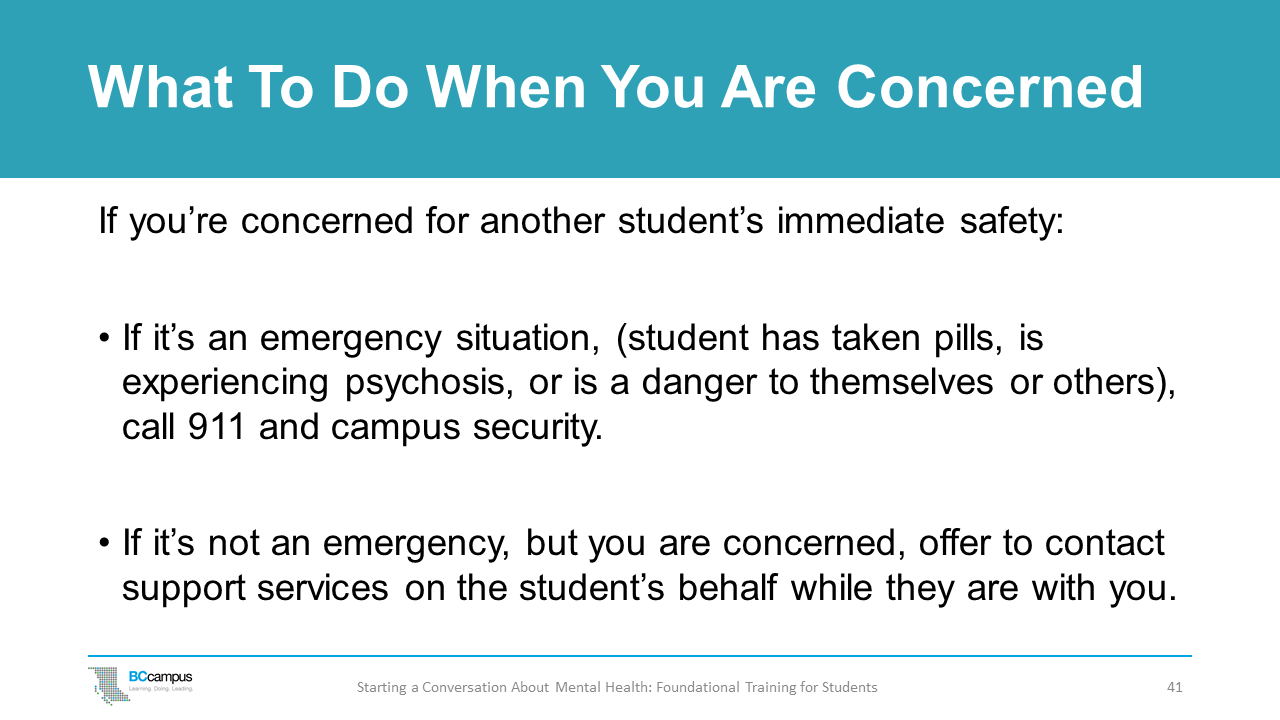
If you’re concerned for another student’s immediate safety:

Sometimes a student doesn’t want any help.
Your first step in these cases will be to consider safety: is anyone at risk of immediate harm, whether it’s the student or someone else? If so, share your concerns with a counsellor or someone who can help ensure safety. You should never assess the risk yourself – consult, refer, and if the risk is imminent, contact emergency services.
If there is no risk of harm to anyone, keep in mind that ultimately it is the student’s right to choose whether to seek help. Individuals are resilient and often come to their own solutions or find their own supports when they are ready.
Ensure that you are supported! Talk to friends, family, other instructors, an Elder, or a counsellor to share your concerns and decide how to proceed.
Please be aware that if you help another student access counselling services and are hoping to find out about the student, it is up to the student to give consent to release information. Unless a student gives permission, you won’t be notified of what has happened.
An interactive H5P element has been excluded from this version of the text. You can view it online here:
https://opentextbc.ca/studentmentalhealth/?p=94#h5p-10
These slides are available for use with this section of the presentation. For information about downloading the slide deck, see the Introduction.
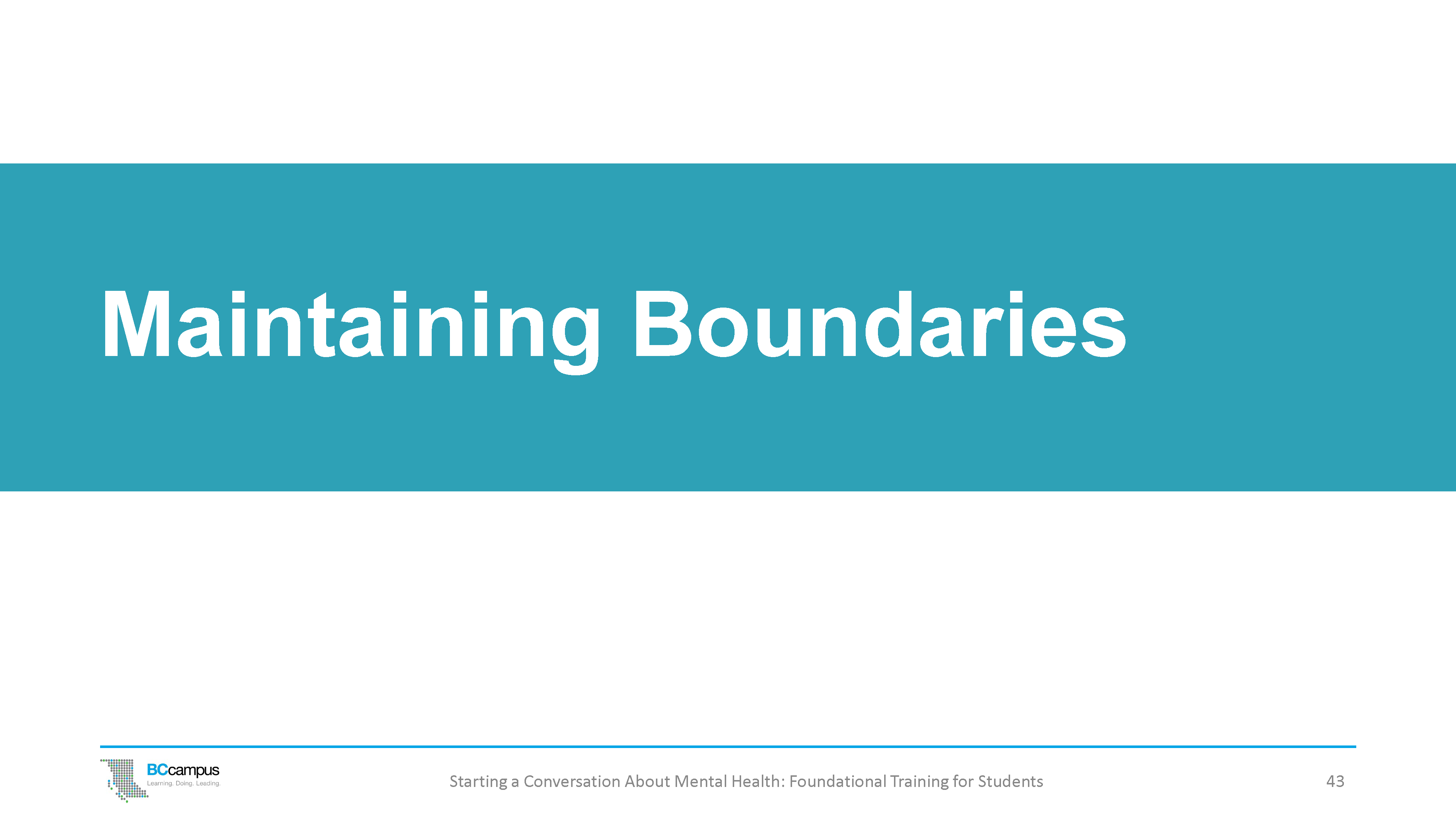
Sometimes when you’re talking to another student, you may realize that they need more support than you can give them. You may think they have a mental health problem or mental illness and need help from a professional. It is important to remember that you are not a counsellor and you should never diagnose another student’s mental health. You can, however, encourage the student to talk to a counsellor.
Remember: you are never expected to be a counsellor or to “fix” another student.
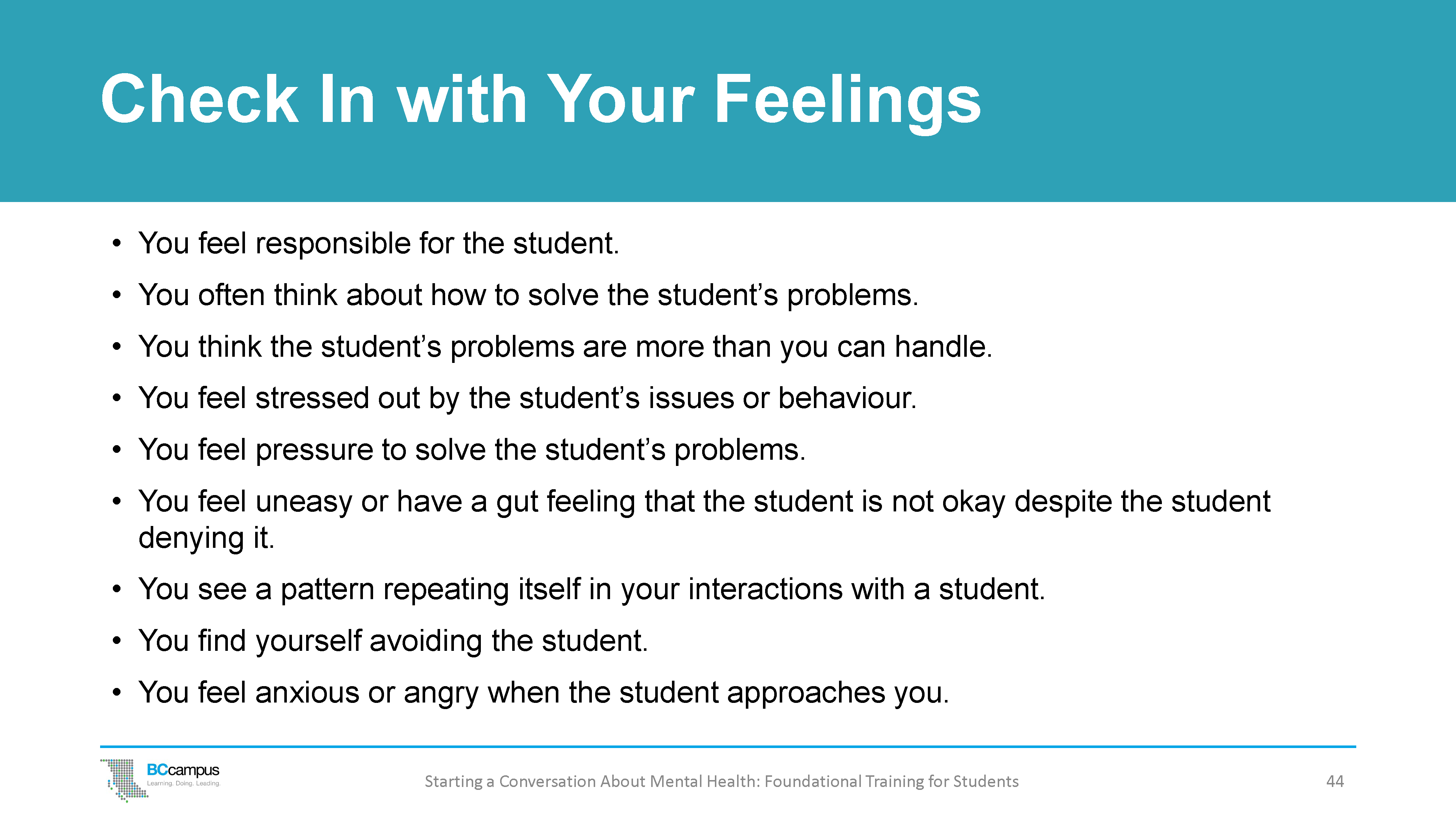
Here is a list of some of the feelings you might have as you try to support another student. These feelings may be signs that you are taking on too much and not maintaining boundaries. You may need to step back, consult, and take time for self-care. As you read this list, check in with your body and notice which of these resonate with you.
All of these responses are common, and we can all likely relate to many of them.
We all have our limits of comfort challenged in different ways. When you notice any of these responses within yourself, it may be time to consult or refer.
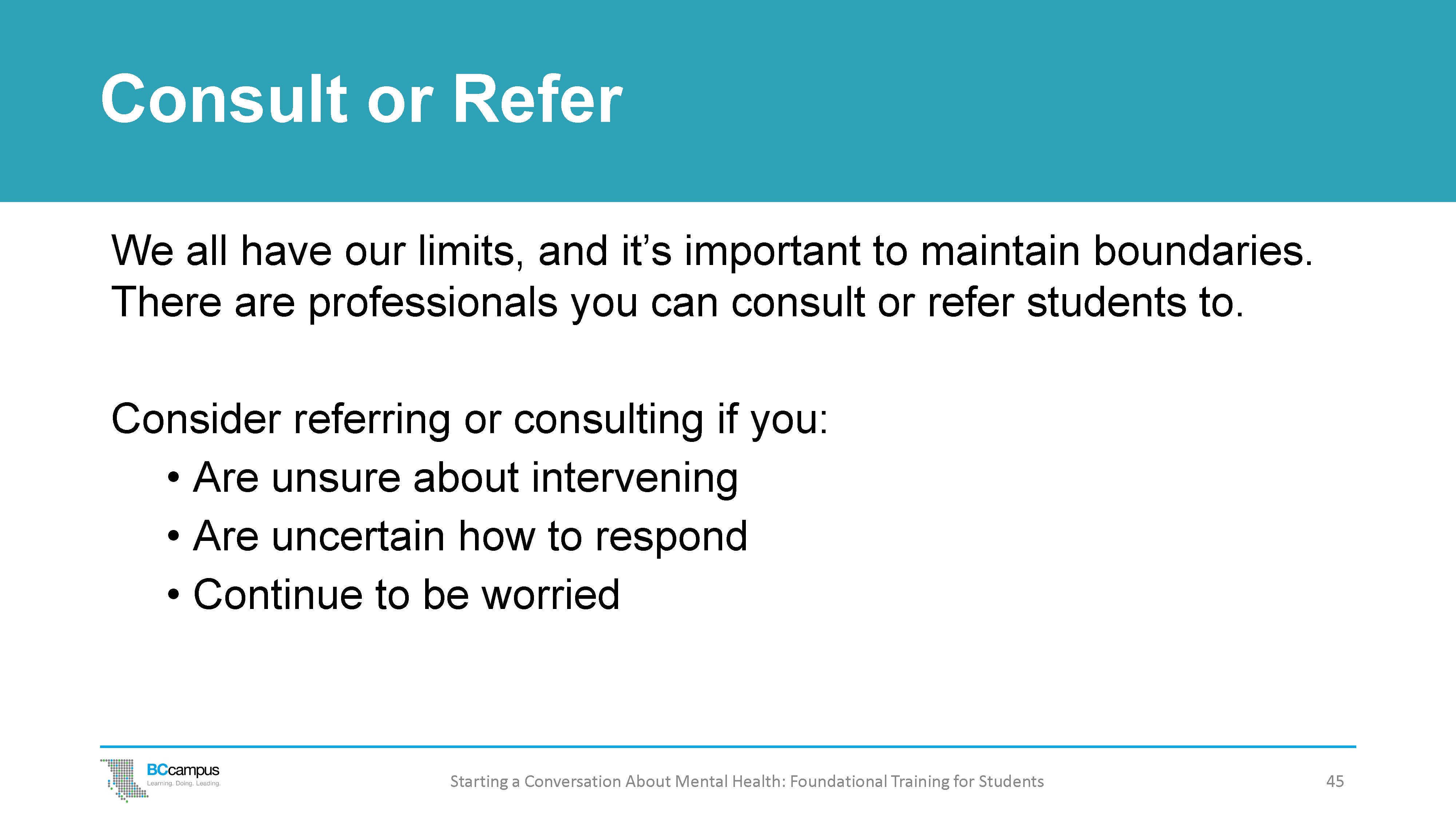
You can consult with campus counsellors, support services, or faculty and staff if you’re unsure about how to handle a situation. You can also call a crisis line if you have serious concerns about a student.
You are encouraged to consult when:
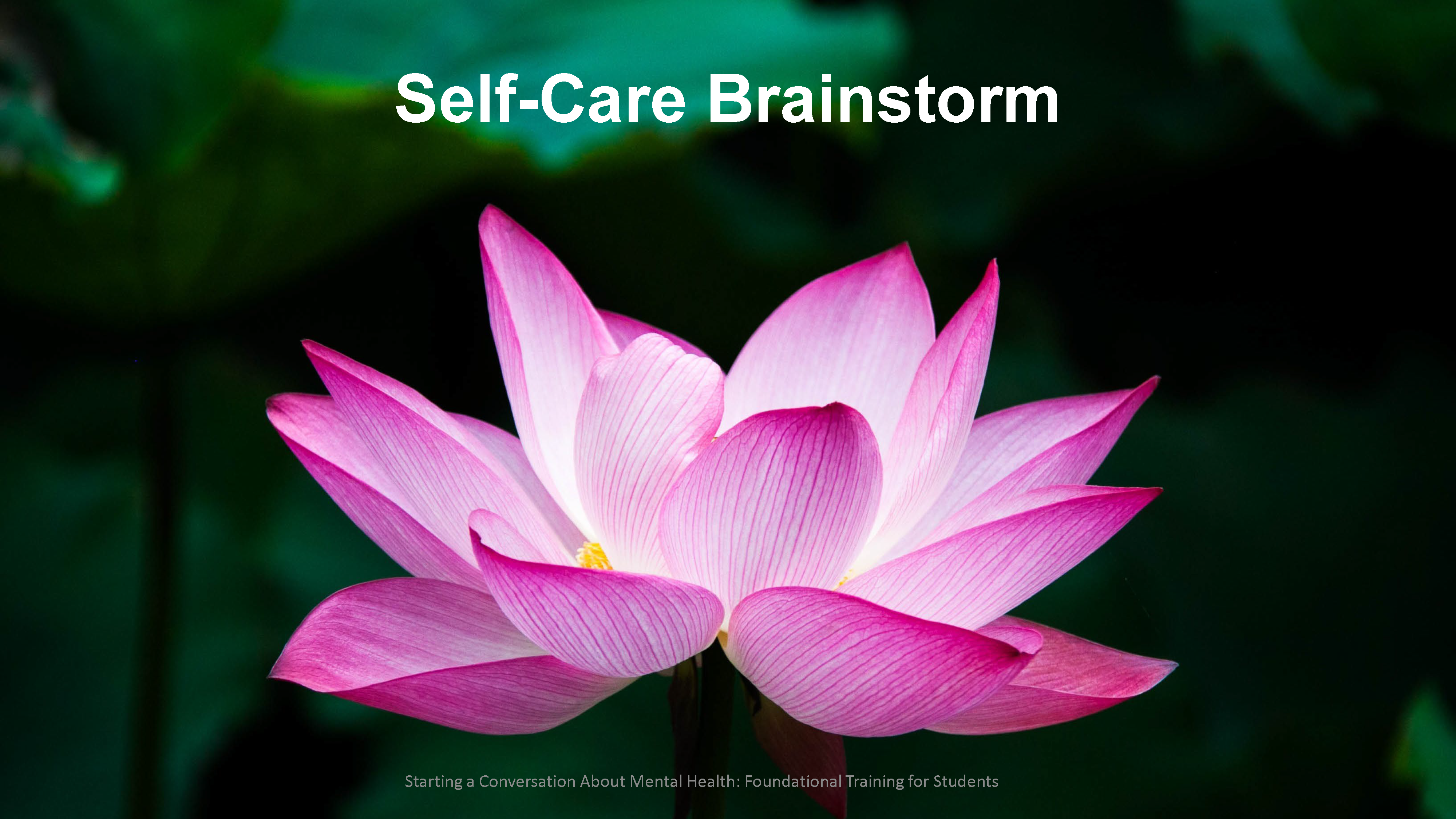
ACTIVITY: Brainstorming Self-Care Ideas
Ask participants to jot down a few ideas about how they can take care of themselves while still being open and available to offer support to fellow students.
If you are presenting online, ask them to add one or two thoughts into the chat.
This section includes scenarios for participants to practise using the knowledge they’ve gained.
An interactive H5P element has been excluded from this version of the text. You can view it online here:
https://opentextbc.ca/studentmentalhealth/?p=98#h5p-11
These slides are available for use with this section of the presentation. For information about downloading the slide deck, see the Introduction.
We are now going to focus on some scenarios to give you a chance to practice or think through how you would respond to different situations in which students are showing distress.
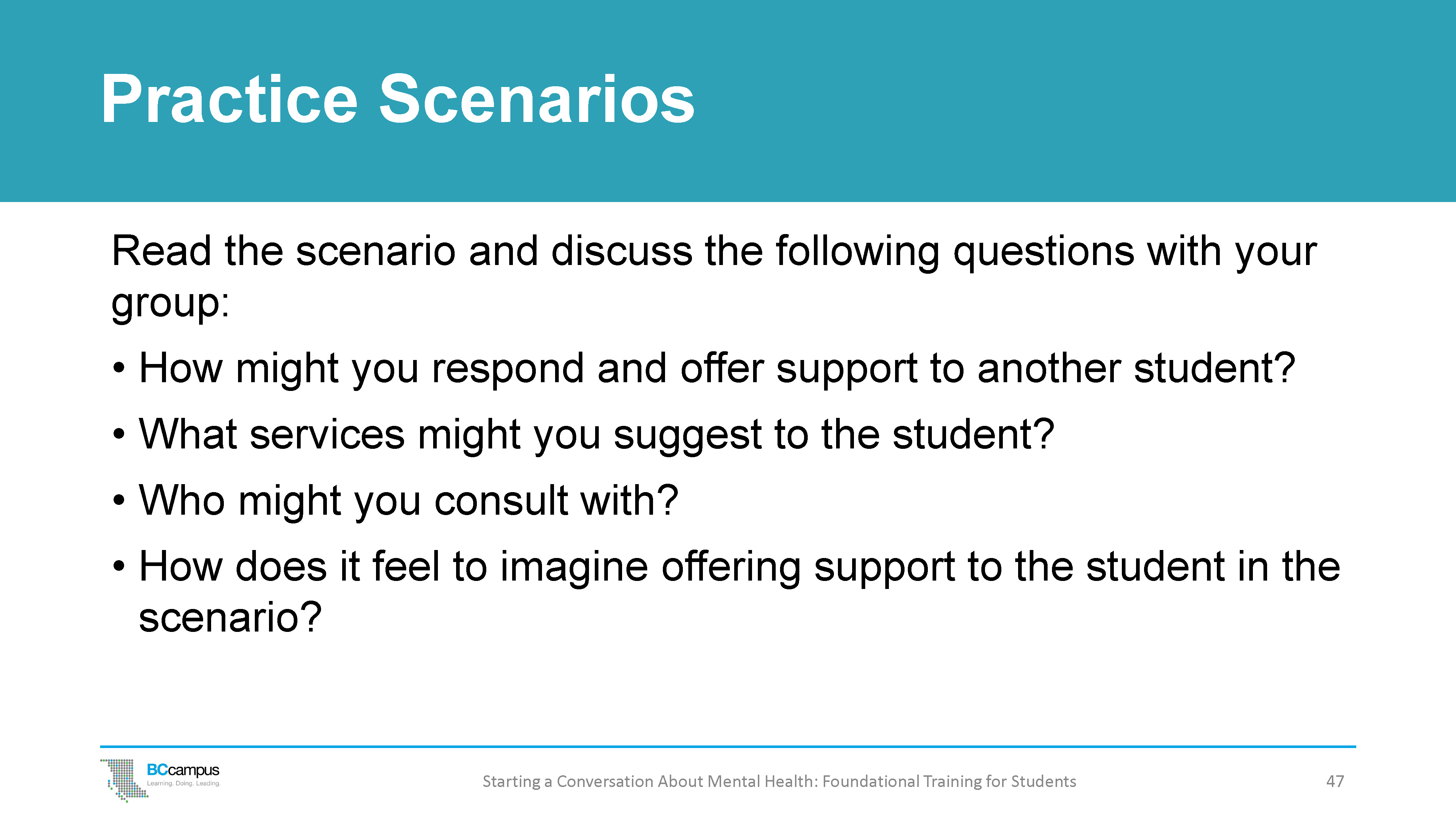
ACTIVITY: Practice Scenarios
Ask participants to work in pairs or small groups. Give each small group one of the scenarios in Handout 4.1 Scenarios for Practice and Discussion (no responses) to either role play or discuss how they might respond and offer support to the student in the scenario. (For online sessions, use breakout rooms.)
These scenarios give participants the chance to apply what they’ve learned about helping other students and think about what to say to students in different situations. It’s unlikely you’ll have time to look at all of the scenarios, but you can choose the scenarios that best match the interests and concerns of the participants.
Questions to discuss:
After participants have discussed at least one of the scenarios, discuss as a large group. You can share Handout 4: Talking about Mental Health: Scenarios and Responses with participants. If you don’t have time for practice and discussion, try to allow some time to briefly review some of the responses.
An interactive H5P element has been excluded from this version of the text. You can view it online here:
https://opentextbc.ca/studentmentalhealth/?p=98#h5p-12
Alex is a single parent who is going to school full-time and is unable to find reliable daycare. The daycare on campus is full and Alex is on a waitlist; all the other community daycares are also full. Alex’s daughter, Gemma, is a toddler, and Alex is wary of leaving her with a stranger. Alex has no family in the area, and friends are unable to help as they either work or go to school themselves. With final exams coming up, Alex is having trouble finding time to study and feels options are extremely limited or non-existent. Alex tells you they have been trying to study while Gemma sleeps but cannot keep it up for much longer because they are feeling so sleep deprived. Alex looks unkempt and has dark circles under their eyes; they look like they are about to cry and seem very stressed.
I can see you really care about your daughter and how important it is to ensure she is safe and well-cared for. I also see how hard you are working to do well by studying while she is sleeping. I admire and respect you for putting yourself through school while raising a child. Is there anything I can do for you right now that would ease your stress? (You could suggest a beverage or food or a walk or even a shower if they seem a little lost or unsure. Sometimes parents are so focused on their children, they forget their own basic needs, and taking care of some of them can help them focus and feel more grounded.)
I know it may feel like you are out of options, but perhaps we can figure this out together.
We can contact student services on campus. They may have a list of caregivers for this specific reason or resources/referrals for parents. We can also try Facebook and ask the community if they know of any reputable caregivers that have space for your daughter.
Perhaps it would be a good idea to speak to your instructors so they’re aware of everything that you’re juggling. They may be able to give you more time for assignments or may have resources or ideas you haven’t thought of yet.
© Dagmar Devine (CC BY 4.0 License)
You have been paired up with Leslie on a semester-long project in one of your classes. Leslie is upfront about being genderqueer and asks you to use the pronouns they/them. Leslie is enthusiastic, shows up to all the meetings, and completes their portion of the work on time. However, as the semester progresses, Leslie begins missing meetings, is harder to get hold of, and is either late with their contributions or the work is subpar compared with their earlier submissions. When you ask if everything is okay, Leslie admits they are going through a bad breakup and is having a hard time handling it. They are having difficulty concentrating on their work, they aren’t sleeping well, and they are drinking a little more than usual. Leslie tells you they are thinking about dropping out and don’t know what to do.
I’m sorry to hear about your breakup with your partner. In my time working with you on this project, you have been diligent, hardworking, and enthusiastic. I can see your situation is causing you a lot of stress and sadness and distracting you from your studies. Have you spoken to anyone about this? Do you have support at home or with friends or family? The school has some excellent LGTBQ+-friendly counselling services you can access as well. Maybe it would help to talk to someone about what you are going through?
I know you’re having a really hard time and I commend you on continuing to show up and trying the best you can; it’s a testament to your resilience. Although we do need to complete our project, I’m flexible in how we continue with it. Is there anything we can change to ease some of your stress, such as working on it together instead of separating the work and then meeting?
© Dagmar Devine (CC BY 4.0 License)
You are in class when the instructor begins talking about Canada’s residential school system and the abuse and forced assimilation of Indigenous children. As the lesson closes and students begin to pack up, you notice that a usually gregarious Indigenous student is sitting quietly and appears to be wiping tears from their eyes. When you approach the student, they tell you that their grandmother was in a residential school and they found the lesson very triggering.
Thank you for sharing that with me. I noticed you were tearful, and I’m very sorry that you’re upset. I won’t pretend to know exactly how you’re feeling, but I understand there is intergenerational trauma related to the residential school system. If you feel comfortable, please tell me more about how you’re feeling and how you’ve been affected.
Can I assist you in accessing Indigenous services? There are staff on campus who can connect you with Indigenous Elders and counsellors. If you’d like, I can also talk to the instructor about providing trigger warnings on content like this in the future, or I can support you in contacting the instructor.
© Jenny Guild (CC BY 4.0 License)
You are part of a study group that has been meeting regularly through the semester. Recently, one member’s attendance has become sporadic. When they do show up, their appearance is dishevelled, and they seem to have a hard time concentrating. When you ask them about this, they confide that they have been evicted from their apartment and must live in their car for a few weeks until they can afford a deposit on a new place. They explain that it’s hard to find a quiet and comfortable place to study or sleep, and their coursework has suffered as a result. They also tell you that they feel a lot of stress and shame about the situation.
You have nothing to be ashamed of; many of us have gone through financial hardships through no fault of our own. I understand it must be a stressful situation, and I will respect your privacy. Can I connect you with some services that might help you at this time? Financial aid has scholarships, bursaries, and assistance programs that could help you financially. There are food bank programs and shelters in the community. A counsellor could help you deal with the stress. And if you need a quiet place to study, there is always the library and campus study spaces. I can show you these spaces and support you in accessing these resources.
© Jenny Guild (CC BY 4.0 License)
Alexa, a transgender student, approaches you after a LGBTQ2S+ meetup on campus. She tells you that one of her instructors refuses to call her by her name, stating that “preferred names” are optional as per school policy. Occasionally, the instructor will use Alexa’s name, but will self-edit it; for example, calling her “Alex” instead of “Alexa.” The student feels disrespected and humiliated by her instructor during class, so if she does attend class she sits in the back and doesn’t participate very much. She explains to you that she needs to do well in the course so she can get into the program she wants. She expresses feelings of sadness, hopelessness, and frustration during this interaction.
Thank you for sharing your story with me. I’m sorry this happened to you. It must be so frustrating for your instructor to not understand trans reality. I can appreciate how your instructor’s behaviour is impacting your well-being. You are valued, and there are many people and services that can support you through this.
How can I help? I hear that you’re feeling sad and hopeless, and I’m concerned. Would you like to talk to a counsellor on campus? Counselling is confidential and free for students. I can walk with you to counselling services if you like, or I can give you their location and contact information. Another option is I could help you connect with the pride centre. They have free short-term counselling as well as sliding-scale or low-cost long-term counselling services. I can also give you the online crisis resources so you can access them if and when you’re ready. Is that okay with you?
If you like, we can also speak to the student union on campus to discuss mediation if you want to talk to the instructor or the director of the department about this. I can walk with you to the student union, or I can give you their location and contact information. I can also be present to support you throughout this process as well.
© Arica Hsu (CC BY 4.0 License)
Resources for Supporting LGBTQ2S+ Students
When speaking to a transgender student, use the name of the student:
Use a transgender or non-binary student’s appropriate pronoun:
Online Resources
Here are some helpful online LGBTQ2S+ resources on language:
Your classmate usually sits at the very back of your engineering class and keeps to themselves. Today they arrive late, and you notice them taking one of the remaining seats at the busy centre of the lecture hall. Other classmates are engaged in loud conversations with one another. Your classmate appears to become anxious. You notice them frantically shuffling their body. As additional classmates fill up the remaining seats, your classmate hastily grabs their belongings and runs out of the class, sweating profusely. You decide to follow them out of class to see how they’re doing. When you talk to them, they tell you that they were just anxious and needed to get out of the room to relax.
I noticed that you had an uncomfortable reaction in class and left class earlier. Are you doing okay? I just wanted to check because I know I sometimes feel overwhelmed during class. I know there can be all sorts of pressure, and I’m here if you want to talk about anything. How about we try and sit together next class? I can save you a seat.
Note: If the student says they’re fine and they don’t share anything else with you, that’s okay. They now know that someone else cares about their well-being and you’re available if they want to talk. If the student indicates that they’re feeling like they can’t cope with all the pressure or says anything that concerns you, you could suggest they connect with student services to find out about the resources that are available on campus to support students and help them learn coping strategies for dealing with all the stresses of being a student. You could also offer to walk over to student services with them, but you should take your cue from them.
© Hamza Islam (CC BY 4.0 License)
An international student you know from classes is not able to pay all their fees for the semester. The student tells you that they didn’t get any kind of financial aid. They discussed their situation with their parents, but they are not able to send money because their business was shut down during the pandemic. The student is really upset and appears to be on the verge of tears when they talk to you. They are worried they’ll have to drop out and say they feel helpless and very stressed.
I’m sorry to hear that you are having such a difficult time. I can understand that this is very stressful and heartbreaking for you. Did you know there are a lot of really helpful services right here on campus? You could also talk to someone in international student services to see if they have any suggestions. And there’s also the financial aid office on campus, and they may be able to suggest bursaries or loans. The health and wellness centre has staff and counsellors who can help you if you are feeling stressed and low. There’s also the food bank, which provides free food to students in need. I can help you connect with all of these services if you’d like.
© Mehakpreet Kaur (CC BY 4.0 License)
Salem arrived in Canada three months ago and is struggling with absorbing school material in English. Salem has to work after classes to support their family, so there is no time for extra tutoring or study club. Because of late-night shifts, they are having trouble keeping a consistent sleep schedule and preparing meals for the week. Salem explains to you that they have a midterm exam coming up. Salem discloses to you that in their culture, grades play a large role in defining one’s self-worth and social status—and this exam is no exception. They are visibly distressed, their eyes swollen with dark circles underneath, and they mention their lack of appetite and lack of communication with their loved ones.
I’m so sorry to hear about what you are going through. Your feelings and concerns are valid and deserve to be heard. I can’t imagine how challenging it must be to navigate school, work, and personal life in a foreign environment, far from home and family. I admire your resilience and perseverance in this difficult situation and appreciate you opening up to me about your experiences. You are not alone, and we are here to support you.
How can I help? Do you need a listening ear or support with brainstorming options? I’d be happy to help you navigate the many student services on campus. Have you spoken to anyone at international student services or financial aid? They may be able to help. Have you contacted your instructor? There are ways to make a request for an extension on assignments. Would you like assistance with that or help with putting together a study plan? We can also look into local food banks and bursaries together, to free up your time to allow for more rest and studying.
When was the last time you connected with family and friends? They care about you and your health; we can call them together if that would help. Your academic performance does not define your worth; there is so much more to you as an individual.
© Malena Mokhovikova (CC BY 4.0 License)
Cobie is the first member of their family to attend a post-secondary program, and their parents and grandparents have invested most of their money in their education. Cobie has come up to you, as a teacher’s assistant, in a panicked way after class. They explain that they just got their mark back for an assignment, and they failed it and are unable to improve their mark. They will likely fail the class because of how much the paper was worth. The student is clearly panicking, and is displaying frantic behaviours like pacing, speaking rapidly, and fidgeting with their hands, and is on the verge of crying. They say that they feel guilty for wasting their parents’ and grandparents’ money and are embarrassed to tell them that they failed on the paper. They say they feel helpless and stuck, with no way out of the situation.
This sounds really challenging, and I’m so sorry that you are going through this tough time right now. It must be really hard and upsetting to have worked so hard on a project and not got the mark you wanted. Your parents and grandparents care about you; that’s why they have helped you with school. You are a hardworking student and this one grade does not define you.
I suggest you first talk to your instructor and see if they’re open to you rewriting your assignment. If that’s an option, you could get extra support from the learning centre. If redoing your assignment isn’t possible, there is the option of taking the class again or taking a different class that you might be more interested in. I’m here for you, and you can come to me to talk. If you’re feeling really overwhelmed by this, there are also counselling services on campus, and I can recommend a counsellor who can help you through this tough time. Would you like me to help you connect with counselling services?
© Jackson Mackenzie Nicholls (CC BY 4.0 License)
Your friend Blue, who is recovering from an eating disorder, just ran out of class because of triggering course content. Blue is non-binary, queer, bi-racial, and neurodivergent. In class, the instructor was discussing nutrition, body image, and healthy eating when they made an implicitly offensive comment about weight and body mass index. This triggered Blue, causing them to run out of the classroom. You also leave class to check on them, and you find them pacing up and down the hallway, scratching their arms, and tugging at their shirt to pull it away from their body.
I noticed that you ran out of the class after the instructor made that insensitive comment. Do you want to talk about how you’re feeling, or do you need time for yourself? I know you’re recovering from an eating disorder and hearing your instructor make a comment like that must be extremely upsetting. I can see that you’re distressed by the way you’re scratching yourself. I know the student hub has a quiet space that we can go to if you think that would help; I can walk you there now. After you feel more grounded, do you want to talk to someone? There’s counselling at the school and peer support, but if you don’t feel comfortable discussing the matter here, there’s Here2Help.ca, which is an online chat or text resource.
© Calla Smith (CC BY 4.0 License)
A student shows up to class after not coming for a couple of weeks. As everyone is packing up their bags at the end of class, you approach the student, who looks tired, is not wearing appropriate clothing for the cold weather outside, and looks like they may not have showered in a while. After talking privately with you in the empty classroom for a few minutes, the student discloses that they are hungover from a weekend of drinking. The student is clammy, sweaty, and breathing quickly. The student continues to tell you that they don’t want to be in school, but they’re under a lot of pressure from their family to be there. The student tells you that the only part of school they enjoy is the social aspect.
Hey, I haven’t seen you in a while and I just want to check in on you. Is everything going okay? I see you don’t have a jacket, and it’s pretty cold outside. Do you want to see if the lost and found has anything that hasn’t been claimed in a while? I understand not wanting to come to class; it is a lot of pressure. The social life is exciting and new, and it’s a chance to feel free and be your own person. Do you have any ways to balance the social and work aspect of school? Do you have anyone to talk to about school and life? It could be really helpful to talk to someone, and here are some good resources here on campus. There are counsellors who are there if you need to talk about the pressure you’re feeling from your family; they can also give you some advice on balancing the work and social aspects of school. Would you like me to help you connect with them? I understand that you’re hungover now, but you could go whenever you’re ready. Is it okay if I reach out if I don’t see you in class next week?
© Calla Smith (CC BY 4.0 License)
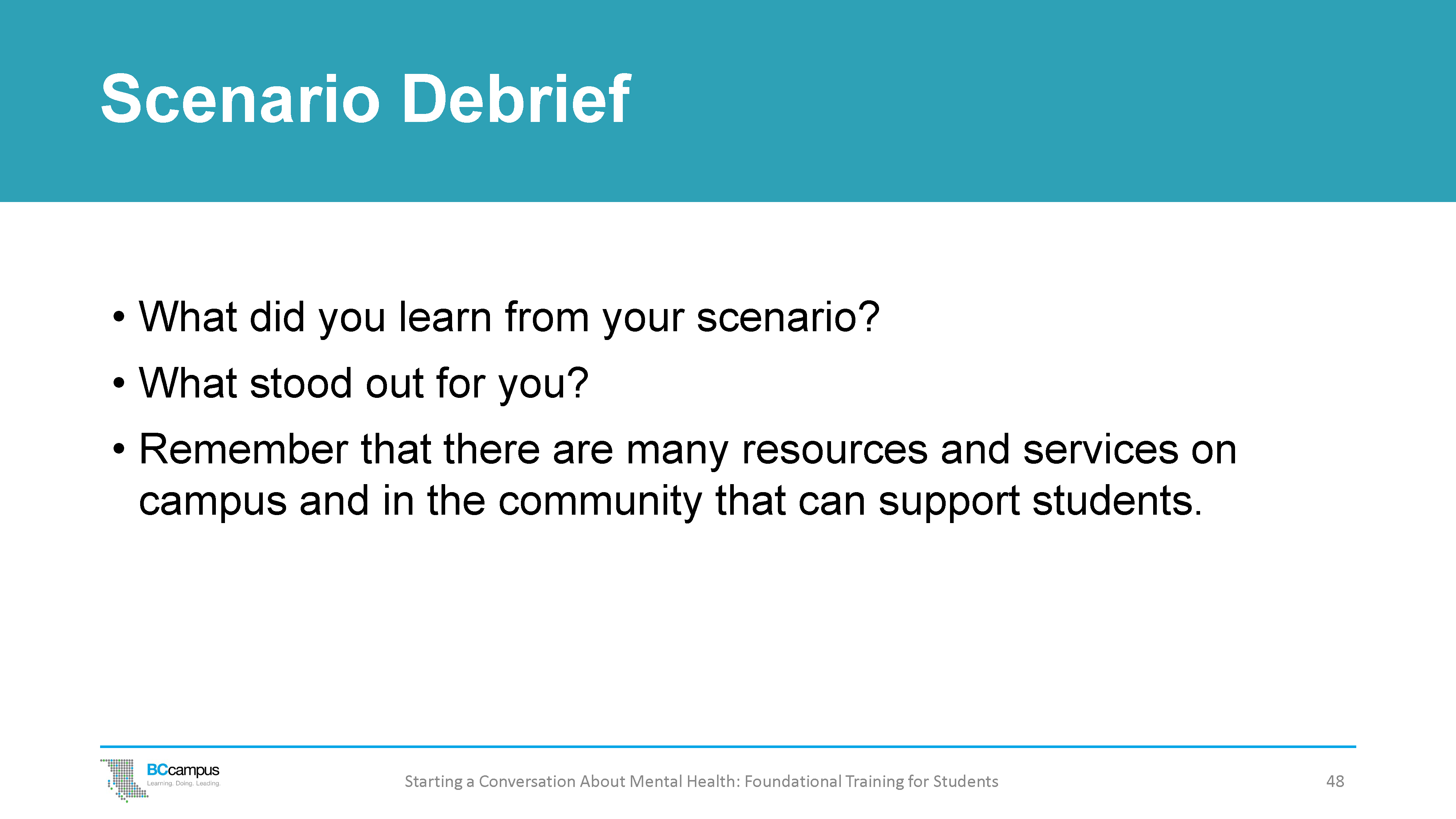
After students have completed the practice scenario activity, invite them to share what they learned. Some of the scenarios are about serious issues or situations that some students may not be familiar with. Remind students there are many resources on campus and in the community that can help students. They are not expected to have all the answers or know what to do in all situations. If you haven’t already shared Handout 4: Talking about Mental Health: Scenarios and Responses with participants, you could share it now.
An interactive H5P element has been excluded from this version of the text. You can view it online here:
https://opentextbc.ca/studentmentalhealth/?p=105#h5p-13
These slides are available for use with this section of the presentation. For information about downloading the slide deck, see the Introduction.
To close the session, review the Mental Health Continuum, the Wellness Wheel, and the Stress Curve.
If you haven’t already, you may want to share Handout 5: Videos and Other Resources on Mental Health and hand out or share the links to any other handouts you haven’t yet shared.
Review everything you’ve talked about: how to respond to stress, how to respond empathetically to another student experiencing stress (while considering your own limits and a balance of care and respect), and the various services and resources available on your campus to support students.
Invite questions and comments and offer to stay after the session for anyone who has questions.
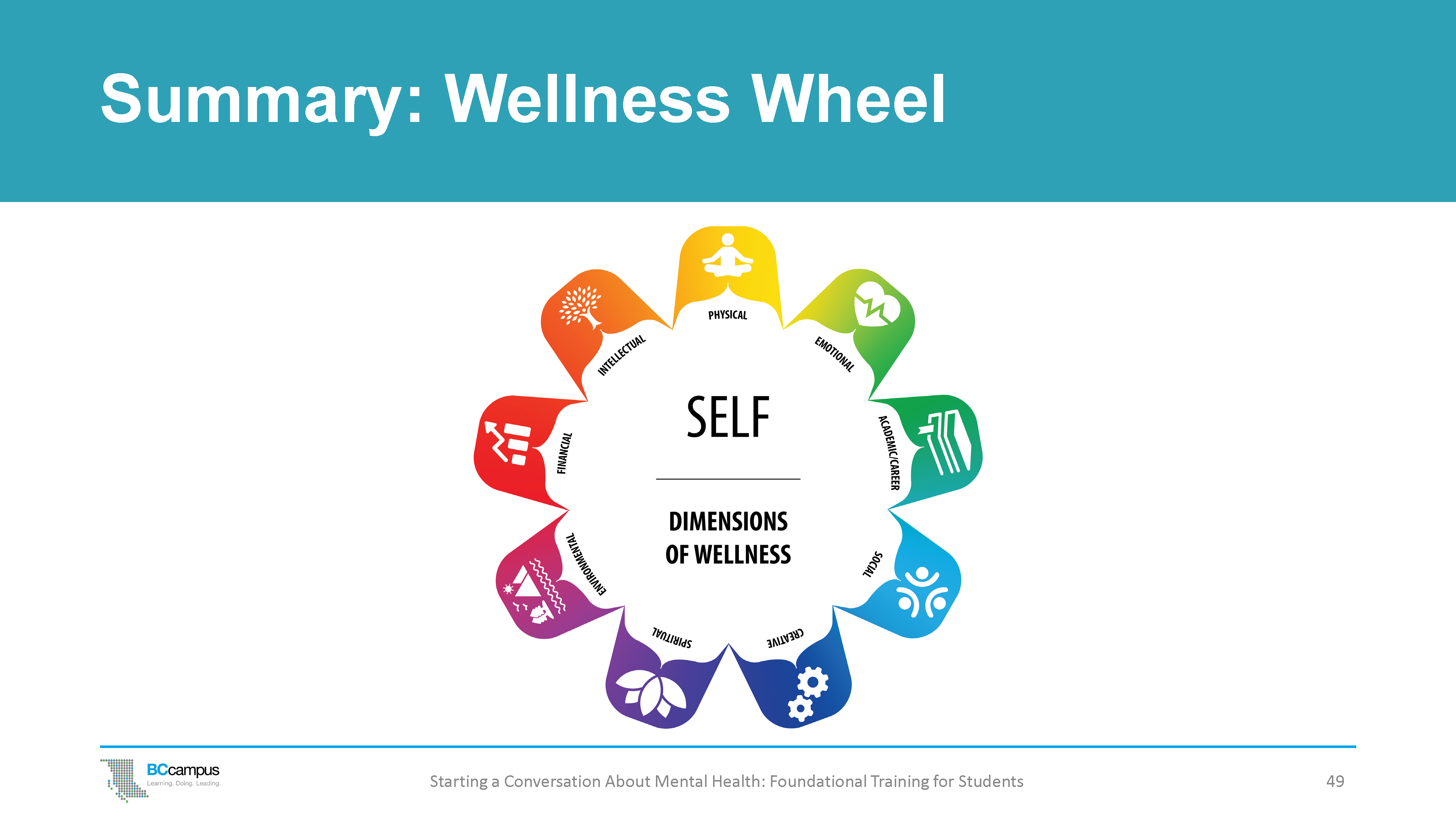
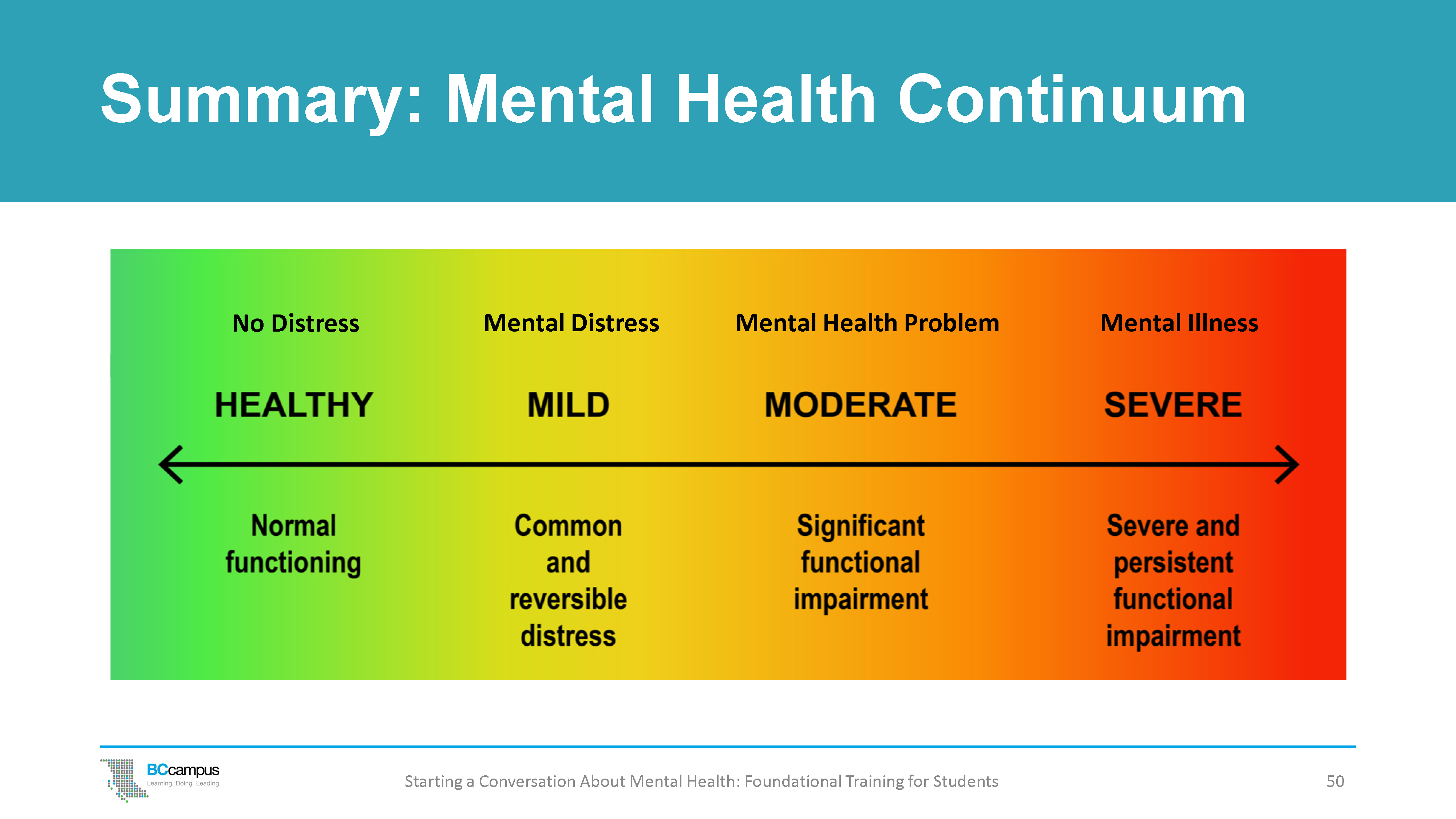
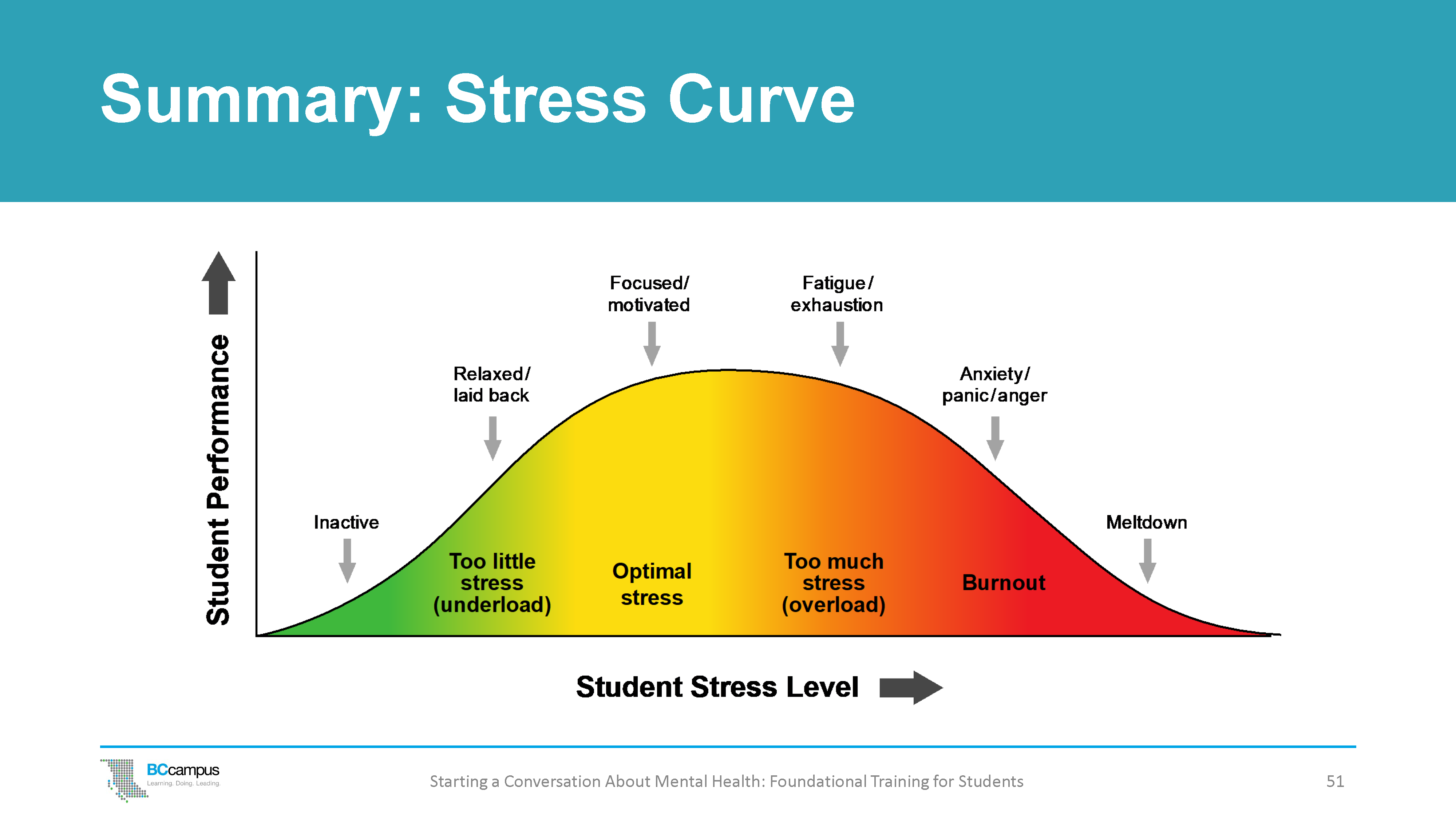
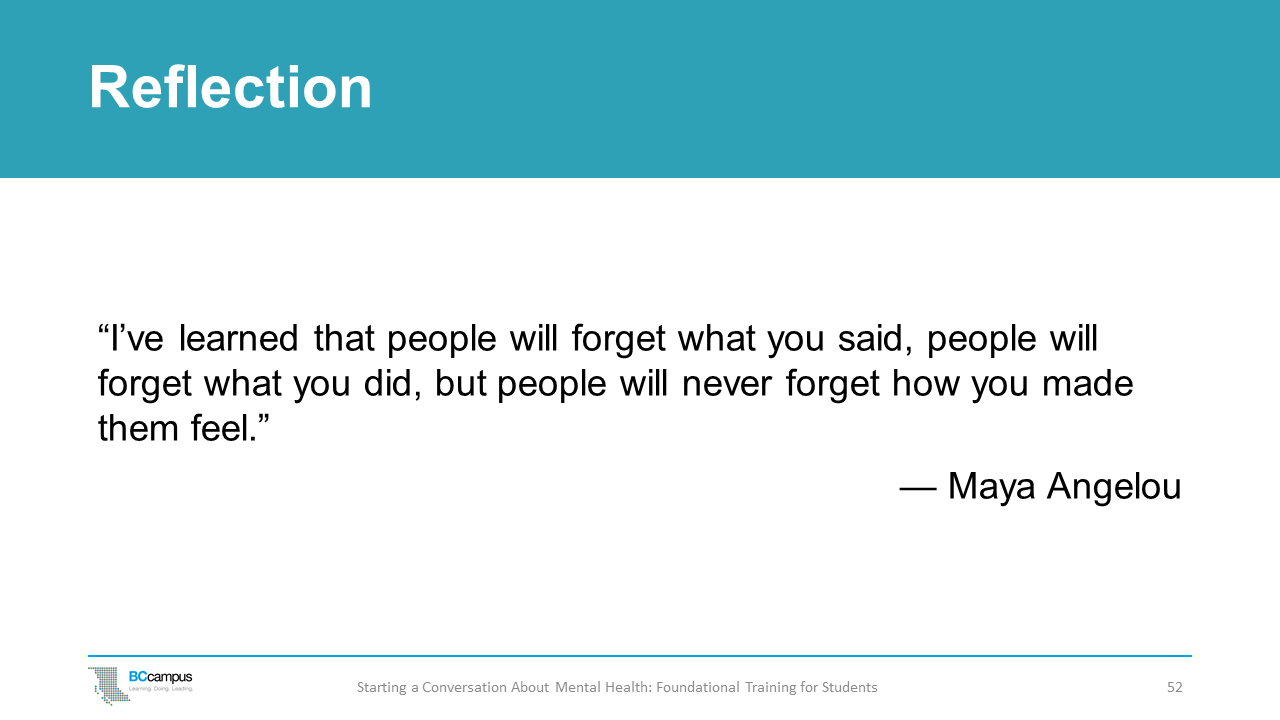
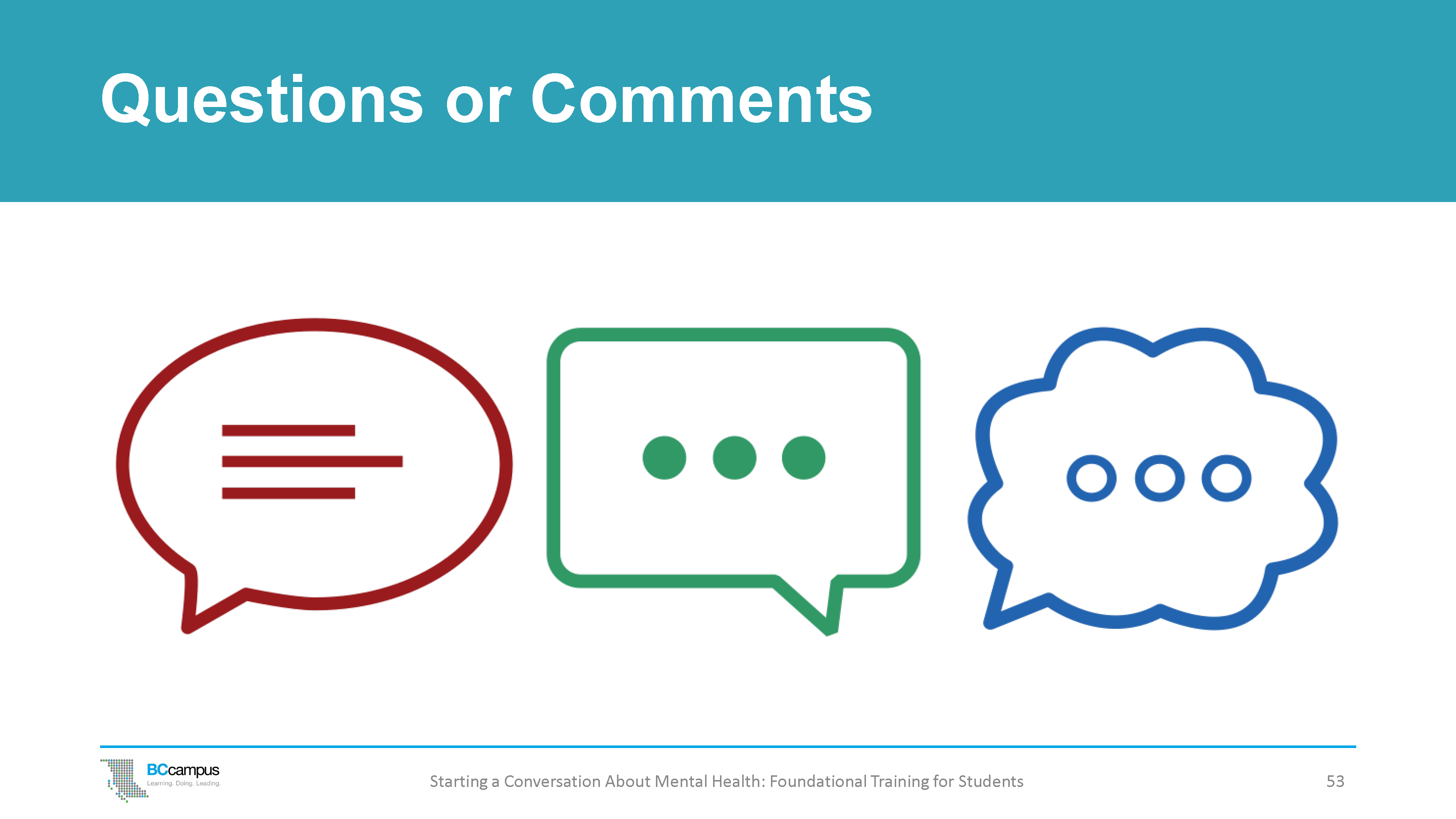
Handout 1 is a two-page PDF of a Wellness Wheel worksheet that shows the Wellness Wheel and gives descriptions and examples of the nine dimension of wellness.
Download Handout 1: Wellness Wheel Worksheet:
Physical wellness: Taking care of your body through physical activity, nutrition, sleep, and mental well-being. For example:
Emotional wellness: Making time to relax, reduce stress, and take care of yourself. Paying attention to both positive and negative feelings and understanding how to handle these emotions. For example:
Academic/career wellness: Expanding your knowledge and creating strategies to support continued learning. For example:
Social wellness: Taking care of your relationships and society by building healthy, nurturing, and supportive relationships and fostering a genuine connection with those around you. For example:
Creative wellness: Valuing and actively participating in arts and cultural experiences as a means to understand and appreciate the surrounding world. For example:
Spiritual wellness: Taking care of your values and beliefs and creating purpose in your life. For example:
Environmental wellness: Taking care of what is around you. Living in harmony with the Earth by taking action to protect it and respecting nature and all species. For example:
Financial wellness: Learning how to successfully manage finances to be financially responsible and independent. For example:
Intellectual wellness: Being open to exploring new concepts, gaining new skills, and seeking creative and stimulating activities. For example:
Handout 2 outlines different ways that students can cope with stress.
Download Handout 2: Coping Strategies [PDF].
The stress response is your body’s way of letting you know that you need to adapt to changes in your environment. Learning how to effectively manage the stress response can help you build resilience. Here are some strategies that can help you improve your mood and your ability to solve problems.
Consider your thoughts, emotions, behaviours, and physical symptoms.
Address the stress response:
For example:
There are also things you can do on a daily basis to help you feel ready to face the various challenges in school, work, and life:
Take care of the basics:
Make time to unwind:
Stay connected or get involved:
Reduce your stress response in the moment:
Try this box breathing technique. It can help bring your heart rate back to normal, so you feel a little more relaxed. Here’s how you do it:
If possible, sit and close your eyes. If not, just focus on your breathing.
Repeat this process as many times as you can. Even 30 seconds of deep breathing will help you feel more relaxed and in control.
Practising mindfulness can also reduce the stress response. Apps such as Headspace, Calm, and Insight Timer provide guided or unguided mindfulness options.
What are two strategies would you like to try?
Handout 3 is a quick reference guide of mental health resources. The handout provides space for facilitators or participants to fill out the contact information for on-campus and community resources and lists provincial crisis lines. The handout also includes information on how to respond to a student who is in distress and refer them to the appropriate resources.
Download Handout 3: Supporting Other Students: Mental Health Resources [PDF].
The stress of post-secondary education is felt by all students at some point, and it can be overwhelming for some. You may have the opportunity to support other students who are struggling with issues that affect their mental health and well-being. This handout provides tips on how to respond to a student in distress and refer them for further assistance through counselling services or other appropriate resources.
Campus Security:
Counselling Services:
Indigenous Services:
International Student Services:
Accessibility Services:
Student Services:
Pride Centre:
Health Services
Financial Aid:
Sexualized Violence Support:
Equity and Human Rights:
If it’s an emergency, call 911 and then contact campus security (if the student is on campus). If the student is not on campus, call 911 and tell the operator the student’s current location as soon as possible.
If you or someone you know needs immediate help, call one of the numbers below:
“I noticed you were tearful in class today.”
“Is everything okay?”
“Is there something I can do to help you?”
Acknowledge the other student’s thoughts and feelings in a compassionate way.
Offer support and reassurance that you want to help.
“It sounds like you’re feeling overwhelmed.”
“Would you like me to help you connect with resources on campus?”
“Would you like to call together and book an appointment?”
“Counselling services provides confidential help.”
“Would you like me to walk with you to the support services?”
Accessing services is voluntary, unless the situation is urgent and the student is not safe on their own.
Is anyone at risk of immediate harm? If yes, call 911 and then call campus security.
If there is no risk of harm, ultimately it is the individual’s right to choose whether to seek help. Individuals are resilient and often come to their own solutions.
Most of the time you will be able to assist another overwhelmed distressed student on your own by simply listening.
Sometimes, however, you may realize that another student may need more support than you can give them. It is important to remember that you are not a counsellor and you should never attempt to diagnose another person’s mental health. You can, however, encourage the student to talk to a counsellor.
You can consult with campus counsellors, support services, or faculty and staff if you’re unsure about how to handle a situation. You can also call a crisis line if you have serious concerns about a student.
You are encouraged to consult when:
Trust your instincts and respond if another student leaves you feeling worried, alarmed, or threatened. If you are unsure, consult. Once the student is supported, ensure that you are supported, too, while maintaining the confidentiality of the student. Talk to friends, family, Elders, colleagues.
Handout 4 includes 11 different scenarios of students who are experiencing stress. Each scenario has a suggested script for how to respond to the student and refer them to resources. Participants can use this handout for the scenario activity during the session, or they can refer to the scripts for further thought and discussion after the session.
Download Handout 4.1 Scenarios for Practice and Discussion (no responses) [Word doc].
Download Handout 4: Talking about Mental Health: Scenarios and Responses [PDF].
The following 11 scenarios offer suggestions on how to respond to students who are overwhelmed and feeling distressed. Use these scenarios as starting points for discussions and continued thought about how we can respond with empathy to students while recognizing and honouring their strengths and capacity to achieve balance.
Alex is a single parent who is going to school full-time and is unable to find reliable daycare. The daycare on campus is full and Alex is on a waitlist; all the other community daycares are also full. Alex’s daughter, Gemma, is a toddler, and Alex is wary of leaving her with a stranger. Alex has no family in the area, and friends are unable to help as they either work or go to school themselves. With final exams coming up, Alex is having trouble finding time to study and feels options are extremely limited or non-existent. Alex tells you they have been trying to study while Gemma sleeps but cannot keep it up for much longer because they are feeling so sleep deprived. Alex looks unkempt and has dark circles under their eyes; they look like they are about to cry and seem very stressed.
I can see you really care about your daughter and how important it is to ensure she is safe and well-cared for. I also see how hard you are working to do well by studying while she is sleeping. I admire and respect you for putting yourself through school while raising a child. Is there anything I can do for you right now that would ease your stress? (You could suggest a beverage or food or a walk or even a shower if they seem a little lost or unsure. Sometimes parents are so focused on their children, they forget their own basic needs, and taking care of some of them can help them focus and feel more grounded.)
I know it may feel like you are out of options, but perhaps we can figure this out together.
We can contact student services on campus. They may have a list of caregivers for this specific reason or resources/referrals for parents. We can also try Facebook and ask the community if they know of any reputable caregivers that have space for your daughter.
Perhaps it would be a good idea to speak to your instructors so they’re aware of everything that you’re juggling. They may be able to give you more time for assignments or may have resources or ideas you haven’t thought of yet.
© Dagmar Devine (CC BY 4.0 License)
You have been paired up with Leslie on a semester-long project in one of your classes. Leslie is upfront about being genderqueer and asks you to use the pronouns they/them. Leslie is enthusiastic, shows up to all the meetings, and completes their portion of the work on time. However, as the semester progresses, Leslie begins missing meetings, is harder to get hold of, and is either late with their contributions or the work is subpar compared with their earlier submissions. When you ask if everything is okay, Leslie admits they are going through a bad breakup and is having a hard time handling it. They are having difficulty concentrating on their work, they aren’t sleeping well, and they are drinking a little more than usual. Leslie tells you they are thinking about dropping out and don’t know what to do.
I’m sorry to hear about your breakup with your partner. In my time working with you on this project, you have been diligent, hardworking, and enthusiastic. I can see your situation is causing you a lot of stress and sadness and distracting you from your studies. Have you spoken to anyone about this? Do you have support at home or with friends or family? The school has some excellent LGTBQ+-friendly counselling services you can access as well. Maybe it would help to talk to someone about what you are going through?
I know you’re having a really hard time and I commend you on continuing to show up and trying the best you can; it’s a testament to your resilience. Although we do need to complete our project, I’m flexible in how we continue with it. Is there anything we can change to ease some of your stress, such as working on it together instead of separating the work and then meeting?
© Dagmar Devine (CC BY 4.0 License)
You are in class when the instructor begins talking about Canada’s residential school system and the abuse and forced assimilation of Indigenous children. As the lesson closes and students begin to pack up, you notice that a usually gregarious Indigenous student is sitting quietly and appears to be wiping tears from their eyes. When you approach the student, they tell you that their grandmother was in a residential school and they found the lesson very triggering.
Thank you for sharing that with me. I noticed you were tearful, and I’m very sorry that you’re upset. I won’t pretend to know exactly how you’re feeling, but I understand there is intergenerational trauma related to the residential school system. If you feel comfortable, please tell me more about how you’re feeling and how you’ve been affected.
Can I assist you in accessing Indigenous services? There are staff on campus who can connect you with Indigenous Elders and counsellors. If you’d like, I can also talk to the instructor about providing trigger warnings on content like this in the future, or I can support you in contacting the instructor.
© Jenny Guild (CC BY 4.0 License)
You are part of a study group that has been meeting regularly through the semester. Recently, one member’s attendance has become sporadic. When they do show up, their appearance is dishevelled, and they seem to have a hard time concentrating. When you ask them about this, they confide that they have been evicted from their apartment and must live in their car for a few weeks until they can afford a deposit on a new place. They explain that it’s hard to find a quiet and comfortable place to study or sleep, and their coursework has suffered as a result. They also tell you that they feel a lot of stress and shame about the situation.
You have nothing to be ashamed of; many of us have gone through financial hardships through no fault of our own. I understand it must be a stressful situation, and I will respect your privacy. Can I connect you with some services that might help you at this time? Financial aid has scholarships, bursaries, and assistance programs that could help you financially. There are food bank programs and shelters in the community. A counsellor could help you deal with the stress. And if you need a quiet place to study, there is always the library and campus study spaces. I can show you these spaces and support you in accessing these resources.
© Jenny Guild (CC BY 4.0 License)
Alexa, a transgender student, approaches you after a LGBTQ2S+ meetup on campus. She tells you that one of her instructors refuses to call her by her name, stating that “preferred names” are optional as per school policy. Occasionally, the instructor will use Alexa’s name, but will self-edit it; for example, calling her “Alex” instead of “Alexa.” The student feels disrespected and humiliated by her instructor during class, so if she does attend class she sits in the back and doesn’t participate very much. She explains to you that she needs to do well in the course so she can get into the program she wants. She expresses feelings of sadness, hopelessness, and frustration during this interaction.
Thank you for sharing your story with me. I’m sorry this happened to you. It must be so frustrating for your instructor to not understand trans reality. I can appreciate how your instructor’s behaviour is impacting your well-being. You are valued, and there are many people and services that can support you through this.
How can I help? I hear that you’re feeling sad and hopeless, and I’m concerned. Would you like to talk to a counsellor on campus? Counselling is confidential and free for students. I can walk with you to counselling services if you like, or I can give you their location and contact information. Another option is I could help you connect with the pride centre. They have free short-term counselling as well as sliding-scale or low-cost long-term counselling services. I can also give you the online crisis resources so you can access them if and when you’re ready. Is that okay with you?
If you like, we can also speak to the student union on campus to discuss mediation if you want to talk to the instructor or the director of the department about this. I can walk with you to the student union, or I can give you their location and contact information. I can also be present to support you throughout this process as well.
© Arica Hsu (CC BY 4.0 License)
Resources for Supporting LGBTQ2S+ Students
When speaking to a transgender student, use the name of the student:
Use a transgender or non-binary student’s appropriate pronoun:
Online Resources
Here are some helpful online LGBTQ2S+ resources on language:
Your classmate usually sits at the very back of your engineering class and keeps to themselves. Today they arrive late, and you notice them taking one of the remaining seats at the busy centre of the lecture hall. Other classmates are engaged in loud conversations with one another. Your classmate appears to become anxious. You notice them frantically shuffling their body. As additional classmates fill up the remaining seats, your classmate hastily grabs their belongings and runs out of the class, sweating profusely. You decide to follow them out of class to see how they’re doing. When you talk to them, they tell you that they were just anxious and needed to get out of the room to relax.
I noticed that you had an uncomfortable reaction in class and left class earlier. Are you doing okay? I just wanted to check because I know I sometimes feel overwhelmed during class. I know there can be all sorts of pressure, and I’m here if you want to talk about anything. How about we try and sit together next class? I can save you a seat.
Note: If the student says they’re fine and they don’t share anything else with you, that’s okay. They now know that someone else cares about their well-being and you’re available if they want to talk. If the student indicates that they’re feeling like they can’t cope with all the pressure or says anything that concerns you, you could suggest they connect with student services to find out about the resources that are available on campus to support students and help them learn coping strategies for dealing with all the stresses of being a student. You could also offer to walk over to student services with them, but you should take your cue from them.
© Hamza Islam (CC BY 4.0 License)
An international student you know from classes is not able to pay all their fees for the semester. The student tells you that they didn’t get any kind of financial aid. They discussed their situation with their parents, but they are not able to send money because their business was shut down during the pandemic. The student is really upset and appears to be on the verge of tears when they talk to you. They are worried they’ll have to drop out and say they feel helpless and very stressed.
I’m sorry to hear that you are having such a difficult time. I can understand that this is very stressful and heartbreaking for you. Did you know there are a lot of really helpful services right here on campus? You could also talk to someone in international student services to see if they have any suggestions. And there’s also the financial aid office on campus, and they may be able to suggest bursaries or loans. The health and wellness centre has staff and counsellors who can help you if you are feeling stressed and low. There’s also the food bank, which provides free food to students in need. I can help you connect with all of these services if you’d like.
© Mehakpreet Kaur (CC BY 4.0 License)
Salem arrived in Canada three months ago and is struggling with absorbing school material in English. Salem has to work after classes to support their family, so there is no time for extra tutoring or study club. Because of late-night shifts, they are having trouble keeping a consistent sleep schedule and preparing meals for the week. Salem explains to you that they have a midterm exam coming up. Salem discloses to you that in their culture, grades play a large role in defining one’s self-worth and social status—and this exam is no exception. They are visibly distressed, their eyes swollen with dark circles underneath, and they mention their lack of appetite and lack of communication with their loved ones.
I’m so sorry to hear about what you are going through. Your feelings and concerns are valid and deserve to be heard. I can’t imagine how challenging it must be to navigate school, work, and personal life in a foreign environment, far from home and family. I admire your resilience and perseverance in this difficult situation and appreciate you opening up to me about your experiences. You are not alone, and we are here to support you.
How can I help? Do you need a listening ear or support with brainstorming options? I’d be happy to help you navigate the many student services on campus. Have you spoken to anyone at international student services or financial aid? They may be able to help. Have you contacted your instructor? There are ways to make a request for an extension on assignments. Would you like assistance with that or help with putting together a study plan? We can also look into local food banks and bursaries together, to free up your time to allow for more rest and studying.
When was the last time you connected with family and friends? They care about you and your health; we can call them together if that would help. Your academic performance does not define your worth; there is so much more to you as an individual.
© Malena Mokhovikova (CC BY 4.0 License)
Cobie is the first member of their family to attend a post-secondary program, and their parents and grandparents have invested most of their money in their education. Cobie has come up to you, as a teacher’s assistant, in a panicked way after class. They explain that they just got their mark back for an assignment, and they failed it and are unable to improve their mark. They will likely fail the class because of how much the paper was worth. The student is clearly panicking, and is displaying frantic behaviours like pacing, speaking rapidly, and fidgeting with their hands, and is on the verge of crying. They say that they feel guilty for wasting their parents’ and grandparents’ money and are embarrassed to tell them that they failed on the paper. They say they feel helpless and stuck, with no way out of the situation.
This sounds really challenging, and I’m so sorry that you are going through this tough time right now. It must be really hard and upsetting to have worked so hard on a project and not got the mark you wanted. Your parents and grandparents care about you; that’s why they have helped you with school. You are a hardworking student and this one grade does not define you.
I suggest you first talk to your instructor and see if they’re open to you rewriting your assignment. If that’s an option, you could get extra support from the learning centre. If redoing your assignment isn’t possible, there is the option of taking the class again or taking a different class that you might be more interested in. I’m here for you, and you can come to me to talk. If you’re feeling really overwhelmed by this, there are also counselling services on campus, and I can recommend a counsellor who can help you through this tough time. Would you like me to help you connect with counselling services?
© Jackson Mackenzie Nicholls (CC BY 4.0 License)
Your friend Blue, who is recovering from an eating disorder, just ran out of class because of triggering course content. Blue is non-binary, queer, bi-racial, and neurodivergent. In class, the instructor was discussing nutrition, body image, and healthy eating when they made an implicitly offensive comment about weight and body mass index. This triggered Blue, causing them to run out of the classroom. You also leave class to check on them, and you find them pacing up and down the hallway, scratching their arms, and tugging at their shirt to pull it away from their body.
I noticed that you ran out of the class after the instructor made that insensitive comment. Do you want to talk about how you’re feeling, or do you need time for yourself? I know you’re recovering from an eating disorder and hearing your instructor make a comment like that must be extremely upsetting. I can see that you’re distressed by the way you’re scratching yourself. I know the student hub has a quiet space that we can go to if you think that would help; I can walk you there now. After you feel more grounded, do you want to talk to someone? There’s counselling at the school and peer support, but if you don’t feel comfortable discussing the matter here, there’s Here2Help.ca, which is an online chat or text resource.
© Calla Smith (CC BY 4.0 License)
A student shows up to class after not coming for a couple of weeks. As everyone is packing up their bags at the end of class, you approach the student, who looks tired, is not wearing appropriate clothing for the cold weather outside, and looks like they may not have showered in a while. After talking privately with you in the empty classroom for a few minutes, the student discloses that they are hungover from a weekend of drinking. The student is clammy, sweaty, and breathing quickly. The student continues to tell you that they don’t want to be in school, but they’re under a lot of pressure from their family to be there. The student tells you that the only part of school they enjoy is the social aspect.
Hey, I haven’t seen you in a while and I just want to check in on you. Is everything going okay? I see you don’t have a jacket, and it’s pretty cold outside. Do you want to see if the lost and found has anything that hasn’t been claimed in a while? I understand not wanting to come to class; it is a lot of pressure. The social life is exciting and new, and it’s a chance to feel free and be your own person. Do you have any ways to balance the social and work aspect of school? Do you have anyone to talk to about school and life? It could be really helpful to talk to someone, and here are some good resources here on campus. There are counsellors who are there if you need to talk about the pressure you’re feeling from your family; they can also give you some advice on balancing the work and social aspects of school. Would you like me to help you connect with them? I understand that you’re hungover now, but you could go whenever you’re ready. Is it okay if I reach out if I don’t see you in class next week?
© Calla Smith (CC BY 4.0 License)
For students wanting more information on mental health, you can share this handout, which includes videos, websites, and articles on mental health.
Download Handout 5: Videos and Other Resources on Mental Health [PDF].
This handout includes more videos and other resources on mental health that may be of interest.
How to make stress your friend (14:28 min.)
– Ted Talk by Kelly McGonigal on the many advantages of stress.
The mental health literacy pyramid (9:28), Mental Health Collaborative
– Provides an overview of the Mental Health Literacy Framework and the different mental health states.
Why stress is good for you (Instant Egghead #40; 2:32), Scientific American
– Explains how stress can be viewed as helpful.
Comninos, A. (n.d.). Stress. Mindfulness and Clinical Psychology Solutions.
– Web article on the stress curve, different types of stress, and how to cope and manage stress.
Kutcher, S., & Wei, Y. (2020). School mental health: A necessary component of youth mental health policy and plans. World Psychiatry, 19(2).
– Article on mental health literacy.
Ohrnberger, J., Fichera, E., & Sutton, M. (2017, December). The relationship between physical and mental health: A mediation analysis. Social Science and Medicine, 195, 42–49
– Article on the connection between physical and mental health.
TeenMentalHealth.org. (n.d.). How not to bubble wrap kids: Learning how to use daily stress to develop resilience.
– Information sheet on using daily stress to develop resilience.
Dagmar Devine, University of Victoria
Jewell Gillies, Okanagan College
Jenny Guild, Langara College
Arica Hsu, Langara College
Hamza Islam, University of British Columbia
Barbara Johnston, West Coast Editorial Associates
Mehakpreet Kaur, College of New Caledonia
Jackson Mackenzie Nicholls, Thompson Rivers University
Malena Mokhovikova, University of Victoria
Calla Smith, Langara College
Liz Warwick, Limestone Learning
We gratefully acknowledge that this facilitator’s guide and the associated presentation have been adapted from University of British Columbia’s training Mental Health Literacy for Student Leaders by University of British Columbia (UBC) Student Health and Wellbeing staff. While we don’t have the names of all of the authors who contributed to the UBC resource over the years, we would like to thank those people who worked with BCcampus on this newly adapted version: Tam Uden, Freeman Woolnough, Karen Moss, Kelly White, Patty Hambler, and Levonne Abshire.
Susan Butland, Thompson Rivers University
Rafael de la Pena, College of New Caledonia
Jagjeet Gill, Langara College
Michelle Glubke, BCcampus
Matty Hillman, Selkirk College
Sara LaMarre, Vancouver Island University
Rhonda Schmitz, Selkirk College
Kaitlyn Zheng, BCcampus
Susan Butland, Thompson Rivers University
Rafael de la Pena, College of New Caledonia
Jagjeet Gill, Langara College
Patty Hambler, Douglas College
Claire Hewson, Selkirk College
Evan Hilchey, Camosun College
Sara LaMarre, Vancouver Island University
Shelley McKenzie, University of Northern British Columbia
Tanya Miller, Langara College
Romana Pasca, College of New Caledonia
Amy Rowes, North Island College
Dawn Schell, University of Victoria
Rhonda Schmitz, Selkirk College
Lisa Sookochoff, Okanagan College
Grace Dupasquier, Alliance of B.C Students
Carol Johnston, University of Northern British Columbia
Tanysha Klassen, British Columbia Federation of Students
Sarthak Tembhekar, North Island College
Andrei Bondoreff, senior policy analyst
Kelly Chirhart, director
Valerie Cross, director
Michelle Glubke, project manager
Declan Robinson Spence, project assistant
BCcampus is grateful to the eight post-secondary students who completed this training, wrote the practice scenarios, and offered feedback.
Dagmar Devine is a student at the University of Victoria, completing her bachelor’s degree in social work through distance learning and living in the beautiful West Kootenays, in the unceded territory of the Syilx, Sinixt, and Ktunaxa, with her husband and four of her five children. She is passionate about destigmatizing mental illness and normalizing open conversations around mental health and well-being.
Jenny Guild is a Métis woman living and working in Vancouver on the unceded territories of the xʷməθkʷəy̓əm (Musqueam), Sḵwx̱wú7mesh (Squamish), and Stó:lō and Səl̓ílwətaʔ/Selilwitulh (Tsleil-Waututh) Nations. She is a library and information technology student at Langara College with a passion for psychology and literature, who hopes to one day provide library programming to children and marginalized groups.
Arica Hsu is studying to complete her bachelor of science in nursing. As a trans woman of colour, Arica’s lived experiences have given her insight into how the education and health care systems (including the health care professionals it produces) can be improved to better help, support, and protect her people and community. In addition to volunteering for various social and advocacy committees, she mentors other nursing students. Arica’s career goal is to eliminate barriers that prevent queer and other under-represented people from accessing culturally safe care and succeeding in society.
Hamza Islam is in his second year studying engineering at University of British Columbia. He has yet to declare a major, but is interested in computer engineering. Prior to engineering, Hamza worked as a community support worker—starting off as an intern, working with mentally disabled individuals in a community outreach program. Having completed certifications in the Mandt System, Person Centered Thinking, and Mental Health First Aid, Hamza hopes to bring his mental health experience to the private sector.
Mehakpreet Kaur is the women’s representative and treasurer at College of New Caledonia Student Union, Prince George. She is originally from India and is completing the kinesiology program at the College of New Caledonia. Mehakpreet lost her dad in 2019, which was the worst thing to happen to her, as he was her biggest supporter. She came to Canada to pursue higher education and fulfill her and her dad’s dreams. With the definitive goal of becoming a physiotherapist, she is working hard to become an outstanding and successful woman.
Jackson Mackenzie Nicholls is an undergraduate student in psychology at Thompson Rivers University and lives in the beautiful Okanagan, in the traditional unceded territory of the Syilx tmixʷ Nation. Jackson’s main interests lie within social psychology and the study of mental disorders.
Malena Mokhovikova came to Vancouver as a refugee from Russia in 2012 as a result of racism, discrimination, and fear of prosecution. She studies psychology at the University of Victoria and loves to write, travel, and hike in her free time. She is an active advocate for mental health destigmatization and studies toward one day becoming a clinician and supporting others overcoming trauma.
Calla Smith is studying kinesiology and is interested in sports psychology. She is privileged to live, work, and play on the traditional unceded territories of the xʷməθkʷəy̓əm (Musqueam), Sḵwx̱wú7mesh (Squamish), and Sel̓íl̓witulh (Tsleil-Waututh) Nations with her dog and family. Calla loves road cycling and trying new foods.
American College Health Association. (2019). American College Health Association-National College Health Assessment II: Canadian reference group, executive summary, spring 2019. American College Health Association.
Antoine, A., Mason, R., Mason, R., Palahicky, S., & Rodriguez, C. (2018). Pulling together: A guide for Indigenization of post-secondary institutions. A professional learning series. https://opentextbc.ca/indigenizationcurriculumdevelopers/
Armstrong, G., Daoust, M., Gil, Y., Seinen, A., & Shedletzky, F. (n.d.) Capacity to connect: Supporting students from distress to suicide. Vancouver Island University. https://services.viu.ca/sites/default/files/viu-capacity-to-connect-supporting-students-in-distress.pdf
Cairns, S. L., Massfeller, H. F., & Deeth, S. C. (2009). Why do post-secondary students seek counselling? Canadian Journal of Counselling and Psychotherapy, 44(1), Article 58896.
Canadian Alliance of Student Associations. (2020, June 15). Students are still worried: COVID-19 and post-secondary education. https://www.casa-acae.com/students_are_still_worried_covid19
Canadian Association for Suicide Prevention. (n.d.). I’m concerned about someone. https://suicideprevention.ca/im-concerned-about-someone
Canadian Psychological Association. (2006). Out of the shadows at last: Transforming mental health, mental illness and addiction services in Canada – A review of the final report of the Standing Senate Committee on Social Affairs, Science and Technology. https://cpa.ca/cpasite/UserFiles/Documents/Practice_Page/OutoftheShadowsatLast_CPAReview%20.pdf
Centre for Suicide Prevention. (n.d.). Sexual minorities and suicide prevention. https://www.suicideinfo.ca/resource/sexual-minorities-suicide-prevention/
Comninos, A. (n.d.) Stress. Mindfulness and Clinical Psychology Solutions. https://mi-psych.com.au/what-is-stress/
First Nations Health Authority. (n.d.). First Nations perspectives on health and wellness. https://www.fnha.ca/wellness/wellness-and-the-first-nations-health-authority/first-nations-perspective-on-wellness
Hyde, H. (2011). Identifying and referring students in difficulty. BCIT Counselling Services. https://www.bcit.ca/files/counselling/pdf/identifying_and_referring_students_in_difficulty.pdf
Kutcher, S., & Wei, Y. (2020). School mental health: A necessary component of youth mental health policy and plans. World Psychiatry, 19(2). https://doi.org/10.1002/wps.20732
Little Bear, L. (2009). Naturalizing Indigenous knowledge: Synthesis paper. Canadian Council on Learning. https://www.afn.ca/uploads/files/education/21._2009_july_ccl-alkc_leroy_littlebear_naturalizing_indigenous_knowledge-report.pdf
Mental Health and Wellness Advisory Groups. (2020). Framework for evaluating mental health and wellness education and training resources. BCcampus. https://opentextbc.ca/mhwframework/
Mental Health Commission of Canada. (2012). Changing directions, changing lives: The mental health strategy for Canada. https://www.mentalhealthcommission.ca/wp-content/uploads/drupal/MHStrategy_Strategy_ENG.pdf
Moore, K. (2019). Mental Health Collaborative Project: Student resilience and coping workshops. Environmental scan summary. BCcampus. https://bccampus.ca/wp-content/uploads/2020/06/Student-Report.pdf
Ohrnberger, J., Fichera, E., & Sutton, M. (2017, December). The relationship between physical and mental health: A mediation analysis. Social Science and Medicine, 195, 42–49. https://www.sciencedirect.com/science/article/pii/S0277953617306639
Okanagan College. (n.d.). Wellness peer ambassador handbook.
Public Health Agency of Canada. (n.d.). Mental health and wellness. https://cbpp-pcpe.phac-aspc.gc.ca/public-health-topics/mental-health-and-wellness
Queen’s University. (2012). Report of the principal’s commission on mental health. https://www.queensu.ca/principal/sites/webpublish.queensu.ca.opvcwww/files/files/CMHFinalReport.pdf
Schell, D. (n.d.). Facilitator’s guide: Student mental health literacy, levels one and two. University of Victoria.
Seibel, D. K., Katsamakis, A., Stuart, A., Mochizuiki, T., Hagerty, M., & Seibel, L. M. (2020). Final report: Evaluation of resources for mental health and wellness training in the post-secondary context (students, staff, and faculty): Phase one. BCcampus.
Sexual Violence Training Development Team. (2021). Consent and sexualized violence training and facilitator guide: Preventing and responding to sexual violence in B.C. post-secondary institutions. BCcampus. https://opentextbc.ca/svmconsent/
Statistics Canada. (2020, May 27). Canadians’ mental health during the COVID-19 pandemic. The Daily. https://www150.statcan.gc.ca/n1/daily-quotidien/200527/dq200527b-eng.htm
Stephens, T., Dulberg, C., & Joubert, N. (1999). Mental health of the Canadian population: A comprehensive analysis. Chronic Diseases in Canada, 20(3), 118–126.
TeenMentalHealth.org. (n.d.). How not to bubble wrap kids: Learning how to use daily stress to develop resilience. https://mentalhealthliteracy.org/wp-content/uploads/2017/09/Stress-Two-pager.pdf
Turpel-Lafond, M. E. (2020). In plain sight: Addressing Indigenous-specific racism and discrimination in B.C. health care. [data report]. Addressing Racism Review. https://engage.gov.bc.ca/app/uploads/sites/613/2021/02/In-Plain-Sight-Data-Report_Dec2020.pdf1_.pdf
U.S. Global Change Research Program. (2016). The Impacts of Climate Change on Human Health in the United States: A Scientific Assessment. https://health2016.globalchange.gov/
U.S. Office of Disease Prevention and Health Promotion. (n.d.). Healthy people 2020: Lesbian, gay, and transgender health. https://www.healthypeople.gov/2020/topics-objectives/topic/lesbian-gay-bisexual-and-transgender-health
Veltman, A., & La Rose, T. (2019, December 30). LGBTQ mental health: What every clinician needs to know. Psychiatric Times, 36(12), 21–23. https://www.psychiatrictimes.com/view/lgbtq-mental-health-what-every-clinician-needs-know
Waddell, C., McEwan, K., Shepherd, C. A., Offord, D. R., & Hua, J. M. (2005). A public health strategy to improve the mental health of Canadian children. Canadian Journal of Psychiatry. 50(4), 226–233.
Warren Shepell Research Group. (2005). Workplace mental health indicators: An EAP’s perspective. https://www.shepellfgi.com/EN-US/AboutUs/News/Research%20Report/pdf/ir_mentalhealthindicators_enreport.pdf
World Health Organization. Mental health: Strengthening our response. https://www.who.int/news-room/fact-sheets/detail/mental-health-strengthening-our-response
This page provides a record of edits and changes made to this book since its initial publication. Whenever edits or updates are made in the text, we provide a record and description of those changes here. If the change is minor, the version number increases by 0.01. If the edits involve substantial updates, the version number increases to the next full number.
The files posted by this book always reflect the most recent version. If you find an error in this book, please fill out the Report an Error form.
| Version | Date | Change | Details |
|---|---|---|---|
| 1.00 | December 15, 2021 | Book published. |